Australian
and international
exploratory
performance and
media arts
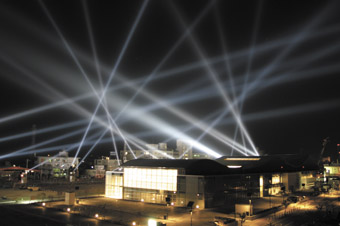
Modal Suspension, Relational Architecture 8, Yamaguchi, Japan, Rafael Lozano-Hemmer. Lozano-Hemmer is one of the subjects of Media City and will be a keynote speaker at the 2009 Adelaide Film Festival
photo by ArchiBIMing
Modal Suspension, Relational Architecture 8, Yamaguchi, Japan, Rafael Lozano-Hemmer. Lozano-Hemmer is one of the subjects of Media City and will be a keynote speaker at the 2009 Adelaide Film Festival
THE MEDIA CITY PROVIDES A SURPRISINGLY COMPREHENSIVE, BEAUTIFULLY-WRITTEN ACCOUNT OF THE TANDEM DEVELOPMENT OF MEDIA AND CITIES. MORE THAN THIS, HOWEVER, THE MEDIA CITY IS A COMPELLING ACCOUNT OF THE VERY CONSTITUTION OF MODERN EXPERIENCE.
McQuire is quick to dismiss the question of media representations of the city, primarily because this question immediately separates media from the rest of life. He is interested instead in media’s interventions in the midst of life, in the production of forms of living, of material becomings.
The “media-architecture complexes” that are central to these material becomings are an increasingly complex mix of “heterogeneous temporalities” and “relational spaces.” During frequent “transitional phases”, the media city is a kind of ongoing experiment in time, space and living.
It is the often forgotten “medium” of electricity, particularly electric light, that made the media city possible in its full form. McQuire gives a wonderful account of the “electrical sublime.” Electric light transforms architectural forms, which become more fluid at the flick of a switch. Material space is blended with the less obviously material. The city itself becomes performative at the same time as cinematic: a dynamic trade of light and shadows. Eventually, William Gibson’s cyberspace of colour and light are to emerge from this. Electricity is a transformer of experience, not just a simple source of energy.
The rest of the book leads into and out of the electrical sublime. Electric light’s concurrent illumination and deformation of the experience of “home” is prefigured, for example, in photography. Photography plays the role of technological memory (often of home), but in part because of the increasing destruction of actual homes and neighbourhoods, as in Haussmann’s reorganisation of Paris. Both photography and the very concept of city-wide organisation increase the abstraction of experience. This makes the likes of advertising and commodification possible, to what are now generic citizens abstracted from a demolished local culture. Relational space becomes more complex. Objects are subordinated to the more abstract relations in which they find themselves. This in turn allows for the further development of media technologies, and the machinic forms of perception they provide, which are meant to visualise the new abstractions of relational space.
The dynamics between media, urban design and experience begin to pre-figure the cinema in the photographic series. Here the series matters more than individual photographs, because it is the series that responds to the question of how one could possibly get an overall view of the new city. Images now begin to form “an information flow in which relations between images assumed heightened importance.” Social and technical life become increasingly subject to these relations, and not just in some high theoretical way. McQuire convincingly maps out the differential force of relations as they are put to work in the actual material constitution of lived, urban experience.
The increased abstraction and complexity of relational spaces in urban life leads to an entire society which “deals less in truth than probability.” Thus the increasing fascination with detective stories and, later, lived experience based upon statistics, risk management, and population-based performance indicators. What McQuire calls the “territory of images” expands: a series of photographic records; postcards; the electrical sublime’s re-image-ing of urban forms; the cinematic attempt to grapple with mobility in a reproduction of the media city’s ongoing temporal shock; even statistics as an attempt to image an otherwise invisible set of events. Meaning itself “becomes a form of ‘sampling’.”
At a certain point the problem becomes the “the liquid city.” Neither fixed architectural forms nor even relatively fixed media assemblages such as the cinema, were quite able to bring the media city to order. Media, architectural forms, social life, even the “self”, all needed to become “liquid” in order to adapt to each other in increasingly relational spaces. The cinematic edit becomes the more liquid “melt of morphing” and “narrative ordering” is submersed in the “viewing of multiple ‘windows’.” The media city, now conforming to the Futurist dream of a city “composed of different intensities”, is made of events flowing in a sea of shifting currents. The resulting disorientation leads both to new, more hierarchical forms of organisation. It also demands better—whether more or less liquid—participatory forms of social organisation.
Throughout, McQuire is just as informed about architecture and the urban as he is about media, from Boccioni and Sant’Elia, through very extensive discussions of Le Corbusier and Archigram, to Frank Gehry, Nicholas Negroponte and Koolhaas.
The final section of the book delivers a stunning account of the extensive use of glass in architecture. Following this, electronic media are not only seen as an extension of the photographic series’ attempt to give abstract coverage to the new dynamics of urban space. They are also an extension of the new dynamism of glass, of the window as the highly ambivalent opening/barrier between private and public.
The digital home emerges from this ambivalence. This in turn allows the rise of reality TV shows such as Big Brother. Here the ongoing and tactical construction of personal agency, along with the ability to command statistical and pseudo-democratic media attention, become a matter of survival. McQuire elegantly terms this the “the farming of emotions”, which starts with the development of public relations and method acting, and ends with Big Brother. In a similar vein, the famous Jennicam becomes a kind of media-city “transitional object”, because we now suffer from the “fear of not being watched.” McQuire nevertheless sees possible value in these new constitutions of experience, even if this might have to be actualised differently from Big Brother.
Packed with stories, events and ideas, and beautifully argued, The Media City is probably the most lucid discussion of media and the constitution of lived experience around.
Scott McQuire, The Media City: Media, Architecture and Urban Space, Sage, London, 2008
Rafael Lozano-Hemmer. Lozano-Hemmer is one of the subjects of Media City and will be a keynote speaker at the 2009 Adelaide Film Festival, see preview.
RealTime issue #88 Dec-Jan 2008 pg. 29
© Andrew Murphie; for permission to reproduce apply to realtime@realtimearts.net
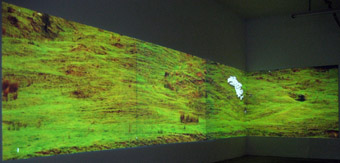
Composition for farmer, three dogs and 120 sheep, 2006, Alex Montieth
photo Somaya Langley
Composition for farmer, three dogs and 120 sheep, 2006, Alex Montieth
A SWELTERING FRIDAY MORNING IN SINGAPORE, AT THE WIND-UP OF THE 2008 INTERNATIONAL SYMPOSIUM ON ELECTRONIC ART (ISEA, DIRECTED BY GUNALAN NADARAJAN), IS WHEN I CHOOSE TO HEAD TOWARDS COOLER GALLERY SPACES. THIS YEAR, AMONGST DOZENS OF ARTISTS PRESENTATIONS, SEVERAL PERFORMANCES, ROUNDTABLE WORKSHOPS, NIGHT-TIME GIGS AND KEYNOTE SPEECHES, THE SYMPOSIUM PLAYED HOST TO FIVE GALLERY EXHIBITIONS. AUSTRALIA AND NEW ZEALAND ARE WELL REPRESENTED BY EXPERIMENTA PLAY++ AND CLOUDLAND: DIGITAL ART FROM AOTEAROA (CURATED BY SU BALLARD, STELLA BRENNAN AND ZITA JOYCE). OTHERS WERE LUCID FIELDS—MEDIA ARTWORKS BY SWISS ARTISTS-IN-LABS, MALAYSIAN DIGITAL ARTS ON DISPLAY IN RELOCATIONS AND THE MAIN ISEA 2008 JURIED EXHIBITION SITUATED INSIDE THE GLARING WHITE EXTERIOR OF THE NATIONAL MUSEUM OF SINGAPORE.
video simplicity
On entering Cloudland I’m mesmerised by Alex Monteith’s Composition for farmer, three dogs and 120 sheep (NZ, 2006) for four-channel video installation. The beauty and simplicity of this work are immediately apparent yet, unlike the majority of video works in gallery spaces, it has me sitting on the floor within minutes, and remaining for over half an hour. As I observe the herd of sheep traverse the wide multi-channel projection—which is angled into a gallery corner—I’m aware that only the barking of the dogs and the sound of the farmer’s whistles accompany this imagery. Such sounds repeated at length, have the potential to annoy, instead here they transport the viewer into a zone—perhaps not directly into the landscape of the work itself—but definitely far away from the gallery walls and the humidity of Singapore lurking outside. This is partly achieved by the decision to project in a wedge configuration, allowing the audience to gain an overall perspective and immerse themselves in the work. Ultimately these choices enhance the captivating nature of this video work.
installation exclusion
At the opposite end of the small gallery space is et al.’s the social meaning of things (NZ, 2008). While Monteith’s Composition for farmer… openly offers a viewing experience, et al.’s work is uninviting, and most likely this is intentional. Caged behind two temporary six-foot wire fences is a mundane scene comprising a white plastic garden chair and a desk with laptop displaying a (seemingly hostile) three-dimensional game environment that is also duplicated on the wall behind. What looks boring becomes captivating the closer you shift towards it. It’s a work very much situated in the context of the political and social critique of border issues and inhumane confinement. It has the potential to draw the audience in, while simultaneously distancing them. But without socio-political reference points the installation and the fences could block the experience entirely.
intimate interfaces
In the even cooler depths of the National Museum of Singapore, the 16 works on display in the ISEA juried exhibition—comprising multiple installations and audio-visual projections—demand more than a single day of viewing. The show is the result of the ISEA 2008 Artist in Residence program, where some 20 artists were based in university laboratories and departments around Singapore in the three-month lead-up to the symposium.
Several works remain prominent in my memory, including Gender Strategies for Loitering (Shilpa Phadke, Shilpa Ranade and Sameera Khan, India, 2008) which focuses on gender inequalities in India and Singapore. In both it is socially acceptable for men to loiter in public space without question, yet respectability is stripped from any woman who chooses to do the same. Also appealing were Momoyo Torimitsu’s Smile, Wear it Like a Costume! (Japan/USA, 2008) based on research into the interpretations of the smile carried out in collaboration with the National University of Singapore Face Group, and Clea T Waite’s The Water Book (An Encyclopedia of Water) (USA/Germany, 2008) with its exquisite water touch interface I mistook for a glass tabletop, almost dropping my camera into the depths. In The Water Book, light projected words appear in the water acting as touchable hotspots for triggering video play back.
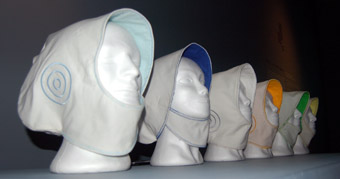
We Hear One Another, 2008, Kelly Jaclynn Andres
photo Somaya Langley
We Hear One Another, 2008, Kelly Jaclynn Andres
Kelly Jaclynn Andres’ Finally, We Hear One Another (Canada, 2008) is a wearable sound-oriented work designed for pairs of participants. With hood-like bonnets, each audience member wishing to take part in the experience partners up, hoods up and is then able to wander through the museum. A cone, containing a microphone, positioned at the back of the bonnet, is used to transmit audio to the other participant, permitting the wearer to experience the sound world of their partner. While conceptually poetic, this work breaks down the moment you are handed a mobile phone to hold during your sonic exploration. Finally, We Hear One Another exposes the difficulty of media art attempting (and rightly so) to reach beyond the typical plastic and metal interfaces we’re so accustomed to having mediate our experience. Once the cover comes off or the tech falls out of its custom-designed pocket, the illusion bursts and we’re often left holding some gadget with a mass of cables attached.
Standing back to watch a couple of young girls explore the space with this wearable work rejuvenated my initial attraction. Positioned in different parts of the gallery, but not too far away from each other, they were asking loudly “can you hear me, can you hear me…”. Taking the work at face value, without filtering it through an analytical framework, their genuine playfulness and engagement proves, that while they are probably familiar with the underlying technology, this repositioning brings with it actual intrigue.
controller/performer
The sound of a gamelan orchestra permeates the entire exhibition space, and it’s not until I wander into the dedicated Quartet room, that the full effect is felt. Using what I can only assume is a custom-developed gesture recognition system, Tad Ermitano provides the opportunity to conduct a robotic gamelan orchestra by means of various poses. An instructional video helps you to quickly learn some of these hand and arm gestures before stepping up to the conductor’s platform. While the work blends some seemingly unauthentic components (the notion of a traditional western conductor married with a gamelan orchestra for instance), the fun increased the more you conducted. Other members of the audience often stayed in the space for extended periods, observing the odd gestures of the spotlit individual.
challenges
The works in the ISEA 2008 juried exhibition raised more questions about their effectiveness than the significance of their content and the issues they posed. Despite intensive development periods and the complete dedication of the artists, technology can become a barrier, making the audience’s ability to engage difficult. Perhaps this raises broader issue of art, science and technology collaborations in research environments with restricted time frames. In the catalogue, the majority of these artworks read as exceptional. Yet ‘in the flesh’, despite clean production and presentation, their magic was often broken with problems evident in the underlying (sometimes hacked) technological platform coming to the fore.
While the overall curation and layout of the juried exhibition was magnetic, individual works often appeared as a ‘show and tell’ of research outcomes. One particular downside was the over-reliance on traditional video projection and screen display, diminishing other components. The Water Book interface is astounding in itself, but its triggering of video only disappoints. These days, I want the artwork to capture me on an intimate and personal level. For this reason, less tech-heavy works in the Cloudland exhibition, provided ultimately more engaging and rewarding experiences.
ISEA 2008, International Symposium on Electronic Art, director Gunalan Nadarajan, various venues, Singapore, July 25-Aug 3, 2008, www.isea2008singapore.org
RealTime issue #88 Dec-Jan 2008 pg. 28
© Somaya Langley; for permission to reproduce apply to realtime@realtimearts.net
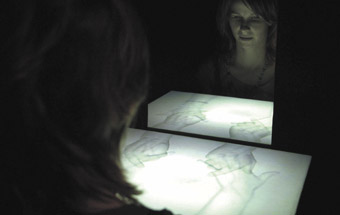
deepblue/Heine R Avdal, drop a line
photo Ctibor Bachraty
deepblue/Heine R Avdal, drop a line
BEFORE PASSING THROUGH THE DOOR TO THE “SENSUAL TOTAL EXPERIENCE” OF DEEPBLUE/HEINE R. AVDAL’S DROP A LINE, I’M INSTRUCTED TO LOOK FOR A MAN IN AN ORANGE SHIRT: HE’LL TELL ME WHAT TO DO. I FOLLOW A RAISED CARDBOARD-COVERED WALKWAY THROUGH AN UNOCCUPIED ROOM, TOWARDS ANOTHER DOOR. BELOW IS A MOSSY TERRAIN, INTERSPERSED WITH SCATTERED PAPER FLAKES AND EARTHY MOUNDS. IN THE NEXT ROOM, A LINGERING, GRATING MONOTONE DRAWN FROM A CELLO SEEPS ACROSS MORE UNEVEN KNOLLS AND ARTIFICIAL SNOW. AMIDST THE GREEN AND WHITE, THREE DANCERS IN BLACK SLOWLY CONTORT TO THE PROTRACTED, SCRATCHY NOTES. THESE BEINGS CRAWL AMBIGUOUSLY THROUGH THEIR HABITAT CREATING INHUMAN SHAPES, OBSERVED FROM THE ELEVATED PATH BY SEVERAL AUDIENCE MEMBERS. BEYOND THE ONLOOKERS, I SEE THE ORANGE SHIRT.
The man quietly points out a black curtain set back into the contours of this subterranean rural landscape: one of three dark openings accessed by a trail of cardboard stepping-stones. Self-consciously I descend into the dancing creatures’ domain then dip out of their sight. Immersed in silence and darkness I reach out and find a second curtain to pull aside. A wind chime tinkles.
I am in a shadowy cave-like chamber, encased in thick black fabric. As my eyes adjust to the gloom, something moves above a waist-high box on the other side of the alcove. Tensely moving closer I realise I am looking at my own reflection, dimly lit by white light emanating from the top of the box. I see it is a horizontal screen, with the base of the mirror rising from its back edge, so I’m looking down at the screen and its mirror image. I put on the headphones dangling from the ceiling, but hear nothing. Then I notice two holes in the side of the box facing me.
Pulse thumping in my ears, I inch my fingers into the space gaping away from me. The box top flickers. A sudden, scary electronic voice pushes mashed up syllables into my ears. Disoriented, I try to make sense of the broken noise and at the same instant a grey, digital image of my hands appears on the screen. “H-H-H. H. A. E. I. O. H. H. Hand.” The automated intonations threaten me less as I focus on the image. Turn thumbs up (thumbs down in the mirror). Spread fingers into W’s (M’s in the mirror).
But some aspect of the picture isn’t right. My mind’s confused about how many fingers there should be. Ten fingers (and ten fingers). But also, slowly, another set of fingers creeps into the screen’s square from the edge of the mirror (and into mirrored-me’s square). A 20-limbed mollusc unfurling from the threshold between reflected and real worlds, awakening as I’ve trespassed into its lair, and transgressed the liminal boundaries between human and electronic territories. These other fingers overlap with mine onscreen in beautiful symmetrical star-shapes: the silent anonymity of this digital connection reminiscent of all virtual encounters in the nowhere holes of internet chatrooms.
I freeze. If my hands are onscreen, and the other hands are onscreen, and my hands are in the box, then…It’s not just me and me in here. Sanitised virtual flirtation with the other is all very well and good but when it comes to the physical reality of actual hands…and some other person on the end of them, skulking facelessly in the dark a metre from me, watching me watch myself… well that takes this sensory-deprived/amplified-communication thing an involvement too far.
The index fingers point at me, as if to tell me it’s my move now. Deep breath. Reticently I allow my hands to waver a little further forward, up, down. The terrified anticipation of undefined frights lurking under the bed, in the darkness of ghost stories, or around the next corner of fairground rides, tumbles through my gut. My finger lands on something solid, warm, hairy. I scream and recoil, then immediately laugh out loud and grin at the mirror, behind which I realise the other person must be standing.
My companion stays still, patiently waiting to gain my trust, as I tentatively pat him under the screen and watch the image of our hands meeting. Once I’m used to his proximity, I let him play with my hands until he is massaging them, pulling along the tendons, applying pressure to the palms, scratching between each finger, interlinking his fingers and mine.
Eventually his hands retreat. The screen goes blank. I duck back into the bright gaze of the audience, joining them to sip green tea. A fresh, damp fragrance drifts upwards from my hands, staying with me for the rest of the day: a souvenir of organically artificial revelations.
deepblue/Heine R Avdal, drop a line, concept, direction, video Heine Røsdal Avdal, choreographic assistant Yukiko Shinozaki, scenography Saori Miyazawa, Arnaud Meuleman, scent artist, performer Maki Ueda, performance Anne-Linn Akselsen, Sayaka Kaiwa, Ugo Dehaes, Peder Horgen, Michiel Reynaert, Yukiko Shinozaki, composer-performer Silvia Platzer, technical director Hans Meijer; Kaaitheater, Brussels, Aug 30-31
RealTime issue #88 Dec-Jan 2008 pg. 30
© Eleanor Hadley Kershaw; for permission to reproduce apply to realtime@realtimearts.net
EXHAUSTINGLY LONG FILM AND VIDEO WORKS EXHIBITED IN GALLERIES, ART FILMS STRUGGLING TO FIND HOMES IN CINEMAS, VISUAL RECEPTION BLURRED BY SOUND BLEEDS, EQUIPMENT OUT-OF-DATE OR BROKEN DOWN, CURATORS CURATING AND CINEMATHEQUES AND FILM FESTIVALS PROGRAMMING, AS IF NE’ER THE TWAIN SHALL MEET, AND MEANWHILE MEDIA ARE CONVERGING AND ARTISTS AND FILMMAKERS AND THE PUBLIC ARE MULTI-PLATFORMING. IT’S A MESS. THE FUTURE IS HERE. IT’S TIME TO TALK IT THROUGH, WHICH IS JUST WHAT THE 2008 ADELAIDE FILM FESTIVAL AND THE SAMSTAG MUSEUM OF ART WILL DO IN A TWO-DAY SYMPOSIUM WITH SOME MIGHTY PROPONENTS FROM BOTH SIDES OF THE DIVIDE AND SOME VERY SPECIAL IN-BETWEEN CREATORS OF NEW TERRAINS.
Curated by Julianne Pierce, the Art & the Moving Image Symposium features one of the world’s leading electronic artists, Rafael Lozano-Hemmer (famous for his large scale public works, and his talks, see image p29), Larry Kardish, Senior Curator, Film and Video Department, MoMA, New York, Vasif Kortun, founder Platform Garanti, Instanbul, and Australian artist, Lynette Wallworth whose newly commissioned Duality of Light, and a survey of her work, will be exhibited at Samstag Museum of Art.
An event which offers a very different perspective on projection and the moving image is The Dome Project presented by the Australian Network for Art & Technology (ANAT) and the Royal Institution over four nights for small audiences at the Mawson Lakes Planetarium. Works specifically created for domes will be shown, curated by DomeFest founder and director David Bening from Albuquerque. There’s also a seminar.
A survey of 1940s-1970s experimental film curated by Toby Bramwell and Michael Connor (US) will be screened at the Media Resource Centre while in galleries the AFF’s umbrella program includes moving image exhibitions at the Art Gallery of SA, Experimental Art Foundation and the Contemporary Art Centre of SA including work by Dennis Oppenheim (US) Ai Wei Wei (China) and Vasif Kortun (Turkey).
A fascinating program which introduces another dimension—live music and its relationship with the moving image—is Rhythmus 09, silent, avant garde films by Dali, Bunuel, Duchamp, Man Ray and Leger curated by Adele Hann, with live accompaniment performed on grand piano by Stephen Whittington.
The symposium might not bridge the cinema-gallery chasm in the short-term, but the talking and the associated events will doubtless bring together many of the innovations of the last century and the speculative forms of the moment bubbling up from the bottom of the rift in a fecund swirl that knows no divide. RT
Adelaide Film Festival and Samstag Museum of Art, Art & Moving Image Symposium, Friday 27 Feb 27, 6pm, keynote address Rafael Lozano-Hemmer; Saturday Feb 28 10-5pm speakers, panels; Sunday March 1, 11am-12.30pm, University of South Australia, Hawke Bldg, 55 North Terrace, Adelaide, Recitals Australia Rhythmus 09, Radford Auditorium Art Gallery of SA, Sunday March 1, 3pm, Domefest Project, Feb 24-27, www.domefest.org
www.adelaidefilmfestival.org
RealTime issue #88 Dec-Jan 2008 pg. 30
© RealTime ; for permission to reproduce apply to realtime@realtimearts.net
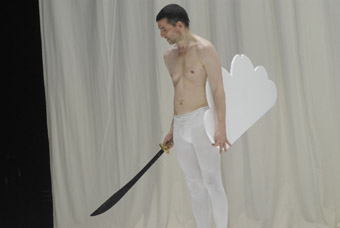
Thomas Lehman, Heromatik
photo Thomas Aurin
Thomas Lehman, Heromatik
THE THING WITH FESTIVALS IS THAT YOU ARE ALWAYS BOUND TO MISS SOMETHING THAT’S PROGRAMMED SIMULTANEOUSLY WITH SOMETHING ELSE. THIS WAS NO DIFFERENT WITH NOTTDANCE08. MAYBE IT WAS EVEN MORE PRONOUNCED, SINCE FOR THE FIRST TIME IN ITS 17-YEAR HISTORY AS AN INTERNATIONAL FESTIVAL FOR EXPERIMENTAL DANCE AND PERFORMANCE EVENTS IT TOOK PLACE NOT ONLY IN NOTTINGHAM BUT ALSO IN LONDON. INTERESTINGLY, THE EXPERIENCE OF HAVING TO CHOOSE BETWEEN WHAT YOU WERE GOING TO SEE AND WHICH CITY YOU WERE GOING TO BE IN AT WHAT TIME, TIED IN NICELY WITH THE FESTIVAL’S CENTRAL PREMISE THIS YEAR—CHOICE.
To fully explore the notion of choice, the festival’s artistic director Nicky Molloy and her team decided to invite groups of audience members, young people and three international artists to each choose some of the work that would be presented in the festival.
artists’ choice
Among the artists asked to curate an evening of work for nottdance08 was Maria La Ribot (Spain), an internationally recognised dancer and choreographer, maybe best known for her cycle of work Distinguished Pieces. She selected Spanish artist Juan Domínguez.
The set up for Domínguez’ solo work All Good Spies Are My Age is deceptively simple. Elegantly dressed in a cream-coloured suit with a brown shirt and brown shoes, Domínguez sits at a table and places small cards in front of a camera which projects their image onto a large screen next to him. The text on the cards describes how the piece has come into being. At first there is the sense that this might be the precursor to something else but gradually we understand that this is all there is: the recreation of the creation process through written text is the actual piece. Reading projected text for an hour and 15-minutes could easily become boring, but surprisingly it doesn’t. This is largely due to Domínguez’ keen understanding of audience expectation and his impeccable sense of composition. He carefully introduces various threads of narratives and meta-narratives, then starts to interconnect them. We read about his own personal situation while making the work—problems with funding bodies, his fascination with coincidences, his obsession with ageing. We are also being fed, bit by bit, information regarding the meaning of the different colours the text is written in and this way acquire clues as to how to interpret what unfolds in front of our eyes. Or are these clues red herrings? Slowly, the description of how the piece was developed gives way to the recounting of daydreams, fantasies and lofty ideas for new works. The mood turns increasingly surreal, until it is not clear any more if what Domínguez tells us is true or not. What is fact, what is fiction? What is life and what is art? And is there, in fact, a difference between the two?
young people’s choice
Two performance events at nottdance08 were chosen by panels of audience members. One of them by was by a group of 16–19 year olds. And it has to be said their choice was excellent. They decided to present a double bill consisting of works by Turkey’s acclaimed Taldans Company and German-born emerging choreographer Gabriele Reuter. Whereas Taldans’ Sek Sek, an investigation of various states of instability, is certainly an engaging and intriguing work, Reuter’s solo piece Inventory/(Räumung) is a true discovery.
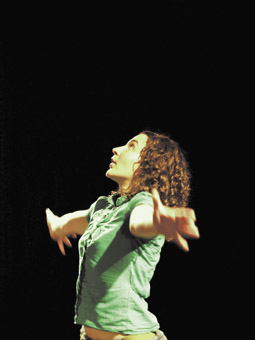
Gabriele Reuter
photo Florian Thiele
Gabriele Reuter
Like Domínguez, Reuter uses words to trigger the audience’s imagination. This time it’s spoken text and she blends it with movement. As her piece is about to begin, she tells us, “Before I start, I want to talk a little bit about the spatial arrangements here.” And this is exactly what she goes on to do. Integrating dance with philosophical musings on notions of time and space, Reuter takes us on a tour across the empty stage, imbuing different parts of the space with certain characteristic traits. For example, she introduces us to a spot near centre-stage which, according to her, is a “vague space.” Appropriately, she can’t tell us much about it. Then there is the space in which “to tell something personal.” Reuter comically refuses to go near it, as she feels she doesn’t know the audience well enough yet. There is also the corner for mother tongue. The moment she enters it, she starts speaking German. Reuter is a charismatic performer with considerable charm and a real knack for communicating with an audience. She seduces us with quirkiness and a light touch without ever leaving any doubt about the conceptual rigour and the genuine interest driving her investigation into the complex relationship between dance and space.
nottdance dialogue
Consistent with the overarching premise of nottdance08, choice was also the central focus of its residency initiative, entitled nottdance dialogue. Here, choice was not explored as a curatorial principle but as an integral aspect of artistic practice. Made possible through a partnership between nottdance producer Dance4, Springdance (Utrecht, Netherlands) and National Dance Centre Bucharest (Bucharest, Romania), a week-long residency brought together 12 international emerging artists, four from each country. It took place in Nottingham in the week leading up to the festival and was facilitated by German dancer and choreographer Thomas Lehmen and UK producer Rose Fenton. Its aim was to encourage the exchange of ideas and experiences and a dialogue about how artists present themselves. The event as such was not public but was complemented by four evenings of showings from the participating artists. Among the most interesting offerings were a mesmerising duet for two male dancers by Jack Gallagher (Netherlands) and two works by the all-female dance theatre collective MIKS (UK). They were choreographed by Frauke Requardt and Athina Vahla respectively and form part of MIKS’ triple bill project n+. Performing in works by two different choreographers allowed MIKS to showcase their significant performative range. In Requardt’s piece, n+2 flappers, an irresistible Charleston-inspired reverie, they dazzled with great musicality and comic timing. Vahla’s n+3 Objects of Friction and Fact, exploring the mythological element of the triad and partly based on Kurt Vonnegut’s A Man Without a Country, was an altogether more sombre affair. It had MIKS exchange their pink Charleston outfits and black flapper wigs for grey suit pants and white blouses, executing complex choreographic phrases in and out of synch with each other, engage in ensemble work consisting of catching and falling, as well as sing and deliver spoken text in both English and French.
nottdance in London
Among the nottdance events taking place in London was the presentation of Thomas Lehmen’s most recent work Heromatik. Inspired by the over the top characterisations of good and evil in Samurai films, Lehmen gets up to all kinds of shenanigans, exploring archetypes of the Hero. In one moment he engages in an epic sword fight with an imaginary enemy, wielding a rattling sword, obviously a theatre prop. He then becomes the victim of an invisible yet unimaginably cruel perpetrator, eliciting from him sobs and whimpers of sheer terror, all the while cowering on the floor, helplessly trying to defend himself. These evocations of imaginary worlds and characters are later contrasted with the real time destruction of much of the set, made up of several styrofoam cut-outs. Lehmen ferociously attacks one of them with a microphone until it is completely obliterated. He then continues his assault on the stage with an electric fan. The result, pieces of styrofoam strewn everywhere, is then topped by his using a smoke machine to “smoke out” the stage, leaving behind a scenario of chaos and devastation. Lehmen’s stage persona resembles that of a little kid, grappling with the complexities of human existence, full of wonder but also capable of great harm, sometimes unknowing, sometimes deliberate.
Widely regarded as one of Europe’s most innovative and forward thinking dance artists of recent years, Lehmen is clearly committed to experimentation and the continuous questioning of his own artistic practice. As he explains in his brief introduction, rather than focusing on showing a finished piece, Lehmen uses a set of fixed parameters as the backbone for Heromatik and rearranges and expands on them for each performance. In a festival dedicated to concepts of choice, this approach is an apt reminder of choice as an essential artistic driving force.
Nottdance08: Juan Domínguez, All Good Spies Are My Age, concept and performance Juan Domínguez; Gabriele Reuter, Inventory/(Räumung), choreography and performance Gabriele Reuter, dramaturgy Michael Pinchbeck, lighting Wassan Ali; Jack Gallagher, Not Yet Dancing, choreography Jack Gallagher, music Mark Poydsen, photography Theo Nikkus, video Bernie van Velzen; Frauke Requardt, n+2 Flappers, choreography Frauke Requardt, performers MIKS (Anais Bouts, Sara Lindström, Ida Uvaas), sound John Zorn; Athina Vahla, n+3 Objects of Friction and Fact, choreography Athina Vahla, performers MIKS, sound Bas Vellekoop, The Third Eye Foundation; Thomas Lehmen, Heromatik, concept and choreography Thomas Lehmen; Nottdance, Nottingham and London, Oct 17-26
RealTime issue #88 Dec-Jan 2008 pg. 31
© Martin del Amo; for permission to reproduce apply to realtime@realtimearts.net
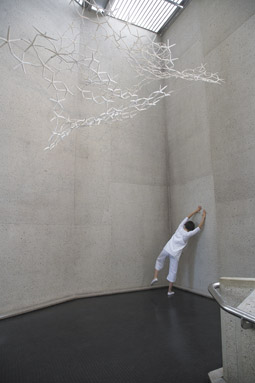
Natalie Abbott, Exhibitionism, QL2
photo David Pang
Natalie Abbott, Exhibitionism, QL2
OSTENSIBLY, THERE ARE GREAT DIFFERENCES BETWEEN DANCERS’ BODIES AND THE FIXED FORMS AND FLAT SURFACES OF ARTWORK IN GALLERIES. A RECENT QUANTUM LEAP YOUTH DANCE PROJECT IN CANBERRA SET OUT TO CHALLENGE JUST THAT SUPPOSITION.
Exhibitionism was a promenade performance presented on-site at the National Gallery of Australia. Recent tertiary dance graduates from around Australia collaborated with Brisbane choreographer/mentor Brian Lucas and NGA staff to create five short, site-specific pieces. A connective framework of enactments drew the audience from site to site.
Tour leader Sarah Kaur relaxes the audience, guiding us where to walk (and what distance to keep from the art) whille succinctly introducing some of the artworks. Her presence is easy, gracious and a good ice-breaker for the audience.
First we view the courtyard Sculpture Garden. From inside we look out through glass walls at figures traversing the space, sometimes playful as children, at other times, strict as surveyors measuring a path; at others, struggling on the threshold between pavement and water, inside and outside. They speak to us but we can’t hear—choreographer Natalie Abbott perhaps reflecting on the struggle of Rodin’s Burghers of Calais, on display for the judgment of their citizenry. A dancer mouths at us as we leave—the ultimate tourist proletariat—for the next port-of-call.
Within the Sculpture Gallery, amongst polished and twisted trapezoids and Brancusi’s elegiac Birds in Space, dancers work the negative space between sculptures in this light-flooded area, their costumes white and light against the granite floors and reflective or massive surfaces. Gareth Hart places four small boxes on the floor—gifts for us to open, which each prove to hold a proverb-like quotation and an origami bird.
The dance plays well with proximity and distance, Hart also exploring glimpses of dance/recognitions through tall internal windows. The piece is both delicate and tough—like the gift boxes, unfolding thought and folded air.
We walk up the ramp, beneath a suspended canopy woven out of the bodies of sea stars, to the sound of a piercing, melancholy wail. Around the corner, Warwick Lynch is playing a musical saw. If sound painted air we would see this music as a ribbon floating behind us, while also urging us forward. Like memory, looking, sensing, a silken stretching in multiple directions.
In the Asian Gallery, through a carved Indonesian arch, we view a dancer perched on a white plinth, just not toppling. Her body like Shiva’s, at first, but with hiccups: pushing against its angularities—the struggle of a traveler, an outsider temporarily inside a new culture, flooded with responses, struggling to recompose new experiences within an older identity. Nicholas Ng’s urhu [Chinese ‘violin’] is a beautiful complement in this space, gentle yet also sharp against the jerkiness of this dance .
Chimene Steele Prior has also choreographed our next stop, “Amongst Blue Poles.” For me, this dance is skilled, but the least successful of the works. I am unsure whether the falling and swerving dancer’s movements are meant to reflect Pollock’s mind conceiving the painting, the fall of the paint itself, or the spectator grappling with it. The questions per se are fine, but they seem unintegrated within a feeling structure—as if Steele Prior draws the lines but not the full calibre of breath within and behind them.
The last segment is delightful, in a foyer/workshop space, amongst potted palms; dancers peering, calling attention, moving away, breaking into applause, then shushing themselves quiet. The sequence is attractive, self-conscious, duplicitous, ambiguous. What are we really looking at? How can we ever really know? This company-collaborated piece is a very funny conclusion to the event.
This group achieved much in the month allocated within QL2’s Soft Landing project. Nonetheless, there are some unresolved elements—most notably, the bridging pieces between segments, which Lucas himself performs in a way that heightens his tall, angular quirkiness. They appear, however, as bits of broken textures—like fragments of peanut brittle, odd servings at odd times over the course of a progressive dinner. But what are we in these in-between spaces anyway—perhaps nothing so much as acts of recomposition ourselves.
Quantum Leap, QL2 Cente for Youth Dance, Soft Landing project, Exhibitionism, director Brian Lucas, choreographers Natalie Abbott, Gareth Hart, Chimene Steele-Prior, composers Nicholas Ng, Warwick Lynch, collaborating dancers Rudi Bremer, Alyce Jasmine Farrell, Laura Fishwick, Yahna Fookes, Elanor Jane Webber, Patricia Wood, Ebony Wright, NGA project staff: manager Katie Russell, Youth & Community Programs Officer Adriane Boag; National Gallery of Australia, Canberra, Sept 26-28
RealTime issue #88 Dec-Jan 2008 pg. 32
© Zsuzsanna Soboslay; for permission to reproduce apply to realtime@realtimearts.net
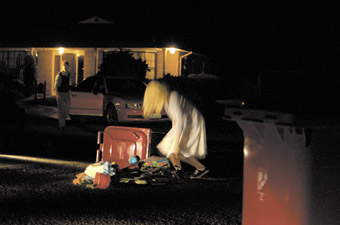
Stompin, Uncover This
photo Patrick Ronald and Shannon McDonell
Stompin, Uncover This
UNCOVER THIS IS THE NAME AND SECRECY IS THE GAME, UNTIL THE NIGHT OF THE SHOW. YOU PICK UP THE TICKETS, THE VENUES ARE REVEALED. IN THE FIRST PART, ON A SUBURBAN STREET, THE AUDIENCE IS SPLIT INTO TWO GROUPS, ONE GOING INSIDE A HOUSE FOR HALF AN HOUR, ONE STAYING OUT, THEN THEY SWAP OVER. A WEEK LATER, YOU’RE SEATED AROUND THE EDGE OF A CUL-DE-SAC IN WHICH THE SECOND PART OF THE WORK IS PERFORMED. THE SECRECY GENERATED A SENSE OF PLAYFULNESS, AND OF LONGING. THE LOOKING INTO THE HOUSE AND PEERING OUT OF IT, AT THE PERFORMERS AND AT EACH OTHER, CREATED THE UNEASINESS AT THE HEART OF UNCOVER THIS BY LAUNCESTON’S STOMPIN.
There were some eight rooms in the house you could enter, six of which were inhabited by one to three dancers. The other two had binoculars with which you could peer into neighboring houses, or at the performance outside. Some of the audience refuse, others relish the opportunity for participation. Each room yields different emotions: you laugh while being fed what looks like baby food; you feel loneliness while lying on a bed by yourself in the middle of a dark room, two figures moving around you.
The two dancers attempting to feed you talk gibberish while you decide whether or not to eat, determining which way the scene will go. At other times you become an intruder, feeling as if you’re inspecting the most personal details of the inhabitants’ lives but with a simultaneous sense of voyeuristic intrigue. You have to keep watching, however uncomfortable you feel, sometimes alone in rooms that will only take one person at a time. In one room two dancers fold laundry and occasionally adjust your clothing—they roll up my sleeves. Some of the audience members don’t enjoy the physical contact. I enter a bedroom to find three girls arguing. One of them screams in my face: it’s fairly confronting and not easy to get out of the room because there are people behind wanting to come in.
Each of the rooms offered a sense of discovery, of something about oneself, or someone else. Sometimes it was simply a desire to get out of the house, but not being able to.
In the second part of Uncover, as you walk into the cul-de-sac cars blast music, people bicycle around you and friendly faces from the week before wave and say hello. Although this time you’re outside, there’s still the same sense of mystery and intrigue but with a new group togetherness—wondering what someone sitting opposite you, looking away, is thinking, in the same way you’re curious about the neighbours—what are they up to?
One image that stood out for me was of all the dancers coming together, forming a square and moving as one, like a crowd crossing at street lights. In the same scene a single beep in the musical score went into a fast continuous beeping, and the dancers, as if at a traffic crossing, broke out into individual moves, each finding their own way, then coming back together again. In another moment the repeated movements of the dancers were sometimes suggestive of slowly peering over the fence to spy on your neighbour, then shying away and reacting as if you were keeping to yourself, on your side of the fence.
Wheelie bins played a key role in Uncover This. In Part 1 a single dancer stood on top of one, moving it around without setting a foot on the ground. In Part 2 the action is repeated but with more dancers, and this time building what looks like a small barricade, and placing people inside some of the bins. We grow curious about what else is in them, wondering ‘Are wheelie bins sacred, surely not, but then why don’t we like people looking in them? Things we don’t want seen, aspects of our identities?’ When we do see the contents there is both a sense of discovery and intrusion. Two dancers tip their wheelie over, spilling out children’s toys. One of the performers pulls off her wig and throws it onto the pile. It was like some kind of personal cleansing I felt I shouldn’t have been witnessing.
The final beautiful image of the show has stayed with me: all of the dancers costumed in small internally lit cardboard houses. Each house was then placed on the ground and the dancers exited the cul-de-sac. Uncover This suggested that everyday life is a performance, everything we do is a dance of some kind.
I was amazed by Uncover This, the risks it took in timing and audience engagement, performing two discrete but related parts, each an entity on its own, and its success in using contemporary dance and movement to express the joy, sadness or inner turmoil that lie beyond words. Talented young choreographer Adam Wheeler uses simple movements and images to entrance his audience, and keeps us on our toes throughout. What’s around the corner? What’s behind this door? And what is in that wheelie bin?
Stompin, Uncover This, choreographer Adam Wheeler, performers 25 Stompin dancers, lighting designer Daniel Zika, composer David Franzke, video Daniel Speed, Sam Thiele, Launceston, Part 1, The House, Sept 30-Oct 4; Part 2, The Cul-de-sac, Oct 10, 11
RealTime issue #88 Dec-Jan 2008 pg. 32
© Laura Bishop; for permission to reproduce apply to realtime@realtimearts.net
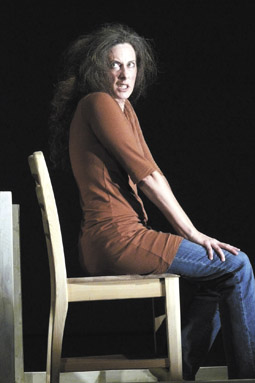
Dawn Albinger, Heroin(e)
photo Rossella Viti
Dawn Albinger, Heroin(e)
MARGARET CAMERON’S POETIC MONOLOGUE THE PROSCENIUM HAS BEEN STAGED IN VARIOUS CONFIGURATIONS: AS A DOUBLE WITH HELLEN SKY’S MAKING LIGHT OF GRAVITY, AS AN ENSEMBLE PIECE BY STUDENTS FROM EDITH COWAN UNIVERSITY’S PERFORMANCE COURSE, AND NOW TOGETHER WITH DAWN ALBINGER’S AUTOBIOGRAPHICAL HEROIN(E).
Cameron’s text is a dense weft of intertextual references and poetic images, including allusions to Alice In Wonderland, Gulliver’s encounter with the Lilliputians, Munch’s The Scream and others. Although Munch and the dream-like accessing of intense childhood memories and aestheticised traumas evokes Expressionism, Cameron’s realisation owes more to late 19th-century Symbolist theatre, Odilon Redon and Baudelaire’s Les Fleurs Du Mal. Her simple, resonant performative presence is both anchored in and generated by the word itself.
Cameron’s gestures and movements are sparse, tending to shift between archetypal tableaux which she embodies, rather than enacting (even in an abstract fashion) the events or images she enunciates. As Cameron says, the proscenium space within which this recitation occurs is, in a sense, “literal”; the spoken word tumbles to the floor like a thick wet blanket of affect and metaphoric play. Like Redon, Cameron is seeking an ambiguous yet still recognisable world of palpable symbols which lies behind the particularities of her own experience, even as it inhabits her life.
The performance begins with the statement that this universal, aesthetic substrate to our lives rests “embedded within the ancient erotic curve of the imaginary” and “the symbolic.” This might suggest a Surrealist approach, a realm of motifs whose potency stems from sexual desire and our identifications with our parents. A mother—presumably Cameron’s (at least in symbolic terms)—provides a melancholy, much loved but distant centre to many of the childhood events described. This however reflects the kinship between Surrealists, Baudelaire and Redon, rather than an actual focus on sexuality and its opaque meanderings through identity. The key function and force of both Cameron’s text and her performance is simply to symbolise, to translate something—a lost memory, a dream of a drunken father hosed through the window by distraught relations, an idea of Cameron herself as a “child of imaginings prancing barefoot with a stone”—into a recited performance awaiting an audience.
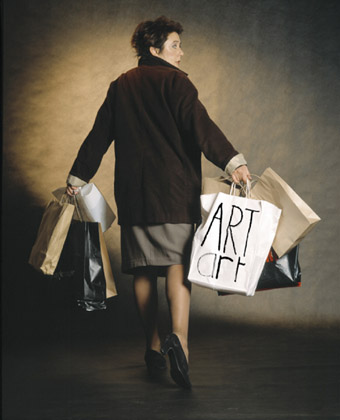
Margaret Cameron, The Proscenium
photo Ross Bird
Margaret Cameron, The Proscenium
The image of Cameron in a padded coat, dripping water onto the stage while perched, arms outstretched, on a rock, encapsulates and embodies the totality of the performance even as it demands further explication via the various stories, allusions and poetic trails which are projected from this image during the piece. The Proscenium collapses naked minimalism (the relatively few performative images and gestures) into complex linguistic play, demanding attentive listening.
Dawn Albinger’s solo, Heroin(e), is also performative and minimal—indeed, its poor theatre aesthetic at times suggests rough cabaret—while emanating from a fundamentally linguistic centre, here a narrative of a woman who survived both a car crash and living with a heroin-addicted partner. Similarities cease here though, for Albinger’s literalism is distinct from Cameron’s. Albinger is an accomplished and empathetic performer. Heroin(e)’s appeal however is based on the performer’s claim to authenticity over and above aesthetic craft and poetics. The work’s aesthetic politics has its roots in those approaches arising out of 1960s feminism, in which one charts the female protagonist’s struggle towards the final realisation of her true, free self.
Rather than a stone and a drenched coat, Albinger brings onstage a wooden table and a chair. She rocks, climbs over and almost juggles these items in a rude but charming choreography of form and physicality. The specific architecture which she creates here is however largely incidental, animating Albinger’s angst-ridden story rather than expressing it through shape or movement.
Personally neither a great fan of, nor believer in, authenticity within a space so contrived as theatre, I found Heroin(e) most alluring when its dramaturgy reflected a poetic sensibility whose origins did not lie in the exigencies of the narrative. At several points, Albinger’s table became a body, but not simply that of her lover or indeed that of Albinger herself. Rather it at times generated a sense of both presence and absence, of longing and resentment, which folded into each other as Albinger compulsively scratched the table’s inclined surface, attending to a sensual itch s/he could not and did not want to shake, or when the performer lay horizontally across its length stroking its planes, hoping to transform it into her ideal.
Albinger’s narrative clarity made for a more approachable work than Cameron’s, Heroin(e)’s affective transparency contrasting with Cameron’s more ambitious attempt to “substantiate” a wet “viscosity of being” and poetic “ambiguity.” While Albinger uses the theatre as a site to restage and salve personal dramas, Cameron “swallows” whole the “house” of theatre and manifests its structure and poetic placelessness within her speech. The pairing of these artists was as revealing as it was satisfying.
The text and selected images from Margaret Cameron’s The Proscenium are published in Masthead, no. 10 (March 2006), www.masthead.net.au/issue10/cameron.html
The Proscenium, writer, performer Margaret Cameron, sound David Franzke; Heroin(e), writer/performer Dawn Albinger, direction, scenography Margaret Cameron, music & songs Julie Robson, Grant MacMillan, Randall Mathews; lighting for both works by Andrew Beck; Perth Institute of Contemporary Art, Sept 25–Oct 5
RealTime issue #88 Dec-Jan 2008 pg. 33
© Jonathan Marshall; for permission to reproduce apply to realtime@realtimearts.net
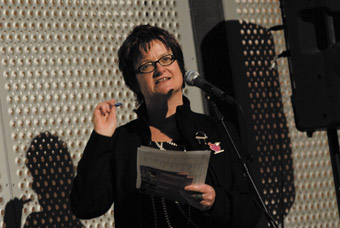
Fiona Winning opening Live Works
photo Heidrun Löhr
Fiona Winning opening Live Works
A WHITE LIMO WITH A MALE CHAPERONE IN A WHITE TUXEDO PICKS UP FIONA WINNING FROM HER HOME. THE CAR GLIDES TO THE OLD PERFORMANCE SPACE ON CLEVELAND STREET. WINNING ENTERS THE EMPTY THEATRE AND IS GUIDED TO THE DISTANT STAGE ON WHICH SITS A GLOWING CARDBOARD BOX WITH CURTAINS WHICH SHE OPENS AND AND PEERS IN. STILL IMAGES (FROM THE REPERTOIRE OF HEIDRUN LÖHR) AND SOUNDS OF PERFORMANCES ACROSS THE NINE YEARS OF HER CARING AND CREATIVE STEWARDSHIP AS PERFORMANCE SPACE DIRECTOR AT CLEVELAND STREET, AND THEN AT CARRIAGEWORKS, FLOW BY.
Winning watches the history she helped realise, so ephemeral, yet so palpable. She leaves by the rear exit and encounters colleague Billy Mac playing didjeridu in the park. At the nearby Bill & George’s artist-run space she’s entertained with a tango, and returned to the park where Martin del Amo dances in his underwear to Nana Mouskouri. And the night is still young.
Winning is driven to the back lane of the party venue, Medium Rare, an upstairs gallery in Redfern, where a red carpet awaits her and, when the carpet runs out, pieces of red cloth are thrown by the crowd to place beneath her feet. Inside she has to burst through a welcoming banner into an evening of more performances as well as laudatory speechmaking. The crowd comprises many members of Australia’s contemporary performance community, dancers, visual and media and sound artists, writers, past and present Performance Space Board members, Performance Space founder Mike Mullins and former director Sarah Miller, funding body colleagues and friends from Winning’s pre-PS days.
Victoria Spence is, as ever the ideal host. Billy Mac recalls Winning’s firmly propelling him into performance as an indolent young man and plays a didjeridu tribute to her. Annette Tesoriero leads a small ensemble in a sweet round of Viel Glück und viel Segen with the crowd joining in. A be-wigged PS associate director Bec Dean astonishes everyone with a wickedly funny, sexy karaoke rendering of “The Wind Beneath My Wings” for Winning. The PS staff dance to a pop tune with precision and abandon. Version 1.0 perform silently to a Jason Sweeney treatment of George Bush’s ‘economic recovery’ speech, sharing chocolate ice-cream, some with larger spoons and appetites than others, good manners verging on the very foul. Speeches from the board chair, Clare Petre, Sarah Miller, board member John Gillies and general manager Julianne Campbell celebrate Fiona Winning’s collaborative leadership and her capacities as nurturer, negotiator, promoter; as a PS director with the instincts of a producer, with a local and a national vision; as a delegator and a downright good boss—firm, fair, good-humoured, and explosive when necessary. She is praised in particular for her management of the transition to CarriageWorks. She’d left her notes at home but Winning makes an excellent speech in reply, vividly recalling the high points and challenges of her PS years and paying particular tribute to the many artists she worked with, to Julianne Campbell, and to Harley Stumm, her partner. This was a fitting farewell to be fondly remembered.
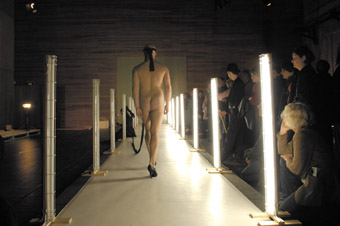
Dallas Della Force, Finale, The Pacitti Company, Live Works
photo Heidrun Löhr
Dallas Della Force, Finale, The Pacitti Company, Live Works
a kind of apotheosis: livework
s
The performance community in Sydney has long dreamt of a festival of performance, as had Fiona Winning even since the move to CarriageWorks. She made it a reality in the final months of her directorship if not without a struggle. The inaugural LiveWorks festival in September filled much of CarriageWorks with Winning’s vision: local, national, international, intergenerational and hybrid. Over two days (one with a deterring wintry downpour, the other fine, audiences flooding in) attendees looked to maps to find their way to diverse performances, competing for spaces to enjoy the intimate miracle of Aphids’ Underground (two virtuosic percussionists with us at a long table playing Rosemary Joy’s unlikely and subtly crafted instruments) or Duncan Speakman’s immersive Audio Walk through Redfern or Panther’s This is Not a Playground (we gather at a nearby playground and participate in games with a dark and metaphysical turn—a great idea if needing some serious tightening of text and concept).
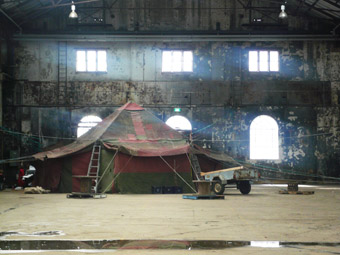
Tent, Matt Prest
photo Debra Jason
Tent, Matt Prest
In the massive, partly flooded, unrenovated Bay 23 there’s a car roaring away and a tent into which we file, to be fed soup and witness a strange encounter embellished by projections, puppets and other magic in Matthew Prest’s The Tent, an oddly compelling deadpan piece of Australian gothic about male relationships, among other things. Other local productions that impressed were Paul Dwyers’ Bougainville Photoplay Project Bougainville Photoplay Project and PACT Theatre’s The Speech Givers, which revealed a new level of inventiveness and intensity in Regina Heilmann’s direction, working with a cast of five instead of the usual mass of young PACT players. Jane Grimely, Gideon Payten-Griffiths, Jacob Paterson, Caroline Wake and Amity Yore live out the fears and responsibilities of public speaking with a sustained intensity and moments of explosive if temporary release. They function like a neurotic public organism in a dance of death—with chairs, lecterns and speeches on paper that might never make it to the mouth and all to sound artist James Brown’s dynamic score. Elsewhere in the program Linda Luke and Peter Fraser performed Borderlines and Tarkovsky’s Horse, respectively [RT87, p20], while Rosie Dennis in Fraudulent Behaviour and Martin del Amo in Excursion experimented on willing audiences with tantalising works-in-progress.
The LiveWorks’ foyer installations included Roza Ilgen’s (Norway/UK) entrancing In My Shoes, the artist using human hair to mould shoes around the feet of visitors. The small semi-circle of finished shoes grew over the two days yielding a meditation on everything from Hobbitt feet to cultural taboos. High above the foyer, you could visit Makeshift a cozy, lounge-cum-public reading room, browse the artists’ book collection and watch them type memorable passages on a long strip that trailed down to the floor far below to be read by others. 3 x 3 CarriageWorks Under Construction, by a group of University of Wollongong collaborators (led by Bogan Brunt, Matthew Ellis and Catherine Fargher) directed you to radio hot spots where you could listen in on the history of the CarriageWorks and its relationship with the local community.
The Pacitti Company [UK] presented two works, Civil was originally performed by the company’s artistic director, Robert Pacitti, and is built around his 1996 encounter with Quentin Crisp (author of The Naked Civil Servant) in New York, using live performance, film projections and an architectural sense of design. It’s a spare, imagistic work, quite beautiful to look at, not least in the rescalings of the relationship between performer and grainy black and white projections of New York and how the resultant images are memorably sustained. And it’s a typically ceremonial Pacitti work, with its calculated, rhythmic distribution of motifs and a moment of literal ritual with a dead rabbit (that image of blood-letting paralleled with another of self-laceration). Pacitti has passed the work onto a younger performer Richard ‘Dicky’ Eton, who realises Civil with the requisite quiet, graceful intensity of a ritual that celebrates the life of a famous, rebellious outsider and the inner suffering that such disobedience yields. Although the work showed its age stylistically and formally (we live in more talkative times, are more information hungry) I enjoyed its peculiar power.
The second Pacitti Company work was the well-travelled Finale, the framework (and much of the substance too) for a performance that the company carries with it, fleshing it out with local performers, in this case over two weeks prior to the performances. Themes and events from Emile Zola’s novel Therese Raquin provide the raw materials for a wide range of interpretive responses of the performers’ making, with direction and selection by Pacitti. Again the sense of ritual is prominent, from parade entrances to the washing of our hands as we exit. In between, some remarkable images unfold with a pristine and elegant if abject beauty in a flow of blood, water, sweat, milk and food and sometimes words. Bodies naked or richly attired course a long catwalk and a large lawn and perform in small, dangerous groups or execute solo self-punishments. I witness the power of images generated by Kathy Cogill, Teik-Kim Pok and Georgie Read and catch the tail-end of or hear later about those created by Ari Ehrlich, Ana Wojak, Carlos Gomes and Annette Tesoriero. A dinner table scene with Pacitti, Richard Eton, Ana Wojak and Sheilah Ghelani is particularly engaging (and more evidently rooted in the novel) and later transmutes into a pair of mimed, oppressive fuckings realised with the delicacy of a dance.
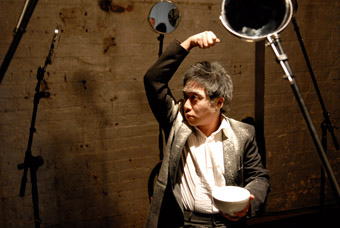
Teik-Kim Pok, Finale, The Pacitti Company, Live Works
photo Heidrun Löhr
Teik-Kim Pok, Finale, The Pacitti Company, Live Works
The overall experience for the audience of Finale was not a particularly coherent one, even if you knew the novel, and the big audience on the final night and the absence of crowd management meant that there was a high degree of luck involved in gaining an overview let alone encountering some of the work’s most potent images. But, I enjoyed what I witnessed, and the freedom to wander and select in a work of such scale was welcome. So too was the opportunity to reflect on the polished viscerality of the overall production—a kind of high church Anglican performance mode when compared with the ‘pagan Catholicism’ (to coin a Fiona McGregor phrase; p40) of Guillermo Gomez-Pena and La Pocha Nostra’s gritty collaborations with Sydney artists in 2001 and 2003.
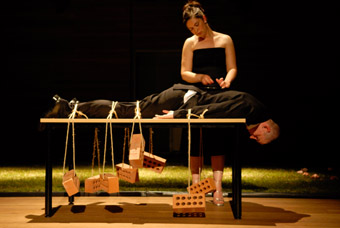
Finale, The Pacitti Company, Live Works
photo Heidrun Löhr
Finale, The Pacitti Company, Live Works
Nalina Wait’s Dual with collaborator Jane McKernan presented two idiosyncratic dancers at their most formal and abstract. It’s a well-produced work (lighting by Mark Mitchell) but the finely shaped duets and solos don’t add up at first viewing, although the ending, where McKernan confronts Wait with a cascade of furious gestures and moves, suggests a more dramatic reading—a dialogue and then a tussle perhaps between ways of being and dancing.
Helen Cole, Producer of Live Art and Dance at Bristol’s Arnolfini and artistic director of the Inbetween Time festival (collaborating closely with PS and Fiona Winning) sat us in the dark to listen to recordings of intimate recollections of performances of all kinds, from fairs, clubs, theatre, ceremonies and from diverse voices (audiences, curators, directors, performers) while fragments of light (Alex Bradley) appeared, grew and were redistributed around the theatre. Titled We See Fireworks, the work engenders a slightly eerie experience, being a very different kind of archive from the ones we usually expect of the arts, and so removed from the art of reviewing. As Cole writes, “Between the ghost of a memory and the knowledge that you were really there, we think this thing called theatre might just be in your head.”
parting thoughts
I had the pleasure of talking at length with Fiona Winning during her final days at Performance Space. The full transcript. We talked about her role as director and she described how it had changed over the years. Initially there was need to rebuild the confidence of the communities around Performance Space and among audiences after the organisation had been through a difficult period: “I was always interested in connecting dots between the temporary communities that build through making art and how to find more opportunities to build those communities. I think of it as a boiling pot and the bubbles that emerge are this energy that needs to exist and be released but it also needs to be held together. What I began to realise, not terribly long into the job, was that part of my role was to be responsive, but part of it was to be strategic and to really try to make sense of the bigger picture and to build opportunities for artists. So it was a mixture of advocacy, strategic planning and partnering, bringing our own projects as interventions or opportunities, again to build temporary communities that wouldn’t otherwise make themselves.”
As well as an emphasis on community Winning early on saw the need for greater intergenerational contact between artists: “part of that was about exchange but part of it was also about being aware of lineage because I think that’s a powerful and important thing. And it’s probably re-emerging. This is another moment when I think it’s deeply important again.” Another element in building Performance Space was to in turn build its residency program: “It was important to me and it was mostly intergenerational and it was actually really successful. Version 1.0 got one of those early residencies to make The Second Last Supper (2001), along with a number of other interesting groups.” Residencies proved useful for artists to use as leverage to get funding for their fees for what was “really invaluable research and development for which, of course, it’s really difficult to get funding.” Winning sees the residencies “as probably one of the most successful parts of the Performance Space program.”
With no capacity to buy work in itself, to be in fact a producer, Performance Space has for many years presented self-producing artists like Tess de Quincey and The opera Project in its curated performance programs and assisted them in every way possible. Now, Winning tells me, with great pleasure, a new model has been developed. “In the old days artists paid the rental and they got the box office and we created the context around it: the technical support, front of house and all that kind of stuff. We are now co-presenting in the sense that we offer the space, the front of house, a certain amount of tech support and we are partners in a 60/40 split of box office. So the risk is actually shared. But what’s changed most recently has come with the Presenter Program grants that the Theatre Board of the Australia Council has just given out. Performance Space received one of these, as did Arts House in Melbourne, PICA in Perth and a number of other organizations around the country. That’s $50,000 a year for three years just for artists’ fees. So that means that next year for the first time we’re actually completely presenting My Darling Patricia, Version 1.0 and Rosie Dennis. They’ll get their performance fees paid by us. It’s not a commission. It’s simply a presentation, but it means that the artists know what they’re getting paid. They don’t have to try and balance any books or cut any costs post-production. Partly that’s the Australia Council responding to something that I realised very early in my job, how difficult it is for artists to self-produce, self-present and make the work.”
Further on the producing front, Winning is inspired by a generation of younger artists like My Darling Patricia, Spat & Loogie, Brown Council, Janie Gibson, Post, Matthew Prest and others who are “makers first and foremost, but they’re also curators and producers. They’re so interested in the whole picture. And that’s very exciting because I think there are some artists who continue to see Performance Space as their main kind of place and I don’t think anybody can afford to do that, quite frankly. I think it’s important that Performance Space remains a home and hub but everyone needs to think a lot more rhizomatically than that and have relationships with the other partners, producers and presenters…There is a better national network than there ever has been for artists to tap into.” The DIY performance culture is also encouraged through Performance Space’s Night Time series of short works and its support for the Quick & Dirty queer performance seasons.
Winning says that making the most of the new home at CarriageWorks has been a challenge: “When you move to a place like CarriageWorks and you’re learning those physical spaces both technically and artistically and from the audience’s perspective, it takes time. I was fairly naïve…and naiveté is quite useful sometimes…We love those spaces, but there are sets of negotiations around everything.” Large-scale works, Tess De Quincey’s The Stirring and Joey Ruigrok van der Werven’s Volta (both 2007), along with LiveWorks, have been integral to PS’s growing mastery of the space.
Fiona Winning is a collaborative spirit. Initially she felt isolated when programming, but as Performance Space has grown across recent years, the organisation has been able to employ expert programmers across a range of forms. Former associate directors Blair French and Caitlin Newton-Broad initiated strong programs, as their successors Bec Dean and Rebecca Conroy are now doing, along with Rosalind Richards as dance producer. Winning says that “the integration of One Extra and ReelDance into the Performance Space program has also been important. We were very lucky to be able to support ReelDance—and now they’ve got Emerging Triennial funding.”
Despite her optimism about growing producer and presenter networks, the spirit of independence in a new generation of performance makers and the satisfaction entailed in being able to guarantee artists their fees, Winning worries about the future of the small to medium arts sector given challenges facing CarriageWorks and Performance Space. There’s the need “for the commercial side to bring in enough money to support CarriageWorks to (a) be able to run itself and some programs themselves and (b) be able to subsidise the small to medium sector…that’s their challenge and, therefore, our challenge because our destinies are somewhat intertwined.” A shift in Arts NSW policy away from project funding to program funding puts the onus on organisations to support individual artists and small companies, but without the additional funds to do so. Meanwhile, “federally, the Theatre Board has been moving towards putting more resources into presenters and producers but they still need the independent artists to bring the money for their projects with them. So on the one hand we’ve got this new big picture being presented by the Australia Council and it’s just simply not able to be matched at a State level.”
Winning is now moving on to theTime Place Space hybrid arts laboratory no. 6, which she’s co-curating with Sarah Miller and Teresa Crea in January-February 2009 in Brisbane. She feels herself “incredibly lucky” to have been Performance Space director, it’s helped define her vision: “I know what my passion is. I love programming. And I love working with artists through that trajectory of concept development, through to production and touring…So finding another context in which to be able to do that is going to be my greatest challenge.”
Performance Space, LiveWorks, Performance Space, CarriageWorks, Sydney, Aug 29-Sept 7
Read the full interview with Fiona Winning
RealTime issue #88 Dec-Jan 2008 pg. 34-35
© Keith Gallasch; for permission to reproduce apply to realtime@realtimearts.net
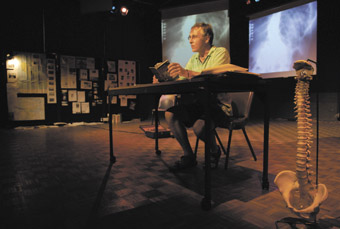
Paul Dwyer, The Bougainville Photoplay Project, Live Works
photo Heidrun Löhr
Paul Dwyer, The Bougainville Photoplay Project, Live Works
In Live Art parlance, The Bougainville Photoplay Project falls into the genre of lecture/performance. It’s spun like a casual yarn taking us from family slides retrieved from an attic into performer Paul Dwyer’s relationship with his late father, an orthopaedic surgeon. Via photographs and recollections we journey with the good doctor back to Papua New Guinea in the 1960s to observe the results of his work to fix malformed bones with the radical surgical procedure he developed. We also enter into the deep end of Dwyer’s own academic research into “performative behaviours in various models of restorative justice ‘conferencing’ and his documentation of reconciliation ceremonies on Bougainville in the current period of post-war reconstruction.”
If this sounds like heavy going, it’s not at all. Paul Dwyer is an engaging storyteller (direction David Williams, version 1.0). His performance is part-memorised, part-improvised and interspersed with a careful selection of images in multiple formats (black and white newspaper photographs, Super 8 film, 1960s colour slides, x rays, contemporary colour snaps) skilfully integrated by video artist Sean Bacon. Accompanied onstage by nothing more than a couple of screens, a vintage slide projector and a human spine, Dwyer weaves personal stories, historical documentary and ethnographic academic research into a performance that is never predictable, unfolding intimate reflections that quietly impart their deeper connections.
The Bougainville Photoplay Project, deviser-performer Paul Dwyer, director David Williams, video artist Sean Bacon, technical production Russell Emmerson, producer version 1.0, LiveWorks Festival, Performance Space, CarriageWorks, Sydney, Sept 5-6
RealTime issue #88 Dec-Jan 2008 pg. 35
© Virginia Baxter; for permission to reproduce apply to realtime@realtimearts.net
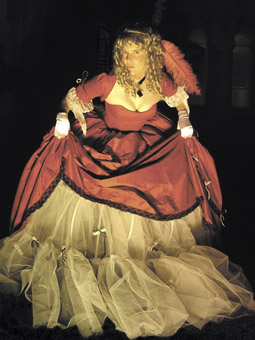
Annette Foster, Destiny
courtesy Arnolfini Arts Centre
Annette Foster, Destiny
WELCOME TO THE UK! WHERE THE INSTITUTE OF CONTEMPORARY ARTS IN LONDON HAS JUST CLOSED ITS LIVE ART AND NEW MEDIA DEPARTMENT, ITS DIRECTOR CITING HIS OPINION THAT THE PRACTICES LACK “DEPTH AND CULTURAL URGENCY.” MEANWHILE, IN BRISTOL: ARNOLFINI’S SECOND LIVE ART WEEKENDER OF 2008 ATTRACTS AUDIENCES AND DIVERSE REACTIONS ON THE SORT OF SCALE YOU’D EXPECT WHEN THE ORGANISERS A) KNOW WHAT THEY’RE TALKING ABOUT AND B) ACTUALLY PROGRAM ANY LIVE ART IN THE FIRST PLACE.
Warped fairy tales and strange symmetries weave their way through the weekend under the apt title Beautifully Twisted. Seven female artists engage with the theme of the “dark landscapes of sexuality and desire.” At the event’s conclusion on a crisp Sunday afternoon, the audience is led through muddy woods on the western outskirts of Bristol, where the artists have re-framed and re-enacted aspects of their work. Drinking wine in the gathering dark, we discuss the things we’ve experienced in the last three days.
First of all, on the Friday night, Folake Shoga emerges from the shadows of Arnolfini’s dark studio. She approaches unassumingly, asking “How’s that for an entrance?” and her work, The Long Dark Path, continues along similarly understated lines, quietly engaging the audience in a series of texts, images and actions themed around her British family and Nigerian heritage. She recreates loud domestic arguments with her daughters in amplified whispers, sending a shiver down my spine with the rejoinder “If you hate me so much, why do you wear my clothes?” She cuts open apples full of maggots, reacting repeatedly with comic yelps. She mocks her own attempts at a Nigerian dialect. It’s all delivered without grandiosity, self-regard or even—at first sight—much of a framework. But framework there is, bookending the performance. At the beginning she asks us to look straight through one wall of the studio, describing a familiar Bristol vista: pastel terraces, industrial cranes on the harbourside. Then she turns her attention to the opposite wall, making it transparent; imagining through it the landscape of Nigeria, and a sunrise that appears over the treetops like (click of the fingers) that. “My task tonight”, she says, pointing from Europe to Africa, “Is to get from here…to there.”
Sure enough, her final action of the evening is to dance from one wall to the other, in a relaxed and confident African shuffle that seems both full of movement and somehow rooted, static. Shoga’s youngest daughter sits centre-stage, hair and shoulders garlanded with strings of plastic multicoloured lights moulded in the shape of flowers, calmly bobbing along to the rhythm…reminding me of Brazilian Candomblé ceremonies (rituals with Nigerian roots of their own) where the mysteries of the universe are decorated using bargain-basement electronics. It’s a beautiful, simple tableau that seems to celebrate the awakening of a confidence with which Shoga has been flirting all evening.
In Sunday’s woodside discussion, I hear Annette Foster’s performance, Destiny, also described as a flirtatious act. But despite all the evidence I don’t personally experience it as such. In this one-on-one encounter, you’re seated in a boudoir atmosphere of muslin and mirrors. Foster stands with her back to you, laced into a bright red crinoline, hair in blonde ringlets. She glimpses you in a mirror and giggles silently, hand to mouth, batting her eyelashes, repeatedly breaking off then returning her gaze, demonstrating the faux-naif attentions of a cultured but subservient woman of the 18th century. But there lies the rub: the trappings make her performance resemble an historical artefact. In this work Foster is addressing “intimate reactions, sexuality and the history of hysteria”, and you can well believe her mannerisms are rooted in an era that diagnosed mental disorders as diseases of the womb. But as such I don’t find her sexual, or predatory, beautiful or even contradictory; there are too many clauses between Foster and I. When the music warps and her smile drops it seems a logical comment on the proceedings, expected and modern. The performer’s repetitive actions, her inevitable return to smiles and giggles, are the back-and-forth pacings of a caged animal in a zoo.
Much more powerful her manifestation in the woods later that weekend, out in the wild. She approaches slowly, zig-zag, through a dark copse of spindly trees, an anachronistic figure in her bustle and curls, becoming less intangible the closer she gets. She reads fragments of folk-tale text from the scrolls concealed beneath her undergarments and then retreats into the crepuscular gloom, skirts swishing across the forest floor. Her presence here is unnerving, half-formed, speaking of the dark violence and strange misogynies of fairy tales.
Earlier this year at the National Review of Live Art in Glasgow I sat through over two hours of short films and presentations by Marcia Farquhar. I note the timespan only because it didn’t feel very much like two hours; more like an afternoon idled away in the company of a friend. Farquhar has a warm, disarming presence and slightly scatty way of constructing performances, coupled with a way of delivering anecdotes that is best described as ‘heat-seeking.’ Personal stories duck and curve speedily, striking home at unexpected moments to hilarious effect. Farquhar never fully explains what she’s attempting with her art, never completely illustrates a point—and the work is all the more rewarding for it. Tonight, in Black and White and Red All Over she assesses the weekend’s brief as if more interested in circumnavigating it, ruminating on colour and feminist texts, on the original meaning of the word ‘glamour’, infusing the entire operation with a wonderful and completely intentional edge of “Will this do? Does this do it for you?” She dolls the audience up in the interconnected ‘paper cut-out’ dresses that I’ve seen in Farquhar’s home movies of a decade ago, made for seven people to wear simultaneously: “I don’t know quite what’s going to happen now. I have no ideas”, she says, and we believe her. So, like giddy argumentative kids, our arms connected in outfits that feel sometimes like impromptu straightjackets, we prance around the auditorium aimlessly, happily, before spilling out onto the cold quayside, jumping up and down on a bridge filled with Saturday night revellers, some of whom shout out: “Angels! Christmas angels!” The director of the ICA, I think to myself, would have this as lacking depth and cultural urgency. But how would he truly be able to judge? He’s opted out of wearing the dress.
Live Art Weekender, Beautifully Twisted, artists Folake Shoga, Annette Foster, Marcia Farquhar, Traci Kelly, Francesca Steele, Claire Thornton, Monika Tichacek, Arnolfini, Bristol, UK, Oct 24-26
RealTime issue #88 Dec-Jan 2008 pg. 36
© Tim Atack; for permission to reproduce apply to realtime@realtimearts.net
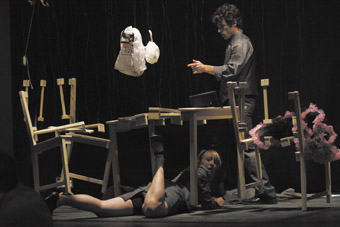
Going (with Coming), Theatre of Mistakes/The Relationship
photo Paula Court
Going (with Coming), Theatre of Mistakes/The Relationship
WHAT COMPRISES A PERFORMANCE MISTAKE? FOR 1970S BRITISH GROUP THE THEATRE OF MISTAKES, IT FUNCTIONS TO HIGHLIGHT STRUCTURE, TO PROVE FORM IS BEST READ THROUGH RUPTURE. THIS IS THE CASE WITH GOING, THE FIRST OF THEIR WORKS TO BE WHOLLY REHEARSED, MISTAKES INCORPORATED.
Beneath bare light bulbs, three men and two women (or two men and three women) constantly threaten to leave (“Really, I must go”, “I do think I’d better be going now”) yet never actually do. The repetition of text and gestures drawn from the rituals of saying goodbye becomes increasingly violent. Hands slam on a table, a cigarette packet is tossed, performers square up to one another, detain and push away. Phrases are non-committal, casual, petulant, full of rage. Silences are punctuated by swoons and vocal choruses which lend gravitas to even the tritest pop songs. Going is relentless: a structure with a human metronome and no ending. Our satisfaction comes from figuring out its fugal form, recognising the mistakes and the corrections they trigger, and then watching it play out over the five acts, each performer playing every part.
As director Fiona Templeton says, when Going was conceived in pre-Thatcherite Britain, noone looked like this. Slick-haired and grey-suited, its performers could have belonged to a nameless organisation somewhere on the ‘wrong’ side of the Berlin Wall. They appear locked in a Kafkaesque struggle from which there is no escape, penned in by the audience on four sides, by a formal conceit. Little wonder that when Going was performed in Pittsburgh’s Western Penitentiary, prisoners adored it; lifers felt it reflected the futility of applications to the parole board. Post 80s, everyone looks like this, like the face of faceless corporations; of commuters caught in the 9 to 5 treadmill.
The story is that when Going toured to New York in 1978, performer Mickey Greenall sat in the audience on his night off and fell asleep. In New York in 2008, this is unlikely. Two acts have been replaced with Coming, a work created by Templeton and her company The Relationship that takes on the task and structure of The Theatre of Mistakes’ earlier Homage to Pietro Longhi. Like the latter, Coming relies heavily on improvisation. A designated performer takes the lead and others copy. The Relationship works very well as an ensemble under Templeton’s direction, performers picking up cues from one another, incorporating elements inspired by the day’s news. They all have presence. There is Katy Brown’s terrifying boot camp leader who screams her way through a gruelling set of physical exercises, drenching herself with bottled water; Stephanie Silver’s leap from a table top in high heels. The audience is co-opted—asked to hold a spool or choose a playing card, to put on lipstick. Structure is less legible. Spatially, Coming leaks beyond the taped borders of Going as a performer exits the intimate theatre to the street. Like boisterous revellers, others clamber over swags of ribbon, toss shreds of paper, skid on a slippery wet floor.
Reviving Going in this context is a bold move. The Theatre of Mistakes was a core of The Ting (a larger, fluid group instigated by Anthony Howell in 1974). Anticipating the current emphasis on participation, they devised from a series of rule-based exercises (The Gymnasium) explored and refined in open workshops. Fiona Templeton’s input was crucial to their conceptual development. Going grew out of process: out of the mannerisms, intonations, formal concerns, dynamics and the collaborative practices of Howell, Templeton, Peter Stickland, Micky Greenall, Glenys Johnson and Miranda Payne. Is this still a Theatre of Mistakes work if none of those performers is in it? Does it matter?
According to Stickland, Going is to The Theatre of Mistakes what Waiting for Godot is to Beckett. It’s the work in which their prolonged enquiries into mutuality cohered and also the last time this core group were united in purpose and investigation (Templeton stayed on in New York to pursue her own projects, the group fragmented, eventually disbanding in 1981). The piece is so exquisitely classical in structure, so elegant, that to intercut it with anything is inevitably to dilute it.
Despite the input of Norwegian Signe Lie Howell, despite Templeton’s Scottish background and her engagement with French literature, despite influences as culturally diverse as Robert Wilson, Noh Theatre, Giorgio Morandi, Sol Le Witt and Gertrude Stein, there was always an Englishness about The Theatre of Mistakes. It adopted Purdies Farm in Hampshire as a rehearsal and performance space. Its work was made on the dole, in fields and barns, on Hartley Witney cricket green, its participants played shove ha’penny down the local pub. In Waterfall, their other seminal work, they dressed in cricket whites and recited koans about the weather. Theirs was an absurdist humour inscribed in the very language of Going; “Don’t be so silly” just doesn’t sound the same with an American accent.
Then again, perhaps these misgivings are pedantic. Instead of ‘beans, beans, beans, beans’, we have Javier Cardona’s lush singing of a Puerto Rican tune; Julie Troost, Adam Collignon and Chris Wendelken bring a different kind of repression to their performances. What Templeton achieves in her revisiting is a destabilisation of the classicism of Going through the romantic chaos of Coming. In that sense, this is a new type of mistake. In place of a minor rip in the fabric of the work, we have a gaping hole.
But paradoxically the fact that Going is still so effective, even in its edited version, even 30 years on, reconfirms its classic status. Templeton calls Going (with Coming) “both a play and a game” and leaves me thinking this high-risk strategy was a smart move.
Going (with Coming), created by The Theatre of Mistakes, performed by The Relationship, director Fiona Templeton, performers Katy Brown, Javier Cardona, Adam Collignon, Stephanie Silver, Julie Troost, Chris Wendelken; Chashama Theater, New York, Sept 3-13, www.fionatempleton.org
RealTime issue #88 Dec-Jan 2008 pg. 37
© Marie-Anne Mancio; for permission to reproduce apply to realtime@realtimearts.net
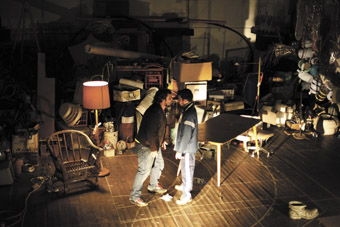
Julian Crotti & Duncan Luke, Tom the Loneliest
photo Rodney Magazinovic
Julian Crotti & Duncan Luke, Tom the Loneliest
TOM WOULD BE THE LONELIEST MAN IN TOWN, WERE IT NOT FOR TOM TO KEEP HIM COMPANY. THESE TWO TOMS ARE NOT ALIKE IN TEMPERAMENT AND THEY’RE NOT EXACTLY MATES. THEY’RE THROWN TOGETHER BY CIRCUMSTANCE, MUCH LIKE THE JUNKED OUT SHED IN WHICH THEY LIVE. STILL THEY SHARE A TASTE FOR DIAL-UP PIZZA EATEN COLD WHILE WATCHING PORN. THEY CHEW IN SILENCE WITH SLACK MOUTHS, AS THE FEMALE PORN STAR COMES TO CLIMAX. THEY’RE NOT AROUSED. WE LAUGH AT THAT. THEY SWITCH HER OFF AND START LAUGHING TOO. THEY’VE NOT BEEN LUCKY IN LOVE.
One Tom—played with earnest, angular distraction by Duncan Luke, a regular with No Strings Attached Theatre of Disability—is nerdy, needy, driven yet frustrated. His fantasy escape hinges on some story about a Russian ice skating champion. He picks up the phone on more than one occasion to call Maureen at the QuitLine. He verbally abuses her with an erotic poem about smoking cigarettes.
Mobile, versatile actor Julian Crotti plays the other Tom. He’s angry too, but less neurotic, at times exuding from his clapped out armchair a certain playful warmth. He shouts heartily at the next door neighbour whose behaviour has pissed him off. In a rough blonde wig, he role-plays Tom’s relationship with Carmel. Ten years too late, he apologises for the violence.
Tom the Loneliest is performed in a shed, off the car park, in Dunstone Grove, a recreation reserve in suburban Adelaide. It was first conceived by Luke and Crotti as a short work for No Strings Attached’s Tempted series in 2007. It’s a simple premise—two men at odds with each other, with women and the world—which is reminiscent of themes in Daniel Keene’s playwriting. Although, if the language in this self-scripted work is less figurative, the emotions are more raw, the gestures more intense.
These are disadvantaged men, disenfranchised from the material acquisitions of masculinity—a job, a wife, a house. But they’ve not lost the power of their passion. Their fulsome anger and irreverent misogyny stand them in good stead. We know that when their passion droops like soggy pizza it’s just a temporary pause.
Director Paulo Castro has successfully developed Tom the Loneliest into an engaging full-length work. It has a materialist, found-object aesthetic. It is lit from the floor with bedroom lamps. And its dramatic arc is charted by Castro and the actors with clarity and care.
We might expect that Tom and Tom should eventually find solace in each other. With all that anger at the outset, a heartfelt hug in some moment of stillness was always on the cards. Unexpected were the feelings evoked at a funeral scene when, burying a ‘For Sale’ sign named Tom, the two Toms eulogise into existence the collapse of the entire real estate market.
Like another moment near the end when Crotti finds romance dancing with an enormous puppet wasp, such material encounters with found objects generate ironies of the inevitable which are both moving and profound.
No Strings Attached Theatre of Disability, Tom the Loneliest, director Paulo Castro, performers Julian Crotti, Duncan Luke, The Shed, Stepney, Adelaide, Oct 14-18
RealTime issue #88 Dec-Jan 2008 pg. 39
© Jonathan Bollen; for permission to reproduce apply to realtime@realtimearts.net
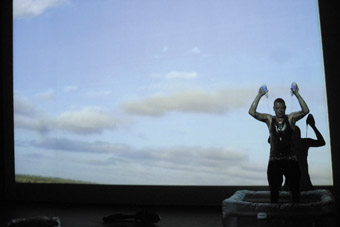
Michael Mayhew, Exist in 08
photo Juliana Yasin
Michael Mayhew, Exist in 08
IT’S HARD TO IMAGINE A MORE VIBRANT EXPRESSION OF THE BURGEONING CULTURE OF LIVE ART AND ARTIST-LED PRAXIS OF EVENT CREATION IN AND AROUND BRISBANE THAN EXIST IN 08. OVER THE FESTIVAL’S FIVE DAYS IN BRISBANE AND ONE IN TOOWOOMBA, ARTISTS WORKING OUT OF BOTH LOCAL AND INTERNATIONAL TRADITIONS EXPLORED QUESTIONS OF ‘BEING’ AND ‘DOING’ IN A WIDE RANGE OF PERFORMANCES.
Independent, local practice has been connected to international developments since the first visit of local artists Lisa O’Neill and Brian Lucas to the National Review of Live Art (NRLA) in 1998 and 1999, and NRLA’s reciprocal visit to the Brisbane Powerhouse in 2000. Subsequent events have included the Galeri Nasional Indonesia International Performance Art Forum Festival in 2006, the Indonesian Jatiwangi Art Factory event this year, and Michael Mayhew’s visit from Manchester to Metro Arts in 2007. In recent years Brisbane has seen the growth of newer, younger directions in live art in local programming more generally, in art events such as the Brisbane Festival’s Under the Radar and in Metro Arts Creative Development Festival.
Exist in 08 was co-curated by Brisbane artists Rebecca Cunningham and Zane Trow. Cunningham explained, “I had the fortune of attending the National Review of Live Art in 2007. There I saw work which I had never experienced before in my life, namely Black Market International (BMI). I said to Zane that we had to bring this work back to Australia.” The pair succeeded in bringing three of the 12 Black Market International artists and a range of other local, national and international artists to perform at the 2008 festival, which transcended its ephemeral, event-based form with, in Cunningham’s words, “the creation of artist-driven, independent performance art networks across borders.”
The scope, actions and material of each performance varied as widely as the distances travelled by participants to Exist in 08. Of the internationals, Michael Mayhew’s work represented the most elaborate effort: from his home in Manchester, Mayhew flew to Perth where he bought a car and drove across the country, collecting materials for his work in Alice Springs, Cairns and remote stops along the way. On the Friday night of Exist in 08, Mayhew showed his hypnotic Road Movie, a minimalist account of the mammoth drive, recorded with a camera taped to the steering wheel and condensing the artist’s six-week Australian outback adventure into 90 minutes. With a stream-of-consciousness audio track, in which the artist muses aloud as he encounters a variety of odd characters and amazing locations, the film is at once road movie, diary film and performance document. Mayhew worked with the great Australian road trip’s inevitable, relentless, reflection effect by questioning his English identity and its meaning in the Australian landscape.
On Saturday night, Mayhew’s performance involved, among other things, actions with jars of collected earth from the many locations encountered on his journey. Softly uttering “this is not my land”, the artist, wielding a wire cake sifter, dusted himself with various hues of red, black, gold, grey and ochre dirt poured from repurposed baked bean tins and soft drink bottles. Each of these receptacles was roughly bundled up with gaffer tape with the name of the earth’s origin—Alice, for example—scrawled rudely in permanent marker on the side. The artist’s boots carved out stark white negative space on the sheets of A3 paper on which he staged these actions, leaving an eerie echo of the performance. These traces spoke not only to Indigenous art practices, but also, on another level, to the abuse of the land by various outside interests. Using himself as a medium, Mayhew’s performance critiqued not just English but also, subtly, American domination, in actions such as his brandishing part of a cow’s skeleton while murmuring words to the effect that “These are not burgers” and “These are not here for you.” Mayhew’s forensic response to the Australian outback treated it as a repository of signs, with each object—kangaroo skulls, cow bones, rocks, sand—brought ritualistically (“sacralised”, as BMI’s manifesto puts it) into the performance. The creative focus on the performative charge emitted by natural materials, for me, also resonates with the practices of the acoustic ecology movement in sound art, and creates a similar audience dynamic of focused contemplation. At the end of Mayhew’s performance, as part of the artist’s “investigation” of materials, the objects were carefully picked out in little pools of light so that curious spectators could inspect them up close.
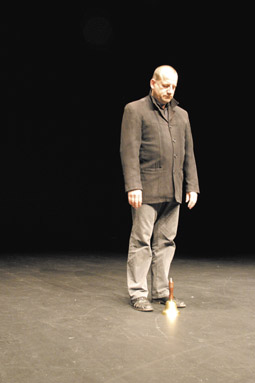
Jurgen Fritz, Exist in 08
photo Juliana Yasin
Jurgen Fritz, Exist in 08
Jurgen Fritz’s performance couldn’t have made a starker contrast to Mayhew’s highly involved theatrics. With only a single prop—what looked like a town crier’s bell— Fritz created an incredibly controlled, physically extreme performance which emblematised the BMI’s collective interest in the investigation of forms of attention. The simple gesture of ringing the bell with increasing vigour provoked an avalanche of possibilities for reflection on themes ranging from self-expression, futility, isolation and—given the intensity of the artist’s actions—embodiment.
The multiple meanings of the body in space were explored by numerous other artists performing at the festival. Alicia Jones’ searing performance confronted the intersection of body image with identity, with ‘black-washing’ of the artist’s body, flag rituals, blood-curdling screams and the symbolic shearing of the artist’s hair by a relative. Kylie Hicks’ work involved, in part, the artist pinning to her costume the vox populi stories she has collected over a long period of time, making her body a kind of mobile, fleshy archive. In Abject Leader’s film-performance, Sally Golding used her body as a literal screen for the projection of collective anxieties about ancestry, death, decay and the unseen lands beyond conscious recognition. Mexican artist Elvira Santamaria Torres closed the festival with a generous, open-hearted performance using simple materials and huge, free-spirited gestures. In a reminder of the Fluxus precept about the powerful “monostructural qualities” of “a natural, simple event”, the conclusion of Santamaria Torres’ performance with the joyful redistribution of several dozen slightly crushed red roses to audience members evoked the rich colours and glorious iconography of the artist’s homeland, while resonating with play, romance…and fragrance. Connecting audiences in and around Brisbane with contemporary live art practitioners in enthralling encounters, Exist in 08 was a resounding success.
Exist in 08 international live art event, Judith Wright Centre of Contemporary Arts, Brisbane, Oct 22-26; see www.existin08.com for catalogue
RealTime issue #88 Dec-Jan 2008 pg. 38
© Danni Zuvela; for permission to reproduce apply to realtime@realtimearts.net
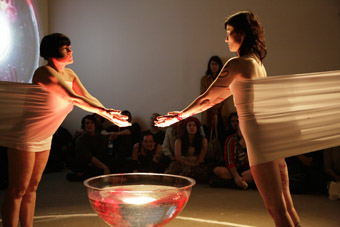
Font, senVoodoo (AñA Wojak & Fiona McGregor)
photo Waded
Font, senVoodoo (AñA Wojak & Fiona McGregor)
NOVELIST AND PERFORMANCE ARTIST FIONA MCGREGOR’S STRANGE MUSEUMS, A JOURNEY THROUGH POLAND IS NO MERE TRAVEL BOOK WHERE THE LONE ADVENTURER LOSES HERSELF IN A FOREIGN LAND AT OUR LEISURE, FOR OUR PLEASURE IN THE EXOTIC; PERHAPS DISTURBING OUR USUAL SENSE OF SELF, POSSIBLY REVEALING THE TRANSFORMATION OR EMOTIONAL GROWTH OF THE WRITER, MAYBE NOT. STRANGE MUSEUMS IS MORE DRIVEN THAN THAT: A QUEST TO UNDERSTAND AN UNFAMILIAR, OFTEN EVASIVE AND SOMETIMES HOSTILE CULTURE AND AN ATTEMPT TO PLACE THE ENCOUNTER IN THE CONTEXT OF BEING WOMAN, LESBIAN, QUEER, AUSTRALIAN AND ARTIST.
McGregor travelled with co-performer and former lover Ana Wojak as senVoodoo through Poland to festivals and galleries to present their work Arterial in which the performers, dressed in white, walk towards each other on emulsified white photographic paper, veins in their wrists open for the duration. However, Strange Museums is in many ways a lone journey, especially in its final stages. Engagingly constructed by a novelist rather than a documentarist, Strange Museums subtley and gradually unpacks personal history as the journey unfolds, withholding immediate accounts of the performance work, letting it form in the reader’s mind, and later revealing something of its origins and meanings, rooted in the writer’s upbringing, sexual proclivities and health—she suffers Hepatitis-C. It’s rare to be able to appreciate the complex motivation for performance art without having to navigate the obscurantism of poetics or theory (McGregor again feels an outsider, this time for not being part of that art-academic niche).
Fiona McGregor’s journey takes us into the living museums that are bodies, families, cultures, countries and art practices as well as the repositories of history—the architectural constructions of the past manifest as museums, churches, preserved sites (World War II concentration camps) and conserved, history-distorting cities.
There’s much for McGregor to enjoy—the widepsread acceptance of performance art (compared with its narrow ambit in Australia), making sense of the curious personalities of the artists, theatre directors and gallery owners she and Wojak meet; and reflections on the wonderful literature and worlds of Gombrowicz, Witkiewicz, Singer and, too briefly, Bruno Schulz. She even takes to the churches: “I have mellowed since my first sojourn in Europe when visiting the art in churches meant literally holding onto my stomach, such was the intensity of my visceral revolt, legacy of my orthodox Catholic upbringing.” The festivals attended are modest, under-funded, endangered; galleries are often housed in people’s homes; museums range from endangered to lavish, either evading the ugly facts of history or newly embracing them, and everywhere the opening hours are unpredictable. But elsewhere government money, McGregor writes, is thrown at art, and signs of new wealth, side by side with poverty, are evident in urban renewal and shopping centres.
As Strange Museums progresses and McGregor and Wojak travel further, the more the writer demands to understand Poland—the hero worship of Pope John Paul, the mass embrace of his successor Benedict, the right wing homogenising of culture, the widespread homophobia and, often if not always, a refusal, among artists and the intelligentsia to discuss the treatment of Poland’s Jews, not just in World War II under the Nazis, but in the appalling events of 1968.
Wojak is a quiet presence in the book, herself absent from her country of origin for some 20 years, and not always able or willing to answer McGregor’s constant querying of a culture that bewilders with its contradictions: where an apparently dissident artist can be a confirmed homophobe and the oppressiveness of Communism has been replaced not with growing freedoms but with a censorious Catholicism. Faced with a multitude of cultural complexities and not able to speak Polish, the inquisitive McGregor has to question cautiously, but even so is met with silence, with evasion, or with absolutes. To her complaint about homophobia an artist retorts, “This is not intolerance. This is tradition, it is morality.” She writes, “It was my first and last argument in Poland.” In another moment of frustration, “I flee upstairs to the kitchen. I’m fed up with this Polish defensiveness; their silence weighs upon me like guilt…Why can’t you talk about it? I say. You never stop questioning me about the Aborigines. That’s our genocide. That’s what I was born into.”
She discovers it’s not that Poles don’t know about anti-semitism or have forgotten the Holocaust—there are provocative books about it, a leading newspaper takes on the visiting Pope when he visits Auschwitz-Birkenhau and also Jankowski, a right wing Catholic priest when he labels a nativity scene in his church with the text “The Jews killed Jesus and the Prophets. They have also oppressed us.” McGregor arrives at a provisional understanding: “Silence may be denial, or protection, a veil of mourning. It seems to me that nobody in Poland is separable from atrocity, that everyone’s roots must lead back through bloodshed, and nothing is binary, everything is grey, so I tread carefully.” But she still finds herself infuriated: Jewish history is tucked away on the fifth floor of the poorly attended Historical Museum of Warsaw. Then a friend directs her to the huge, multimedia Muzeum Powstania Warszawskiego, an old power plant refurbished in 2005 that pays homage to the Warsaw ghetto uprising, is open six days a week and is crowded.
McGregor’s own body is a living museum. Celtic Catholicism, she writes, “is surely the most dour and our religion was one of unremitting restraint, punishment, and duty”, which she challenges in performance. “It is fair to say that it took performing The Ninth Station more than twenty years later, with my lips stitched and six ten-gauge hooks in my back, to get over the bad associations with [the Stations of the Cross].” It’s fascinating how McGregor comes to reconcile herself to being Catholic: it was Wojak, from a more vibrant Polish Catholicism, “who brought the visuals, the iconography and rituals of Catholicism into senVoodoo (I never would have dared)….Over the years, through my performance art more than anything, I have reclaimed my cultural heritage, and pagan Catholicism now makes sense to me. As there are secular Jews, I am a secular Catholic, whether I—or they—like it or not. And so I remain attached to the Church, a thorn in its side.” Oddly enough, her parents were tolerant and anti-racist, but also homophobic. McGregor worries at other categories, given her and Wojak’s invisibility as gay or queer in Poland, but at the same time at the restrictiveness of the terms in Australia. Some terms it seems she’d be happily cleansed of, while retaining Catholicism but purging it of its destructiveness.
Arterial, McGregor’s performance and installation created with Wojak, is a cathartic, ritualistic cleansing, involving careful preparation (watching diet, avoiding alcohol), medical assistance (not always reliably available for the pair in Poland) and the risk of collapse. Now that senVoodoo is no more, perhaps that particular cleansing is complete. Strange Museums too is an act of cleansing, if an incomplete one, a search for answers not easily found and the laying bare of a life in words. By the end of the book, ‘cleansing’ is writ large, ambiguously and variously: the Polish government’s flushing out of collaborators from the Communist period, the proposal to eliminate all of the old hammer and sickle icons of Soviet tyranny, the heavily enforced ban on abortion, attempts to ban gay parades, the erasure of the past in urban redevelopment, and the Australian parallels from a decade of oppression where nuance in politics and art has become a dirty word. As it is in Poland, writes McGregor, “where the simplest of differences struggles for a voice, I don’t have the luxury of ambiguity.”
Strange Museums will fascinate readers with McGregor’s vivid accounts of Polish cities and towns, arts subcultures, individual personalities, churches, galleries, artists’ homes, food, the countryside and the lingering detritus of war, revolt and uneven development. For artists it will have special appeal as McGregor and Wojak appear at festivals, grapple with inadequate facilties and the cautious responses to their work, attend art events and struggle to situate themselves personally and artistically in a sometimes fundamentally foreign culture. McGregor’s insights about her practice, about the pain and release involved, and the shaping of a fluid identity make the book an intensely personal one, voiced conversationally, avoiding stylistic excess and with the flow and shape of a very good novel.
Fiona McGregor’s Strange Museums, A Journey Through Poland, University of Western Australia Press, 2008
RealTime issue #88 Dec-Jan 2008 pg. 40
© Keith Gallasch; for permission to reproduce apply to realtime@realtimearts.net
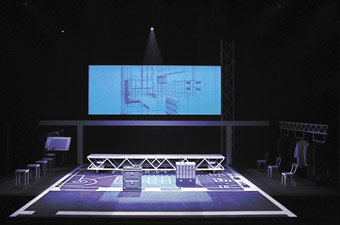
Architektin set, designer Mary Moore
photo Kate Mcrostie
Architektin set, designer Mary Moore
DELIVERING THE BIENNIAL WAL CHERRY LECTURE ON THE SET OF ARCHITEKTIN, HER PLAY FOR THE STATE THEATRE COMPANY OF SOUTH AUSTRALIA, ROBYN ARCHER EXPRESSED ADMIRATION FOR THE FLAT-PACK INGENUITY OF IKEA DESIGN. THE VALUE OF INDUSTRIAL CREATIVITY, ARCHER EXPLAINED, IS WELL-MEASURED BY ITS ECONOMY, EFFICIENCY AND FUNCTIONAL DESIGN. BUT EMPHASIS ON THE CREATIVE INDUSTRIES SHOULD NOT DISTRACT US FROM THE VALUE OF NURTURING ARTISTIC PRACTICE BEYOND COMMERCIAL IMPERATIVES FOR PROFIT.
Margarete Schütte-Lihotzky (1897-2000), the Viennese architect and biographical subject of Archer’s play, was an early exponent of functional design. Her ‘Frankfurt Kitchen’ from 1926, inspired by the space-saving constraint of railway dining cars and designed along Taylorist principles for energy-efficient labour, is the precursor to the prefabricated kitchens of today with their activity-based layout and their laminated surfaces of wood, glass and steel.
Two reconstructed pieces from Schütte-Lihotzky’s kitchen make an appearance in Architektin. A model of the entire kitchen is projected as a three-dimensional animation on a screen above the stage. Archer’s passing reference to Ikea is a reminder that, despite its ubiquity as a global corporation like so many, harnessing Chinese labour to the mass production of western living styles, the impulse to disseminate functional design for the working masses was well-born of socialist ideals.
Architektin celebrates the life and work of Schütte-Lihotzky. Her contributions in designing spaces for communal life—kitchens, homes, kindergartens, schools and community facilities—were only recognised later in her life. Helen Morse, as an elderly Margarete, enjoys enacting the architect’s satisfied exhaustion at rising repeatedly to receive yet another honorary doctorate or award.

Architektin set, designer Mary Moore
photo Kate Mcrostie
Architektin set, designer Mary Moore
There’s an irony in this restrospective gesture of recognition, which Archer recognises as a dramatic device. The younger Margarete is played by Ksenja Logos, although the two appear on stage together several times—the older Margarete offering the advice of hindsight, the younger trying to stay focused on the work at hand.
The plot of Architektin follows the building projects of Schütte-Lihotzky’s working life. The play moves deftly from her work on council housing in Vienna in the 1920s to her invitation to join the architect and urban planner Ernst May (Michael Habib) in Frankfurt, where she met and married fellow architect Wilhelm Schütte (Nick Pelomis). In 1930, Margarete and her husband travelled with May’s team of architects to Russia, where they worked to realise the new cities of Stalin’s five-year plan, even as the regime’s promise began to sour.
Schütte-Lihotsky’s decision to stay on in Russia, long after her colleagues had migrated to the USA, is a pivot to which the play returns. Another pivot—used by Archer to transition her central character from Logos to Morse—is Margarete’s decision, as a member of the Austrian Communist party, to visit Vienna in 1941 on a resistance mission. She is arrested by the Nazis and imprisoned for the duration of the war.
Schütte-Lihotsky’s life story is both epic and episodic. These two pivots provide the impulse to propel the drama through the latter, productive yet relatively peaceful, decades of the architect’s long life. Architectural labour is not inherently dramatic. Rather Archer dramatises the architectural vision—as in Margarete’s stirring speech on women’s work and children’s future, delivered at the 1968 international women’s confederation in Vienna and, here, by Morse with grace and heartfelt wisdom.
The drama in this production is directed with warmth and clarity by Adam Cook. Mary Moore’s design, lit by Geoff Cobham, realises the vision of the work. The play provides an ideal subject for Moore’s design approach. The set demonstrates the designer’s skill in extracting functional significance from dramatic form and realising it with efficient choice of colour, material and form.
An architectural blueprint, painted on the floor, provides a palette for the costumes, hung accessibly on racks. Two long stainless steel tables on castor wheels provide, for most scenes, the necessary furniture. Constructivist principles are realised in a large white beam, which frames the space, and a suspended screen. A stunning white girder descends and then is jaunted at an angle for scenes on a construction site in Russia.
Music has an affinity with architecture, as it does with Archer, but it does not figure prominently in the work. As Margarete’s fellow-prisoner, Antje Guenther sings in German a song of peace at their release, and Craig Behenna plays a composer who cannot sing. And there’s a final note: at the end of the performance, Archer appears in projected video, interviewing Schütte-Lihotsky in preparation for the play. She asks if sung how Margarete’s character should appear—a shrill soprano or a throaty contralto? Margarete answers with a smile.
State Theatre Company of South Australia, Architektin, writer Robyn Archer, director Adam Cook, designer Mary Moore, lighting Geoff Cobham, music Stuart Day, performers Craig Behenna, Duncan Graham, Antje Guenther, Michael Habib, Ksenja Logos, Helen Morse, Nick Pelomis, Playhouse, Adelaide Festival Centre, Adelaide, Aug 29-Sept 20
RealTime issue #88 Dec-Jan 2008 pg. 41
© Jonathan Bollen; for permission to reproduce apply to realtime@realtimearts.net
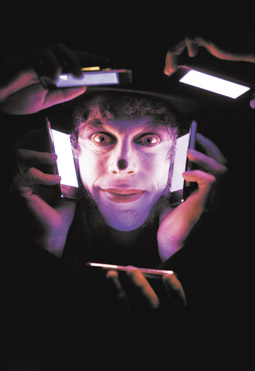
Ryk Goddard, Helena and the Journey of the Hello
photo Peter Mathew
Ryk Goddard, Helena and the Journey of the Hello
ONE THING I REALLY HAVE TO REMIND MYSELF WHEN THINKING ABOUT TERRAPIN PUPPET THEATRE’S HELENA AND THE JOURNEY OF THE HELLO IS THAT IT’S FOR CHILDREN. THAT’S REALLY QUITE IMPORTANT, BECAUSE THERE ARE PREJUDICES WE MAY HAVE AS ADULTS, WHO DID NOT GROW UP WITH MOBILE PHONES, TO WHOM TEXT MESSAGING IS SOMEWHAT INCONVENIENT AND WHO ARE POSSIBLY EVEN DISAPPOINTED WITH THE WAY THE FUTURE TURNED OUT. I WAS EXPECTING A JETPACK. I GOT AN IPHONE. NEVER MIND THAT THE IPHONE CAN CARRY MY VOICE FURTHER AND AT GREATER SPEED, I WASN’T EXPECTING IT AND I THINK I AM ALLOWED TO BE SLIGHTLY DISAPPOINTED. OF COURSE, IF ONE IS ELEVEN, THIS IS NOT A DISAPPOINTING FUTURE, IT IS NOW.
Terrapin’s new show is many things. It’s certainly an investigation of now and it’s certainly aimed at children—older children though, as it all gets a bit dark and does talk about vanishing parents, or them changing somehow. The story is told by talking animals and there are iPhones that have eyes all whirling about in a forest that’s made of metal and light. Helena and the Journey of The Hello is wonderful, in the truest sense of that word—filled with strange and intriguing delight. It’s bursting with images and ideas, sometimes so many that I found it a little hard to keep up with the pace dictated by the slightly threatening trio of story tellers, Wolf, Fox and Hare.
With their distinctive and defined personalities, these characters were a highlight, growling and grimacing and making bad jokes, evoking tiny hints of Maurice Sendak’s Wild Things. As narrators, guides and guardians of the story, they’re supposed to draw us in and keep us excited, while still being fairly convincing talking animals. Quite a job. Of course, they managed it well. In fact I found myself rather liking them and their growly, lumbering energy. I particularly liked Ryk Goddard, the Wolf, who displayed vigour and skill as a performer and whom I’d really like to see performing more tales of this dark and feral nature. The other cast members were terrific too, but Goddard exuded charisma here and was certainly the leader of the pack.
The work plays around with a lot of ideas, but the important ones seemed to be about time and distance, which is appropriate for a show exploring what technology means to people and how they can use it, particularly something as small and personal as a mobile phone. Here, the phones are sort of magical, which I suppose they are. We understand how they work, but this story evokes the science as words that fly around the globe, that connect us when we are far apart, and it reminds us that this is actually quite a wonderful thing. Perhaps the future is not such a bad place to live.
Terrapin Puppet Theatre, Helena and the Journey of the Hello, writer Finegan Kruckemeyer, co-designer, director Frank Newman, devisor-performers Ryk Goddard, Mel King, Sam McMahon, production designer Kate Davis, music Mikelangelo, Fred Showell, lighting Danny Pettingill, puppet maker and design Greg Methe, original artwork Tim Schultz; Peacock Theatre, Salamanca Arts Cente, Oct 8-18, www.terrapin.org.au
RealTime issue #88 Dec-Jan 2008 pg. 41
© Andrew Harper; for permission to reproduce apply to realtime@realtimearts.net
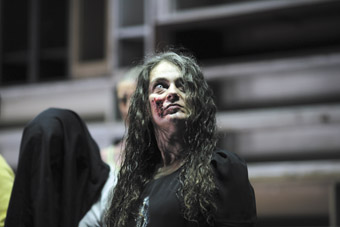
Melita Jurisic as Cassandra, The Women of Troy
photo Tracey Schramm
Melita Jurisic as Cassandra, The Women of Troy
OUR WRITERS IN MADRID, MELBOURNE, BRUSSELS, AND TOKYO IN THIS EDITION OF REALTIME REPORT BEING AWESTRUCK BY WORKS OF ART. AS JOHN BAILEY AND JACQUELINE MILLNER WRITE, THAT STATE OF BEING HAS NOT BEEN FASHIONABLE: IN ARTISTIC PRACTICE DISTANCING REMAINS DOMINANT, AN INHERITANCE OF MODERNISM, “A MOVEMENT…OFTEN CHARACTERISED IN TERMS OF THE TERROR OF THE SUBLIME”.
In this article I look at my experience of the Barrie Kosky-Tom Wright adaptation of Euripides’ The Trojan Women. I also share reflections on Complicite’s A Disappearing Number, a visually powerful account of the lives and ecstasies of mathematicians, De Quincey Co’s Triptych, a large scale Body Weather reverie, and The Border Project’s Rock’n’Roll Disaster, a modest, but convincing fantastical foray into the consuming power of popular music.
In his little book, On Ecstasy (Melbourne University Publishing, 2008), Barrie Kosky amiably and vividly traces his emerging sense of ecstasy from the pleasures of his grandmother’s chicken soup to incipient homoerotic compulsion (the wet jeans of a TV character, the smells of the sports changing room), to the touch of fur (Narnia fantasies) and silk (in his father’s fur factory), to the first strange encounter with the soprano voice in Puccini’s Madam Butterfly (on his grandmother’s old records, prior to a first visit to the opera) and his bedroom conducting of Mahler’s First Symphony. He moves on to the realisation of ecstatic states in his early work, The Dybbuk, and recently in Europe with Euripides’ Medea, Ligeti’s Le Grande Macabre (with a flood of excrement: “What has taste to do with the theatre?”) and Wagner’s The Flying Dutchman.
Ecstasy in Kosky’s book is no simple feeling of elation, of well-being, of blessedness. It’s beyond wonder. It’s all consuming. It takes over the body. He recalls from the changing room of his schoolboy years, “Body odour of every imaginable flavour, sweat, socks, Dencorub, hot water, cheap soap, the wet old wood of the lockers. All clashing in my nostrils, all fighting to get up my nasal cavities. Whirling in my nostrils like a thousand miniature tornadoes. Sometimes it became so overwhelming I really thought that I was going to faint, or vomit or scream.” At 16 he sees Leonard Bernstein conducting Mahler’s Second Symphony, leading the orchestra, but danced by the music it makes, sweat spraying from his face. He is struck, it seems, by this intertwining of creation and possession.
The power of ecstasy, Kosky realises, is in its totality. At 15 he listens to Mahler’s First Symphony and asks, “What sort of composer puts a funeral march to a children’s nursery song and a zippy village klezmer band on the same page of a symphonic score? This music seduced me. It took me, convulsed me and drowned me. It suffocated me. It was gorgeous, repellent, terrifying. It scared the shit out of me. It still does.” He cites Mahler’s own words, “A symphony must be like the world. It must contain everything.” It’s not surprising then that Kosky’s productions are singular totalities, possessed and possessing, full of odd but integrated juxtapositions, full of beauty but equally revelling in the abject until it too is bizarrely glorious. He writes, “The theatre seems to me the perfect place for the ecstatic to manifest itself. Theatre is by its very nature an alchemical mix of manipulation, ritual and stimulation.” Ecstatic theatre is therefore beyond taste, self control and reason; it is violent and excessive, and “is best conveyed through phantasmagoria” where there is constant hallucinatory slippage between real and unreal. The worlds Kosky and his collaborators conjure are fantastical, not immediately recognisable as our own, but soon enough tellingly so. They are states to be entered into, endured and embraced, to become one with.
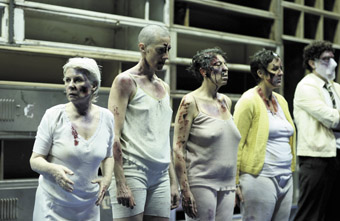
Robyn Nevin, Jennifer Vuletic, Natalie Gamsu, Queenie van de Zandt, Kyle Rowling,; The Women of Troy
photo Tracey Schramm
Robyn Nevin, Jennifer Vuletic, Natalie Gamsu, Queenie van de Zandt, Kyle Rowling,; The Women of Troy
The version of Euripides’ The Trojan Women (415 BC) that Kosky and Tom Wright created for the Sydney Theatre Company and Malthouse is not a work to which the word ecstatic might easily be ascribed, but the intense, sustained sense of grieving and despair it achieves amidst the horrors of the aftermath of war is relentlessy realised and exhaustingly compelling. And it is beautiful, in the most uncomfortable of ways, because the expression of grief yields great beauty, in and through music and acting—in a play that does not offer conventional character development but immediately demands extreme emotional states. Intensifying the focus on the women, Robyn Nevin (playing the Queen of Troy, Hecuba) and Melita Jurisic (as Cassandra, Andromache and Helen of Troy in turn), Kosky and Wright have removed the gods who open the play, Talthybius (the Greek army’s herald), and the words of the chorus (whom Euripides had cast as fellow victims of the war, singing of their individual and collective plights). Kosky’s battered chorus (Natalie Gamsu, Jenny Vuletic, Queenie van de Zandt) performs arias and laments (by Dowland, Gesualdo, Mozart, Bizet, Slovenian folk songs) sometimes joined by Nevin and Jurisic. The war with Greece lost, the women will become the slaves and spouses of the victors. The Greek King Menelaus (Arthur Dignam) arrives, in a wheelchair, to be seduced again, perhaps, by the wife who left him, triggering the war. Finally, a small boy, Astyanax, son of Andromache and Hector, grandson of Hecuba, and regarded by the Greeks as a potentially dangerous heir of Troy, is taken away, thrown off a cliff and his bloody body returned to the stage, in a small cardboard box, the legs visible only from the knee down, hanging limply from the opening. Euripides’ text is pared back, with brutal effect, but remains true to the intense feeling and musicality of the original if recast as modern music theatre.
This Kosky production is not a phantasmagoria, nor does Euripides’ play offer itself as one. It’s not like his recent The Lost Echo for STC or, earlier, Berg’s opera Wozzeck for Opera Australia. Its kin are the dark, closed worlds of the Ted Hughes/Seneca Oedipus and O’Neill’s Mourning Becomes Elektra (both for STC), Kosky at his most restrained. And while The Women of Troy contains much of the world—poetry, blood, vomit, violence, song, opera, mobile phones, television (offstage), pianist (effectively onstage)—it’s an ecstatic vision shorn of display, sensuality, revelry and dance. Even the masked workers who beat, threaten and photograph the women against a vast wall of tired lockers (like some last ditch barricade that the tired walls of Troy have become) display none of the participatory glee of their kindred Abu Ghraib torturers. These guards are characterless, bureaucratic, delivering their captives on trolleys, removing the principal women one at a time in large cardboard boxes secured with the screech of packing tape—humans ritually reduced to freight. The drab ordinariness of the place, the loudspeaker announcements, the plodding entrances and exits of the guards suggest the banality of the evils perpetrated, appalling in their tedium and suspense.
And while grieving in word and song is powerful and beautiful and momentarily consoling, there is no way out for these women, however much they implore, challenge or doubt the gods, or attribute blame and pick at the wounds that are their tales, however fair and rational their pleas for compassion. They are trapped in the irrationality of vengeance, where violence is a constant. And so are we, our seats draped in white cloth, as if the theatre has been closed for the duration of the war, random explosions regularly triggered behind and below us. The bruised and bloody women are physically close to us in the small theatre, their fear, panic and despair inescapable as they cringe and cluster defensively, hide in lockers, confront and comfort each other in song.
Robyn Nevin as Hecuba, former queen of Troy, is the production’s anchor, defiant, elegant if battered, a rhetorician, visibly quivering as she keeps emotional and physical collapse barely at bay—her husband has been murdered, her daughters raped or killed and her grandson executed. Melita Jurisic, in her three roles is equally superb, not least as the play’s most frightening figure—the prophetess Cassandra, bedraggled, blind, bloody and vomiting—after spitting out a madly ironic celebration of her betrothal to King Agamemnon—then eerily rational and set on vengeance. Then she’s the sad, pregnant Andromache, and finally, the obtuse, devious Helen. The ‘agon’ of classical Greek tragedy is played out powerfully between Hecuba and Helen, but there can be no winning this argument.
The Women of Troy is deeply horrifying and deeply satisfying theatre. In the short term you are left without words—there’s a kind of numbness as you leave—later they flood out. The Women of Troy is another stage in Barrie Kosky’s making of an ecstastic theatre, there’s a whole world in it, recognisably our own, it goes beyond words, makes barely consoling beauty out of despair, plays out the contradictions of life and of art, tossing you about in the turmoil.
complicité: a disappearing number
Mathematics can yield its ecstasies and eureka moments and there’s much talk of its pleasures in Complicité’s A Disappearing Number. We’re entertained and surprised by some maths magic in the mock lecture opening, later calculations unfold as if by an unseen hand on a blackboard-cum-screen and later again flood the stage like stars in a symbolic universe. There’s a lot of theatre magic in A Disappearing Number, but the effect is less than ecstatic. It’s a play dressed up with effects, the actors belting out their lines as if forgetting they’re wearing head-mikes, playing out the didactic juxtaposition of two sets of lives—two male mathematicians (British and Indian) in the 1910-20s, and a female mathematician and her non-mathematician husband (British and American of Indian descent respectively). The parallels between the pairs are tentatively drawn, not least because writer-director Simon McBurney and his co-devisors have very little to say about the relationship between the two men and too much about the modern fictional relationship; its elaborated tensions seem very slight indeed and then melodramatic.
The set is an immaculately realised modern university lecture theatre: the whiteboard rolls over into a blackboard, becomes a screen backdrop (for mimed Mumbai taxi rides etc), or a screen for an overhead projector, or can fly in and out as desired, as does the whole wall to reveal rooms in England and India using back projections and a little furniture.
Complicité (formerly Theatre de Complicité who impressed Australian audiences on earlier visits with The Three Lives of Lucie Cabrol and The Street of Crocodiles over a decade ago) is a British company that combines the poetic and visual attributes of European contemporary performance with a dogged English literalness. Visually A Disappearing Number is a finely wrought, often beautiful spectacle about a brilliant self-taught Indian mathematician, Ramanujan, who overcame the constraints of his Brahmin code so he could visit his mentor GH Hardy in Cambridge. Harding recognised the Indian’s genius, seeing he would revolutionise mathematics. The pair became intimates, possibly in love with each other, although this is only hinted at briefly. Why McBurney couldn’t have at least speculated further is a mystery. There’s little we can learn from comparing the two relationships, save something about the cultural divide between England and India, which is barely evident in the modern male, Paul (raised in the USA), and which is oddly expressed in both he and Harding losing their partners to India—Ruth dies while on a pilgrimage to Ramanujan’s home where he had died shortly after returning, decades before. (She’s doubly punished—with a miscarriage prior to the trip.) When Paul finally goes to the India he’s never visited before, the parallels and synchronicities between couples and eras are then made to add up to a consoling metaphysic based on the continuity between the fictions we call numbers and a corresponding indivisibility between past and future, which means we are never really separated from those we have lost. The effect, with its immersive visual correlatives, was curiously consoling, but sentimental in retrospect. Nitin Sawney’s original score is partly played live and there’s a too brief passage of Indian dance, but these are incidentals in what could have been a greater more embracing dance of notes, bodies and symbols.
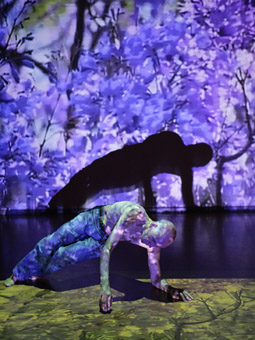
Peter Fraser, Triptych, De Quincy Co
photo Mayu Kanamori
Peter Fraser, Triptych, De Quincy Co
de quincey co: triptych
In her own work and with her company, Tess de Quincey, generates for audiences states of being that are hard to label. The performers move with a mix of eloquent grace and involuntary quivering, but are they dancing? They appear to see, to respond, but to what? Things we can’t see—remembered, re-lived, conjured? They don’t speak, but what are they signalling? Somehow, the intensity of their sheer otherness transmits itself to the bodies of the audience who then share a sense of contemplation, of reverie and risk as performers find themselves in positions that consume them but demand balance and then its loss and release before another or the same state again takes them. I’m often utterly at one with de Quincey’s creations, but not with Triptych. Here is a work with all the appearances of an embracing totality: the three large passages of the title, themes of air (projected images of the windswept dance of jacaranda flowers), electricity (a pulsing oscilloscope) and water (a somnolent ocean), four dancers, the uniformity of designer jeans and tops beneath kimonos, the music of Chris Abrahams throughout, and large scale projections in each scene on three mobile screens whose repositioning moves the audience about the performing space (variously opening up or shutting down perspectives).
But appearances are deceptive and although the performers enter their various states with all the commitment and precision you’d expect, the outcome is a collection of solos, occasional duets (Victoria Hunt and Linda Luke working in taut parallels in one passage against Robin Fox’s dancing oscilloscopery and Abrahams Fox-ish score), and all too rare moments of communality. Once I’d made a rational decision not to be distracted by the illusion of totality, the scale of the projections or the volume of the music, or taking too many performers in at once, I could focus on the pleasures and tensions realised in individual performances—Peter Fraser’s querulous self-interrogation, awed, erect, then crawling; Linda Luke’s rough-hewn assertions of and delight in risk; Lizzie Thompson, a fine dancer, here tremulous, unformed as yet in the world of Body Weather; Victoria Hunt’s muscular interiority with its long-held, acutely shaped tensions in the final scene. For me, at its best Triptych provided a kind of un-anchored shamanism, a performance of momentary pleasures and interrupted reveries. For others, it was ecstasy.
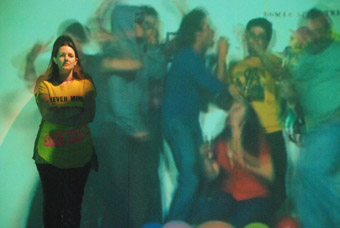
Highway Rock’n’Roll Disaster, The Border Project
the border project: highway rock’n’roll disaster
Highway Rock’n’Roll Disaster is a work of modest scale but one with a potent cumulative impact. It’s concert-like music theatre rooted in the everyday, in the love of popular songs that provide both escape (a loosening of voice and body that is both visceral and aetherial) and reflection (what was I feeling, thinking, doing, when I first heard that song?). The performance moves from mundane introductions to the songs to immersive performances, often against inventive video clips projected on the back wall or onto very mobile screens. The clips have their own integrity, or parody their inspirers, or provide an unexpected dimension: in one, a woman, not singing, stands in front of a screen on which a semi-literal drama is acted out, suggesting the death and perhaps heavenly ascent of one of the participants, like a movie version of a Duane Michaels’ photographic series about death and grieving.
The performers mutate from solo singers and instrumentalists into multi-skilled band members while their roadies turn dancers. And the songs too (Guns N’ Roses’ Sweet Child of mine aside) are mutant: they are the performers’ own, inspired by the originals that live in their psyches and bodies. It’s an odd alchemy, but the songs work and the performances are idiosyncratic and as the the performance moves towards its conclusion the concert world staging mutates again, into something much stranger: a delirious, dark world of bizarre giant creatures roaming amidst the musicians, a phantasmagoria, beyond words, of course.
Sydney Theatre Company, The Women of Troy, by Euripides, adaptation Barrie Kosky, Tom Wright, performers Robyn Nevin, Melita Jurisic, Natalie Gamsu, Jennifer Vuletic, Queenie van de Zandt, Arthur Dignam, Kyle Rowling, Patricia Cotter, Nicholas Bakopoulos-Cooke, Narek Armaganian,musical director Barrie Kosky, pianist Daryl Wallis, design Alice Babidge, lighting Damien Cooper, sound design David Gilfillan, Wharf 1, Sydney, opened Sept 20; Complcité, A Disappearing Number, conceived & directed by Simon McBurney with the company, design Michael Levine, lighting Paul Anderson, sound Christopher Shutt, projection Sven Oriel for mesmer, Sydney Theatre, Nov 12-Dec 2; De Quincey Co, Triptych, concept, direction Tess de Quincey, performers Peter Fraser, Victoria Hunt, Linda Luke, Lizzie Thompson, composer Chris Abrahams, audio-visual production Sam James, oscilloscope Robin Fox, lighting Travis Hodgson, Performance Space, Nov 6-15; Sydney Theatre Company, The Border Project, Highway Rock’n’Roll Disaster, performed, conceived, created and composed by the company, Katherine Fyffe, Cameron Goodall, David Heinrich, Jude Henshall, Andrew Howard, Paul Reichstein, Andrew Russ, Alirio Zavarce, roadies Danel Koerner, Tim Kurylowicz, Luca James Lee, Lachlan Mantelll, Kurt Murray, director Sam Haren, lighting Geoff Cobham, animation Jole van der Knaap, Paul Lawrence-Jennings, costumes Area 101, Wharf 2, Sept 19-27
RealTime issue #88 Dec-Jan 2008 pg. 42
© Keith Gallasch; for permission to reproduce apply to realtime@realtimearts.net
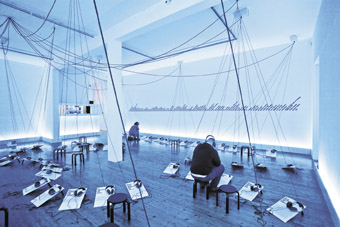
21:100:100, Gertrude Contemporary Art Spaces
photo Andrew Curtis
21:100:100, Gertrude Contemporary Art Spaces
ASIDE FROM AMERICAN AVANT-GARDISM FROM THE 60S, CONTEMPORARY SOUND AND EXPERIMENTAL MUSIC HAVE GENERALLY BEEN ABSENT FROM MOST MAJOR PERFORMING ARTS FESTIVALS IN AUSTRALIA. MELBOURNE FESTIVAL 2005 DIPPED A TOE IN THE WATER PROGRAMMING THE CYBERZEN MASTER RYOJI IKEDA WHO TURNED SOME ON TO THE POSSIBILITIES OF EXPANDED LISTENING AND OTHERS RIGHT OFF. BUT IN HER FINAL FESTIVAL KRISTY EDMUNDS PUSHED A LITTLE FURTHER, PROGRAMMING A HANDFUL OF ACTIVITIES IN WHICH SOUND (OR ITS ABSENCE) WAS THE KEY INVESTIGATION.
21:100:100—the exhibition
The most significant of these events was the exhibition 21:100:100, a festival partnership with Gertrude Contemporary Art Spaces, ambitiously presenting “100 works by 100 sound artists produced in the 21st century.” (Well almost, there were a few inclusions from the final decade of 20th). It was like the biggest sampler of the ‘cool’ of experimental music you could imagine, curated by notable sound artists Oren Ambarchi and Marco Fusinato, along with the gallery’s Alexie Glass and Emily Cormack.
Management of such a large collection notwithstanding, what was particularly impressive was the design of the exhibition. Taking up both lower galleries each artist/track had its own set of headphones, and a small placard, angled up from the floor, with just the right amount of contextual information. The headphones were tethered to the floor with the remaining length of the leads rising up to the ceiling in splendid fanning looms. Every attention was paid to the elegance of these clusters and their placement within the space, while evocative lighting in the second room created a kind of spiders’ lair. Scattered around were small black gardening stools, a challenge for the larger and less mobile, yet good for keeping you grounded, focused and alert to the listening task at hand. The pieces were arranged in alphabetical order of artists’ names, proving a far more satisfying strategy than the imposition of other curatorial taxonomies. Within one cluster you could hear a range of methodologies from artists of varying ages, eras and countries: for example Pateras/Baxter/Brown next to Pita, next to Francis Plagne, next to Stephen Prina, next to Eliane Radigue.
For those who are already walking discographies perhaps there was nothing to be learned here; and I wondered if for those new to experimental music and sound, the scale of the exhibition might prove daunting. For someone like me, who knows how much she doesn’t know, this exhibition was full of satisfactions and revelations. However, to avoid gallery anxiety attack, you needed time. Going twice I estimate I sampled around 70% of the works, but I couldn’t always listen in entirety, problematic for the 20 minute compositions in which the exposition over time is the point. The inclusion of around 20% Australian artists (with a strong Melbourne contingent) amongst the many acclaimed international artists, was a heartening illustration of the strength of experimental sound and music in this country especially over the last eight years.
21:100:100—the performance
To accompany the exhibition, there was also a one-off concert at the BMW Edge, Federation Square. Performed by Oren Ambarchi, Marco Fusinato and Brendan Walls on guitars and electronics, James Rushford on prepared piano and Robin Fox with his laser light spectacular, it was strangely refreshing to sit through only one 45 minute set without three other performances on the bill as is usual in sound events. The set explored the slow build structure almost inevitable in live sound performance. Starting with some quiet piano torturings by Rushford, subtle layers of guitar were added. Developing in a meditative fashion, full of rich harmonic drone play, the performance was spiced up by occasional feedback shrieks and percussive eruptions, generally instigated by Walls. Some more insistent electronic rumbles indicated the presence of Fox, along with a regular relay of smoke machines letting off into the space, one poorly placed behind Fusinato, enveloping him periodically in clouds of smoke, reminiscent of the misguided grandeur of Spinal Tap. Around three quarters through, the by now wonderfully dense dronescape reached its peak, and slid away leaving Ambarchi playing spare notes. Seemingly an end, but no! Within a beat, the Fox took flight, and the lasers pulsed into action, carving the space into vectors and planes. The seats rumbled with rhythmic bass and the intelligent spectacle wound up the show. Fox’s laser work is difficult to integrate with other works, and as was the case with its inclusion in Chunky Move’s Mortal Engine, the practicalities of the smoke machines, along with the works’ multisensory impact defined it as a separate entity, best saved till last.
echolocation
Alex Stahl’s Echolocation was poetically described as “allowing us to find our voice in the urban cacophony.” Using an impressive array of speakers suspended under the arches of the Princes Bridge, the piece played sounds of flocking birds, recorded on location, mixed with occasional chimes and tones. By calling a phone number and singing or speaking to the nothingness that greeted you, supposedly the sound would be altered. Trying this several times, I felt no empowerment as the ‘conductor’ of this universe. There was too much rhetoric about the work that in reality had the effect of playing back a nicely composed version of sounds from the same location.
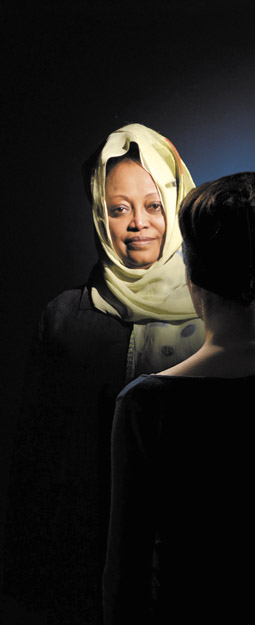
Evolution of Fearlessness
photo R Fasa
Evolution of Fearlessness
evolution of fearlessness
Significantly, Lynette Walworth’s installation Evolution of Fearlessness is silent, as the piece is about the voicelessness of a series of women who have suffered devastating experiences and unimaginable brutalities. An interactive work, you enter a darkened room and are free to mount the steps to approach a screen. A nebulous orange glow around right shoulder height invites touch and as you place your hand on the screen in this exact spot, a woman appears. She walks towards you and places her hand on yours, palm to palm, with the cold screen in between. She remains, looking ahead (in theory at you) until you remove your hand at which point she recedes into the shadows to become a diminishing silhouette. The stories of the women who appear are told in a free booklet available at the exhibition space, and also on display as a folder of notes in the dark space under a reading lamp. While the poetry of the idea is undeniable, there is something that doesn’t quite work technically. Perhaps this is a spatial problem. In order to have your hand on the screen and not fall off the raised platform, you are actually too close to the image. You can’t really fix focus on the subject unless you quickly jump off the platform and stand further back, by which time the woman is disappearing. The intention of intimacy is also diminished by the fact that each viewer will be a different height and so the idea of looking eye to eye is only partly achievable. The stories in the booklet are succinctly and poetically told, a testament to Wallworth’s skill both with people and their stories, though reading in small batches is recommended, as the sad accumulation of misfortunes and terrors eventually becomes unimaginable. The decision to isolate the words from the images is obviously a considered one, separating the work from standard documentary mode, however I can’t help feeling it is not the strongest choice for communicating the stories of these brave women.
the rape of the sabine women
Perhaps one of the most satisfying sound experiences of the festival was found in the soundtrack of Eve Sussman and the Rufus Corporations’ film The Rape of Sabine Women. Jonathan Bepler (frequent collaborator with Matthew Barney) has created a sparse soundtrack of tense silences and crisp foley. The material for the final stunning scene is constructed from vocal choral work which we see being workshopped—the mechanisms of the filmmaking bleeding into the action. We see the construction of a tumult, reminiscent of the confusion after the Robert Kennedy assassination as the performers are directed in a series of exercises, walking past each other, grabbing clothes. These ‘exercises’ build until the disconnectedness of the performers is overcome by a rising sense of real panic, and the scene reaches a climax of amazing complexity and power accompanied by a stunning choral cacophony.
* * *
Up until now, sound buffs had to wait for their own specialised festivals to get a burst of their favourite art. Perhaps other festival directors should pay heed to the increasing development of soundculture as a truly innovative practice in Australia and think to include and celebrate it.
Melbourne International Arts Festival, 21:100:100 exhibition, Gertrude Contemporary Art Spaces, Oct 11-Nov 8; 21:100:100 concert, BMW Edge, Federation Square, Oct 19; Alex Stahl, Echolocation, under the Princes Bridge, Oct 9-25; Lynette Walworth, Evolution of Fearlessness, Murray White Room, Oct 9-25; Eve Sussman & the Rufus Corporation, The Rape of the Sabine Women, ACMI, Oct 17-19
Gertrude Contemporary Art Spaces will be presenting 21:100:100 Download Forum and 21:100:100 Book Launch, Dec17, 6pm-7:30pm, www.gertrude.org.au
RealTime issue #88 Dec-Jan 2008 pg. 43
© Gail Priest; for permission to reproduce apply to realtime@realtimearts.net
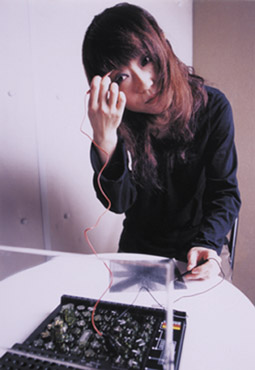
Haco with her Pencil Organ
courtesy the artis
Haco with her Pencil Organ
ONE ARTIST I REALLY WANTED TO MAKE CONTACT WITH WHEN RECENTLY IN JAPAN WAS THE INSPIRATIONAL VOCALIST, PRODUCER AND COMPOSER HACO. IT TURNED OUT THAT SHE WAS IN MELBOURNE AT THE TIME DEVELOPING THE SOUNDTRACK FOR LUCY GUERIN INC’S CORRIDOR BUT ON MY RETURN I JUST MANAGED TO CATCH HER AS SHE WAS BACK IN TOWN FOR THE SHOW’S OPENING. ON OUR WAY TO CHECK OUT 21:100:100 (SEE REVIEW) WE TALKED ABOUT THE BREADTH OF HER PRACTICE AND HER VARIED APPROACHES TO TECHNOLOGY, TECHNIQUES AND COLLABORATION.
Haco first became known through her band After Dinner (1981-91). This early work attracted attention in international experimental music scenes because it combined both Haco’s melodic vocal stylings along with musique concrete techniques. Haco explains: “Nothing digital…we worked with tape splicing. In 1980, I learned recording technology and electronics, music like Stockhausen. I was really interested in tape music. It was really like sampling…We just tried to combine that sort of stuff in a natural balance.”
After Dinner had a shifting line-up of musicians depending on the specifics of the project, and this varied approach to collaboration is perhaps what makes Haco’s practice so interesting. It appears as though each collaboration inspires a particular tangent, or methodology.
On Yesterday’s Heroes,1979 (La Louche, 2004) Haco worked with Terre Thaemlitz to create the new wave band that they wished they had been in back in 1979, recasting their pasts by drawing on their present skills. On the 2000 release Ohayo! Hoahio! (Tzadik, TZ 7230, 2000) she worked with koto player Yagi Michiyo and minimal electronics mistress Sachiko M creating a veritable mixage of genres ranging from pop, to improv and minimalism.
Particularly interesting is her collaboration with cellist Hiromichi Sakamoto. After playing an improvised concert with him, she was listening to his CD and decided that there were hidden melodies in his work. She went on to “redo” his album, remixing and augmenting it to create a new work, Ash in the Rainbow (ReR HACO3, 2003). I asked if he thought this a bit forward of her, but she says that “he was quite happy. He sent new tracks, and we made a tour in Europe together.”
Yet another project sees her working with French Canadian improv artists Martin Tétreault and Dianne Labrosse. After meeting them during a tour in Europe Haco invited them to her studio in Kobe where they ‘cooked’ together. The resulting recording, Lunch in Nishinomiya (Improvised Music from Japan, IMJ-527, 2005), was then mixed and finalised via email.
I asked Haco what she is seeking from these collaborations: is it a pursuit of like-mindedness or difference? She replies: “Maybe a similarity, but not the same. I really love when someone brings me another idea. If I work alone, like on a solo album it’s quite different. But totally different ideas come from [other people]. Even melodic material…”
While her work with others shifts her approaches, Haco’s solo practice also seeks out different directions, technically and conceptually. Parallel to her more pop oriented work she has also pursued more esoteric sound making methodologies. From 2002 to 2005 she was part of View Masters, an environmental sound project that ran annual lectures and performances. During this time she developed her Stereo Bugscope system where she mikes up various devices capturing their electrical oscillations. It was through this work that I first became aware of Haco when she performed a version at Artspace, Sydney during Caleb K’s Typhoon (2005). I’d never imagined that the loading of a blank CD into the hard drive of a computer could be so sonically intriguing. Her explorations of home constructed electronics have continued with creations like the Pencil Organ made from a home electronics kit which allows the human body to become part of the circuitry. Haco is comfortable with diversification in her practice: “My work is quite branched to each project, becoming more conceptual…I enjoy making separate things.”
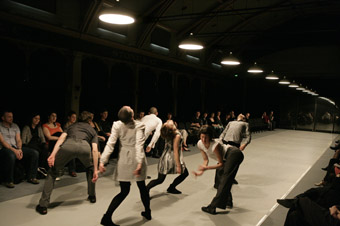
Corridor, Lucy Guerin Inc
photo Jeff Busby
Corridor, Lucy Guerin Inc
While the majority of Haco’s collaborations have been with other musicians and sound artists, she is also interested in working across disciplines. Corridor, premiered at this year’s Melbourne Festival, marks Haco’s second collaboration with Lucy Guerin, the first being, Setting, a dance work developed in a Japanese exchange and for the Melbourne Festival in 2006.
To create the soundtrack for Corridor, Haco wandered the streets of Melbourne, sidling up close to people to capture snippets of conversation. “I needed to do secret recordings. Getting close to people looking like I’m listening to a walkman. I went to a lot of places… a university, a hospital, Victoria Market, on the station, on the street, the art centre, the lobby of an office building…” Guerin then chose specific segments which Haco collaged into a 12 speaker soundscape (running under the audience seating) for the introductory scene of the work. An intriguing choice was the inclusion of a complete track from Haco’s latest album Riska—a sensual, jazzy number about the peace of being in the shower. While at first the lyrics create a slight tangent in the proceedings, they also add a level of solitary sensuality to a work that concerns itself more with the awkwardness of collectivity. Overall Haco’s soundtrack is subtle and restrained, present when it needs to be, but then quietly supportive, often adding layers without drawing attention to itself: all the signs of a sensitive collaborator.
Straight after Melbourne, Haco was going on to participate in the inaugural Nam Jun Paik festival in Seoul where she would be working with her latest collaborator Claudia Triozzi, a choreographer turned vocalist. “She is Italian so she [uses] some traditional opera [style], she has quite a wide range. It’s different from voice improvisation but quite experimental.” It seems that Haco’s collaborations will continue to be incredibly varied and feed the artist’s unique approach to music-making for a good while to come.
–
Riska is out now on Arcàngelo, ARC-1122, 2007
See also John Bailey’s review of Corridor.
RealTime issue #88 Dec-Jan 2008 pg. 44
© Gail Priest; for permission to reproduce apply to realtime@realtimearts.net
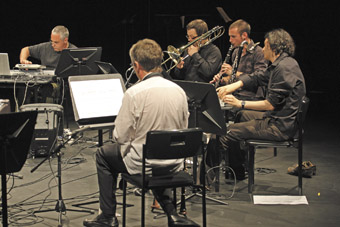
Elision
photo Justin Nicholas
Elision
ELISION RECENTLY GOT TURFED OFF THE ‘GRAVY TRAIN’ OF QUEENSLAND GOVERNMENT ART LARGESSE (NOT MUCH ROOM FOR A SUPPING SPOON IN THAT TINY BOWL) SO THIS CONCERT WAS PROBABLY THEIR LAST IN BRISBANE BEFORE MOVING BASE TO MORE SUPPORTIVE CLIMES. BESIDES NEW PIECES FROM RICHARD BARRETT (UK) AND TIMOTHY MCCORMACK (USA), THE CONCERT WAS AN OPPORTUNITY TO HEAR FROM THE NEW (AUSTRALIAN RESEARCH COUNCIL FUNDED) COLLABORATION WITH LAWRENCE HARVEY’S SOUND GROUP AT RMIT’S EVER INTERESTING SPATIAL INFORMATION ARCHITECTURE LABORATORY (SIAL).
McCormack’s Disfix for bass clarinet, piccolo trumpet and trombone opened the show. The work deconstructs instrumental playing technique into a set of parameters that can work with or against each other. Note from score: “The physical awkwardness and resulting aural distortion of the material implicit in this situation is quite deliberate and intended.” Disfix starts with the three performers standing and facing each other in a close group. Pleasant sounds pop about in a mild, gently hysterical frenzy. Parts break up, jump from one performer to another and then come tightly together in parallel. Phrases are short, silences are brief. Lots of talking and singing through the instruments. Again from the score: “It is of the utmost importance that the performer treats the voice part as an autonomous domain.” That’s while the performer tosses off a few other autonomous virtuosities and keeps time-synched with the others! By the end it all hangs together to give an overall movement from disjunction to cohesion. A difficult work brilliantly played; I could easily listen to it again.
Richard Barrett has been working with Elision for many years and this intimate knowledge of the performers showed in his structured improvisation, Codex IX. A core of the ensemble’s regulars are joined by Joel Stern (and Barrett) on electronics and Jeff Hannam and Michael Hewes, who mix a live feed into speakers set up around and above the audience and performers. The group sits in a wide-ish circle, audience at a tangent on two sides. Sub-bass drones start up with an overlay of light, subtle percussion. Ratchet sounds, more drones, then a burst of tight synchronisation in response to Barrett jabbing out some conducting moves. New section, freeform again, more drones, ululating winds, spatialised percussion. Viola with a string-rubbed roaring. More sections. Loud, soft. Insects and the banging of a screen door. Oboe and clarinet, like a miracle, walk amongst us.
At times electronics or other instruments crack a solo, but overwhelmingly Codex IX is an ensemble piece. Phrases trade across from performer to performer—maybe picking up on the timbre, maybe tracing the pitch movement. The spatialisation is subtle, widening the sound at times, and other-times delaying and shifting a part as though it were echoed by another performer. Similarly the electronics work of Stern and Barrett gives no sense of the tech being bolted on. Notes are picked up, harmonies added in, parts elaborated. So seamless it can be difficult to hear who is playing what. Smooth as can be.
It is ridiculous that a group of this quality had its funding cut by the Minister responsible for the Arts in Queensland. Then again, I can’t find any mention of art or music in the list of personal interests on his Arts Queensland website (www.arts.qld.gov.au/aboutaq/minister.html)
Elision Contemporary Music Ensemble, heliocentric, composers Richard Barrett, Timothy McCormack, performers: oboe Peter Veale, clarinet Richard Haynes, trumpet Tristram Williams, trombone Benjamin Marks, percussion Peter Neville, electric guitar Daryl Buckley, live electronics Richard Barrett, Joel Stern, violin Graeme Jennings, viola Erkki Veltheim, sound spatialisation Jeff Hannam, Michael Hewes, Judith Wright Centre of Contemporary Arts, Brisbane, Oct 4
RealTime issue #88 Dec-Jan 2008 pg. 45
© Greg Hooper; for permission to reproduce apply to realtime@realtimearts.net
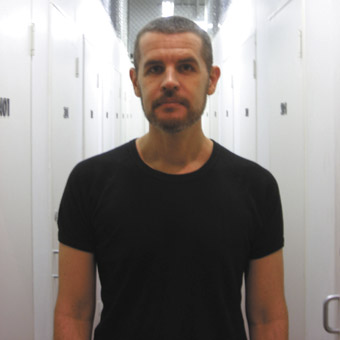
Jason Sweeney
photo Steve Phillips
Jason Sweeney
ON HIS NEW CD, LET THE DARKNESS AT YOU, JASON SWEENEY (AS PANOPTIQUE ELECTRICAL) DRAWS ON SCORES HE’S CREATED FOR PERFORMANCE, DANCE AND FILM ARTISTS (VERSION 1.0, TANJA LIEDTKE, FIONA SPROTT, CHUNKY MOVE, UNREASONABLE ADULTS, PVI COLLECTIVE AND OTHERS) OVER THE LAST DECADE.
The result is contemplative and dreamy, never soporific. The experience feels like (as much as listening is a kind of associative seeing) being drawn slowly through vast star fields (an image we are so used to from film but are unlikely to ever experience)—the pulse of the journey is comforting, spacious, but there is always the sense of something unseen, out of frame, another layer of sound, a brief thundering, a mechanistic blip series, a too real wave of static, a distant voice, another presence approaching, or the heavens about to empty of stars—a never quite ominous entry into sheer darkness. None of this is literally evoked, the album being neither predictably ‘spacey’ nor mindlessly ambient, although late night listening can yield the relief of high quality distraction and the curious comfort of a free-floating melancholy that Let The Darkness At You generates.
Is Let The Darkness At You a collection of examples of your work that simply co-exist or were you aiming for a higher and enduring unity?
I approached this collection of compositions as if I were beginning a completely new project, a new album and indeed a new musical identity. In many ways the pieces that appear on the album began as extracts or minimalist sketches from works that I had made for various productions since 1998. So it was really a process of starting from scratch and re-composing. None of the material on the album appears in the original form it took in the shows or films they were made for. I really was aiming for a sense of sonic unity, a deliberate attempt to create a total listening experience and to be very conscious of not making something that was a disjointed collection of tracks for the sake of putting them out. It’s kind of my instinctive reaction to compilations that labels or artists put out where generally you can only enjoy one or two tracks, whereas with Let The Darkness At You I wanted to make sure that there was consistency in the track sequencing and an elimination process when pieces didn’t feel right. For example, anything with an obvious beat was the first to go! In this way, it’s very much an album of immersive, melodic pieces with intermissions that flow from one to the other. Because the works on this album were written at various times in various places over a 10 year period, there was a challenge to ensure consistency and find themes or motifs and bring them together. In some cases compositions were even mixed to form a single piece.
Are you happy with the album title as a unifying one?
Let The Darkness At You was a name that the label owner, Steve Phillips, applied to the final track sequencing I gave him and it really did seem to sum up the feeling of the record and gives an entry point for listeners. Ideally this album is nocturnal listening…to kind of disappear into darkness or sleep or the night. I spent a long time at night with all of the 19 pieces, literally sleeping with the recording every night for about two weeks after days of mixing tracks. I did this because I wanted the album to be a bit like a sleeping pill or a somnabulistic experience for listeners. I was having a particularly bad case of insomnia during the time I was working on it so if it didn’t put me to sleep then the next day I would have to revisit the album as a whole and re-construct or re-work pieces. My intention is for the album to carry you through a unified listening experience for the whole 80 minutes.
How do you compose for a performer or a company, always from a new beginning or do you build on your body of work?
Each time I am approached to work on a score for performer or company it’s a completely new approach. There might be times where I draw upon a piece that has never been used or was a sketch somewhere else that is stored away, knowing that it might work for the ‘sound’ of the production, but generally I start from scratch. There’s always going to be a kind of ‘sound’ that I produce that might be associated with my previous work but I’m conscious never to impose previous ideas into a new project. But I think there’s always a building on from previous works and learning from the last piece or wanting to revisit phrases in the music.
Do works you collaborate on have a significant impact on your composing?
It really varies, and depends a lot on the artists I am working with. With my ongoing association and collaborations with pvi collective there is kind of an unspoken trust, which I love, when they get me started working on a new project. Sometimes Kelli and Steve from pvi might suggest a kind of sound or play me something they’ve been listening to, but more often than not I’m left to my own devices to construct a score. Other artists I’ve worked with have been much more specific about the sounds they want. When I worked with the late and great Tanja Liedtke (to whom I’ve dedicated a track I was working on for her) she was much more specific about the kind of mood, beat or even specific sounds she was after. It was the making of music for structured and very specifically timed choreography where a dip in the sound correlated exactly with a moment where a dancer would fall or something would ‘shift’ in the performance. This was really exciting for me (and I dearly miss her and her approach to working with artists) as it set new challenges, especially for a musician who was used to finding his own way in to a work.
With pvi collective there is often a scoring of ambience, noise or sounds that ‘places’ people (often roaming the streets in headsets) in a given moment of a performance. So, when they hear music with beats they know it’s time for an announcement or that a member of the public is about to be approached by a performer. It’s like making ‘guide music’ which I really like creating, little signatures. But sometimes the scoring is much more subtle, allowing for a live sound operator to integrate or mix up my music with a live feed of the performers. Working on version 1.0 shows has also set specific challenges because their works are very driven by spoken texts from transcripts and therefore the sound scores have to accommodate a kind of dual listening process. The audience has to hear what is being spoken but, of course, I want people to be affected by the sounds too!
Are you an onsite collaborator or do you look at the work, go away, score it and send it in?
Again, it does vary but I prefer to work onsite when a piece is being made as I’m reluctant to just be a provider of background music. I’m involved quite heavily in performance making so the nature of collaboration as a sound artist is imperative for me in the same way it is to be a performer in a work. I’m a total advocate for sound not just being a secondary concern or a last minute thought or addition to works. All the artists I work with feel the same way, thankfully, and are all interested in sound scoring, from desires for total sonic immersion to pure moments of silence. I like engaging in the various languages of performance making and how to communicate ‘sound’ into these devising processes. However, if I can’t physically be in the room during a creative development of a work I usually have a DVD working copy or constant script updates or ongoing phone or email communication with the artists. I like to work pretty quickly and responsively so I tend to provide a lot of material along the way for people to listen to, comment on, discard, use or to work more on. Again, one of the great pleasures of working long-term with pvi collective is knowing their process and sharing a very intimate devising language which means I can often work on scores for them from a distance.
Do you get to do live mixes for performances?
Ideally, I prefer not to do live mixes for other people’s shows these days, mostly from a purely practical point of view in that I can’t generally be there for seasons or touring due to my own practice. I think the live mix thing has to be a conceptual necessity or an imperative part of the work itself, rather than an artist wanting a composer to do it live because, say, it saves having to make final choices. I really now need to be utterly convinced if someone wants me to do a live mix, outside of what a sound operator can do on my behalf. It is also often a case of me wanting to leave the choice of placement of my compositions up to the artist in the end, which I’m totally happy with. I’d prefer to provide a sound palette for someone to play with that feels right for them because sometimes the composer might not always be the best person to make that choice. Having said all that though, with my own performance work with Unreasonable Adults, I’ll always prefer to be live mixing because it is inherent in the work and the concept.
What are your favourite acoustic and electronic tools for composition, and what’s the dynamic of their relationship for you?
Acoustically, pianos always win the day! Preferably old ones that have been neglected in a CWA hall or found in salvage shops. For me, not coming from a classically trained background, a piano is really the only instrument that I feel friends with. They capture the melancholy and sadness that I desire in making scores. But then, once I’ve recorded a phrase on a piano, it goes through electronic processing in Logic software, which is the primary electronic tool I use. It’s only recently that I’ve started using soft instruments and a MIDI keyboard! I have a tendency to want to work with found recordings too and turn them into melodic phrases, such as finding a malfunctioning speaker in an underground carpark, a crowd in a sports stadium, a shortwave signal from Kuwait and then taking this raw material away, turning it into an emotive chord progression through layering, reverbing, tape delay, pitch shifting. It’s about where the intensities and subtleties are in those sounds, even when they are left raw. I like to degrade everything when I work digitally, to the point where anything clean sounding is almost eliminated. The piano, for example, when put through various stages of amplification or re-recorded through guitar amps, can transform into this epic lo-fi orchestral sound from another planet…it’s beautiful.
Why are you titled Panoptique Electrical? It looks steam punkish and evokes surveillance theory…or is it just another playful persona?
Panoptique Electrical has been the name of my recording studio since 1995. The name really just came about because I loved the look of these two words together. It could roughly translate to being an electronic panopticon but I guess, a bit like the music, it’s open, expansive. It just seemed appropriate, when trying to establish an identity for this accumulated sound work, to take on that name because it is where the sounds originated or got made. I’ve never wanted really to use my own name for recording projects because I want to see them as open to other inputs, which is certainly the case with Let The Darkness At You, which I also see as a collaboration with the record label’s owner, Steve Phillips, who came up with a lot of the track names on the album and also created all of the artwork in response to the music. In the future I’ll be working more with multi-instrumentalists Zoë Barry and Jed Palmer on both recordings and live performances. So there’s a sense of something BBC Radiophonic Workshop-ish in the name or a kind of imaginary sound lab or transmission station which allows for both great experiments to happen but also the potential for sonic failure. Perhaps it’s my ideal location for being an artist, looking out over a wide expanse but attempting to stay covert. Who knows.
Panoptique Electrical, Let The Darkness At You, music by Jason Sweeney, Sensory Projects, CD SRP057
RealTime issue #88 Dec-Jan 2008 pg. 46
© Keith Gallasch; for permission to reproduce apply to realtime@realtimearts.net
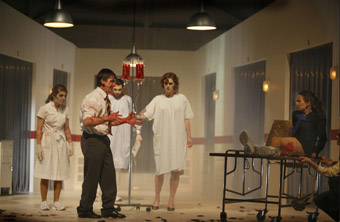
The Zombie State, Melbourne Workers Theatre, Student Union, Union House Theatre, Melbourne University
photo Ponch Hawkes
The Zombie State, Melbourne Workers Theatre, Student Union, Union House Theatre, Melbourne University
A PRODUCTION TEAM OF SOUND, VIDEO, LIGHTING AND SET DESIGNERS, PROFESSIONAL ACTORS AND A GAGGLE OF EAGER UNIVERSITY DRAMA STUDENTS WAS GATHERED BY MELBOURNE WORKERS THEATRE AND THE UNION THEATRE FOR SIX WEEKS OF REHEARSAL TO MAKE A SHOW BASED ON THE CURRENT FRINGE FESTIVAL ZOMBIE FAD. IT IS RECOGNIZABLE AS A DEGUSTATION OF AESTHETIC MOTIFS FROM AROUND MELBOURNE’S THEATRE OVER THE PAST FIVE TO TEN YEARS, AND A FUN WAY TO INCORPORATE INEXPERIENCED ACTORS.
We are in a waiting room, the set captures a compressed perspective of a hospital corridor, a red horizontal line leading from us through limbo to the red doors of hell. A mix of zombies (ghoul make-up) and ‘ordinary’ humans (human make-up) wait in a room with piped muzak. The apparent humans are Jeff, a sleeves-up politician running for the ‘dream job’ of Prime Minister, and his all-female advisory team. In one of two perspex boxes set neatly on either side of the stage, the would-be PM rehearses a promotional ad for his 2021 campaign. The hackneyed deal goes something like this: the (zombie) people are to love eating meat, which they buy with money from work. The united (zombie) people are to serve, while the new, innovative ideas inside the heads of the brightest, best, boldest brains are to be given to Jeff, who works to secure Australia’s place in a rapidly changing world.
The short man and short skirts of team PM take a vote-canvassing tour of the (zombie) people. We see a young man who can’t afford the insurance have his teeth brutally pulled, his chin caked in blood. A doctor can’t stop his repetitive visions of unstoppable bleeding. A teacher, crazily marking papers, uses the endorphines generated by jogging to inhibit sleep. Two shop-girls go from a pseudoephedrine high to lobotomized low. A vampiric stripper, forces herself endlessly on as a hapless youth breaks down in the corner. A bus driver grimly plays his part in a scam by dumping his abducted passengers at a retail warehouse. A cleaner is invited to rent with a ‘working family’ who, having made necessary adjustments, work holidays and choose one child for university. The (zombie) people are a not-quite-human resource. They are addicted to meat and mesmerized by the flames, which literally light up the walls. “Relieving the worker of their family responsibilities” under a “work is life” mantra’ we know this score.
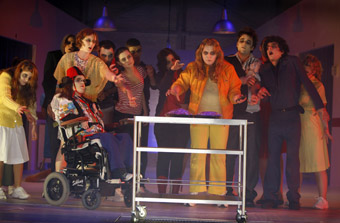
The Zombie State, Melbourne Workers Theatre, Student Union, Union House Theatre, Melbourne University
photo Ponch Hawkes
The Zombie State, Melbourne Workers Theatre, Student Union, Union House Theatre, Melbourne University
The tide turns when a seagull, fried by the flame-stacks of a casino, falls from the sky and attacks the PM candidate. The zombie acting intensifies, the make-up leaches and the movie-sound escalates. By the end, the team PM girls are zombies too, while Jeff admits to being already dead and proposes to “tear (zombie) families apart.” With nothing to lose at all, it seems the seagull/zombie revolt, a bored and desperate violence against others and themselves, is nigh.
For those whose lives have been stripped of meaning in the de-regulated, privatised terror economy of the present, whose meagre savings are evaporating in the sinking mega-banks, who are simply exhausted by the long hours forced on them in the name of global competition, can it be said that class is artificial?
“Just keep dancing in plastic cool. Now I only have to work”, say the zombies, “now I’m free.”
The Zombie State, writer Ben Ellis, director Daniel Schlusser, designer Kate Davis, sound Darrin Verhagen, lighting Niklas Pajanti, Danni Pettingil, video Matthew Gingold, co-producers Melbourne Workers Theatre, Student Union, Union House Theatre, Melbourne University, Sept 16-27
RealTime issue #88 Dec-Jan 2008 pg. online
© Adam Broinowski; for permission to reproduce apply to realtime@realtimearts.net
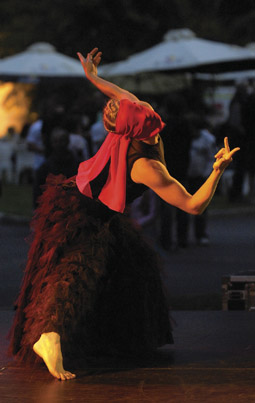
One for sorrow, Two for joy, Tasdance
photo Paul Scambler
One for sorrow, Two for joy, Tasdance
IN RAEWYN HILL’S ONE FOR SORROW, A FACELESS WOMAN IS HIDDEN BENEATH A BLOOD-RED SCARF. THE WARM LIGHT FROM ABOVE CREATES SHADOWS, ACCENTUATING HER FINE FEATURES. MOMENTARILY LIKE A STATUE, THE DANCER WAITS BEFORE MERGING INTO AND OUT OF THE VERTICAL OBLONG OF LIGHT CENTRESTAGE. SHE WALTZES BLITHELY, WITH MORE THAN A SUGGESTION OF POIGNANCY, HER LIMBS EXTENDED AND RELEASED FROM BENEATH A FULLY-FRILLED BLACK LACE DRESS.
One for Sorrow, Two for Joy is an exhilarating, fascinating and entertaining night of multi-faceted, eclectic dance from the dynamic Tasdance ensemble. Six lines from the rhyme One for Sorrow provide the theme for six short works that exhibit a unique array of contemporary dance styles ranging from the robustly physical to the adroitly lyrical and naff, maturely and vigorously performed.
One for Sorrow is a solo taken from Hill’s full-length Mercy: A dance for the forgotten [www.realtimearts.net/feature/search/8457]. Dancer Floeur Adler tells a story of loss, grief and sadness, her lone body speaking of the past as her veiled face holds secrets deeply concealed. Hues of black and red conjure images of death and violence, but these are juxtaposed with the unreservedly graceful innocence and delicacy of Adler’s movement. Her brief solo ends almost as soon as it begins.
Two for Joy, choreographed by Trisha Dunn follows. The box of light shifts horizontally, a trance-like score pounds heavily, two male dancers clad in half silver, half black animate the space with high-energy, acrobatic shoulder-stands and asymmetrical balances. Joyful in their execution, the dancers suggest brotherly bonding as they playfully wrestle, tumble and support one another, tipping and almost toppling over the obstacles each presents the other. Alive, awake, aware, Malcolm McMillan and James Shannon perform with animal instinct and precision. They finish, breathing heavily, shattered.
McMillan, choreographer of Three for a girl, creates a sweet, picturesque tribute to choreographer Trisha Dunn through lyrical movement. The placid articulation of arms, quaint positions of feet and silky motion of the torsos of the three female dancers create a perpetual wave of exquisite detail and fleeting subtleties. The score of piano and harpsichord acts as a catalyst for the fluid sweeping and arching of bodies.
In Anna Smith’s Four for a boy, fingers flex and bend, grotesque in their twists; shoulders rotate like wings and spines torque. Recalled images of ADT’s Devolution flood in as the score creaks mechanically, heavy and frightening. Smith explores physicality and power through both male and female forms. The quartet of dancers are in knee pads. The women are in ultra girlie sunflower-yellow dresses, their faces full of life yet bodies dehumanised, machine-like. Raw and gutsy, they execute the intricate and erratic style of Smith’s choreography, the sounds mirrored in their bodies. With their cleverly structured lifts, spontaneous counter-balances, the risky and fearless dancers are thrilling to watch.
Smith worked with costume designer Greg Clarke to create Five for silver, a visually astounding work. An extravagant, fantastical landscape is formed from bodies amid a sea of silvery-blue, a watery sheath of dreams. This over-sized mass of metallic fabric, with an aperture for each dancer, allows the dancers to intermittently amalgamate and disperse. Detached and concurrently connected by this oceanic costume, torsos sway, coil and undulate in sync amidst the seemingly infinite waves of material.The dancers shift clockwise, a carousel. Legless bodies rotate, fluid and lyrical, creating spirals of shadowed creases, dark velvety crevasses beneath the moon-lit surface. The structure is broken an unexpectedly tender, amorous embrace in a male-female duet.
Six for gold, choreographed by Natalie Cursio and inspired by the television show Solid Gold, parodies the auditions, documentaries and grand finales of outdated TV dance competitions. Daft gold bull masks, numbered leotards and tights along with eisteddfod-style dance moves and exaggerated re-enactments make up this outrageously hilarious work. The hour is up, the night has flown, and the ambiguity of the phrase ‘”Seven for a story never been told” hovers.
Tasdance, One for sorrow, Two for joy, choreographers Natalie Cursio, Trisha Dunn, Raewyn Hill, Malcolm McMillan, Anna Smith, performers Floeur Alder, Carlie Angel, Malcolm McMillan, James Shannon, Trish Wood, design for Five for silver Greg Clarke, lighting Darren Willmott, Parramatta Riverside Theatre, Sydney, Oct 29–Nov 1
RealTime issue #88 Dec-Jan 2008 pg. online
© Ashley Syne; for permission to reproduce apply to realtime@realtimearts.net

Fiona Winning opening Live Works
photo Heidrun Löhr
Fiona Winning opening Live Works
KG In your role as director of Performance Space for nine years, you were obviously a nurturer of emerging work through workshops and various schemes and the promoting of new work programmed annually into the venue. You were also a negotiator dealing with funding bodies, government departments and your board of directors, not least in the transition from the old Cleveland Street venue to CarriageWorks. And you’ve been a collaborator in a variety of partnerships on behalf of Performance Space. And above all you’ve been a leader. You had to make things tick. How would you describe your role?
FW I think it changed over the years. Certainly it was all of those things. In the first instance it was about listening to what people’s needs and ideas and grievances (to some extent) were. And making sense of that to try and build a context that was better for artists. I was always interested in connecting dots between the temporary communities that build through making art and how to find more opportunities to build those communities. I think of it as a boiling pot and the bubbles that emerge are this energy that needs to exist and be released but it also needs to be held together. What I began to realise, not terribly long into the job, was that part of my role was to be responsive but part of it was to be strategic and to really try to make sense of the bigger picture and to build opportunities for artists. So it was a mixture of advocacy, strategic planning and partnering, bringing our own projects as interventions or opportunities, again to build temporary communities that wouldn’t otherwise make themselves.
KG On the one hand you were responsive, reading the scene; on the other you were saying we’ve got to lead the way. When you arrived, what sorts of needs were there?
confidence, communities & generations
FW I think there was a real lack of confidence within the community and indeed among the audiences about the organization and, so, it was a matter of rebuilding what we thought we were. I remember doing a lot of talking with artists who had a long history with Performance Space (yourself included and many other artists and arts workers who had been around the space for a long time), to try to get a sense of what its strengths had been. Of course, I had my impressions of that but I didn’t have a long history at Performance Space. I’d had a fairly long history as a punter and I had made a few shows there but I didn’t see myself as being deeply familiar with the history of the organization. So it seemed to me that we needed to create more consistent opportunities for people to make work, to develop work and to discuss it—and to actually be a community together.
KG There had been various periods when we had that sense. And I suppose that it’s almost inevitable that there are times when those things dissolve, when funding patterns change and, for example quite a lot of senior artists in performance pulled out in the mid-90s, which thinned out the living legacy.
FW And certainly one of the things that interested me in those early years—and I’ve never lost interest in it—is actually taking an inter-generational approach to everything. Part of that was about exchange but part of it was also about being aware of the lineage because I think that’s a powerful and important thing. And it’s probably re-emerging. This is another moment when I think it’s deeply important again. Not that it ever lost its importance but all of these things take work and you sometimes have to focus on something else. And obviously we’ve been concentrating on our new context at CarriageWorks most recently, but we need to bring all that stuff back in.
KG So what kind of things did you engage in in the first three years?
building a residency program
FW Building the residency program into something that was more structured, where people knew what they were getting—space, a little bit of dramaturgical support, a little bit of technical support and a context in which to test the work or show early drafts. Also opening that up to a national call. In the early days what we did with the residency program was to call for “mixed teams” and that could be mixed inter-generationally or mixed inter-culturally. It was important to me and it was mostly inter-generational and it was actually really successful. Version 1.0 got one of those early residencies to make The Second Last Supper (2001), along with a number of other interesting groups. We learned that space was critical and a little bit of support was necessary, though there have never been fees paid to artists in the residency program, People could use the residency then as leverage to get funding for their fees. The work was mostly at the creative development stage. But we also learned that people were really able to use that time and space if they had carved it out for themselves as really invaluable research and development for which, of course, it’s really difficult to get funding. And then they would do the R&D and from that would emerge the clearer idea that they wanted to pursue into creative development.
KG That’s been maintained?
FW It’s probably been one of the most successful parts of the program.
KG How many residencies do you deal with over a year?
FW About twelve of several weeks each. And since we’ve moved to CarriageWorks, because we’re now operating in blocks, we’ve established partnerships with Critical Path and UNSW and the University of Sydney so we can do several off-site residencies throughout the year as well. That’s really about creating a space for people to play, to develop work. In the early days, they were mostly performance residencies but they’ve become more and more diverse; they can be media-based like George Khut’s Cardiomorphologies (2004) which was originally partly developed and tested here and, in that same year, Transmute Collective’s Intimate Transactions and Gravity Feed’s Monstrous Body. Occasionally we would cluster works together that had different approaches to, say, this thing called ‘interactivity.’ Again, that was completely responsive in terms of what was around.
programming, presentation & deals
KG Performance Space has always been a venue for hire but then again you rent space and program work that’s relevant to your brief.
FW I had to move very fast. I was appointed late in 1999 and we didn’t really have a program for the next year. So I programmed three-months in advance rather than 12 months in advance, which is what we do now. We took some rentals that weren’t necessarily things I’d normally curate but I think it was important to do that to get a sense of who was out there doing what, because the networks had collapsed a bit. And of course, we also did some of our own projects. In 2000 we did unBecomings, which was a collaboration with PACT Youth Theatre and Sydney Gay & Lesbian Mardi Gras—a kind of mentoring project for young queer performance-makers. We did a series of these over the years and then moved more into platforms of short works. Meanwhile artists like The opera Project, Nikki Heywood and Tess de Quincey were self-producing their work at Performance Space in our presentation programs. And that was really instructive for me, watching their work. Our role was to create the house around it in logistical terms but also to network the audiences into those projects as well. While people sometimes had publicists, sometimes didn’t, we tried to work to build audiences and connect dots between the works. We continue to do this and it’s a continually shifting set of challenges.
Within the presentation side of things we were working towards having La Pocha Nostra here to do Museum of Fetishized Identities (2001 & 2003) or doing particular shows for Mardi Gras each year. We had no capacity to buy in work whatsoever. It was all about people self-presenting and us either renting them the space (even though they were curated into the program) or doing deals because so many people were only getting funding from either one or other of the funding bodies. In the days before Road to Harmony (although that’s only for triennial clients), there was this incredible schism between State and Federal government, even at project level. So in order to support people to make work, but also have a program ourselves, we would do whatever deals we could to ensure that people could get their work up. So I guess in that sense we became more and more involved not in producing the work but having a hand in the “producing discussions.”
KG It’s not quite co-production.
FW It’s co-presentation, but because it’s not an existing work but is being produced for the first time, it was really about having a little bit more hands-on involvement in the producing, but not actually…
KG And has that improved to some extent with the funding situation, or is it still the same that there are certain shows you’ll need to assist and others can look after themselves?
a new model of co-presenting
FW Absolutely, although the way we now work at CarriageWorks we’ve done a complete shift. In the old days artists paid the rental and they got the box office and we created the context around it: the technical support, front of house and all that kind of stuff. We are now co-presenting in the sense that we offer the space, the front of house, a certain amount of tech support and we are partners in a 60/40 split of box office. So the risk is actually shared. But what’s changed most recently has come with the Presenter Program grants that the Theatre Board of the Australia Council has just given out. Performance Space received one of these, as did Arts House in Melbourne, PICA in Perth and a number of other organizations around the country. That’s $50,000 a year for three years just for artists’ fees. So that means that from next year for the first time we’re actually completely presenting My Darling Patricia, Version 1.0 and Rosie Dennis.
KG So Performance Space will carry most of the risk?
FW We’ll carry all of the risk.
KG And take most of the box office. Companies will get…
FW They’ll get their performance fees paid by us. It’s not a commission. It’s simply a presentation, but it means that the artists know what they’re getting paid. They don’t have to try and balance any books or cut any costs post-production. Partly that’s the Australia Council responding to something that I realised very early in my job, how difficult it is for artists to self-produce, self-present and make the work. And of course it pushes the relationships and dialogue between makers and presenters to another level, which is useful. We also do a lot more auspicing now than we used to do, a lot more management of money and grants, and this of ocurse involves us more in the producing side. It’s something we’ve got a lot better at and it’s a really important service I think, predominantly delivered by Julianne Campbell, our general manager.
dialoguing
FW One of the things we did early on was to collaborate with RealTime on a series of industry forums, sometimes about artform developments and sometimes about industry links or issues. We did a few with other partners. They were really important in bringing people together, again inter-generationally. As we know, some were more successful than others in terms of the content and flow of discussion, but people really did value those events, which is important when you’re trying to cohere ideas and people.
KG They demonstrated a need…I remember the first one we did on Sound at Redfern Town Hall in 2000, there was a great turnout. At none on the series was there ever less than 40 people. For the one on video art IN 2004 there were 100 people. It demonstrated the diverse reach of Performance Space.
FW So as well as presentation, residencies, forums, there were the event-based and platform programs such as unBecomings (2000 & 2001), Eat My Shorts for Carnivale (2001), Antistatic (2002), Pacific Wave Festival (2001 & 2003), Accidents & Alchemies (2004, 2005, 2006), the Lily Shearer-curated Ngal-lo-wah Murrytoola and Nangami Indigenous Performance Events (2007) and, of course, Balir French’s Video Spell, a series of video exhibitions and events over 2003-04. InterSections (2000, 2002 & 2005) was another of these—a series of performances, short works, workshops, forums and we’d do a group lunch together every day for two weeks. They were very modest but really useful events that, again, brought inter-generational and inter-disciplinary practitioners together.
a self-producing new wave
KG We seem to be in one of those interesting periods where there’s a new burst of talent and this one seems stronger than any we’ve had for a while. It includes the likes of My Darling Patricia, Spat & Loogie, Brown Council, Janie Gibson, Matthew Prest, the PACT performers in The Speech Givers and others.
FW Absolutely. PACT has been instrumental in nurturing and continuing to support that group. And the other thing that’s exciting about them—and Spat & Loogie are a great example of this—they’re makers first and foremost, but they’re also curators and producers. They’re so interested in the whole picture. And that’s very exciting because I think there are some artists who continue to see Performance Space as their main kind of place and I don’t think anybody can afford to do that, quite frankly. I think it’s important that Performance Space remains a home and hub but everyone needs to think a lot more rhizomatically than that and have multiple relationships with other partners, producers and presenters out there—and of course with Arts House in Melbourne and Brisbane Powerhouse as well as the Casula. Blacktown and Campbelltown contemporary arts centres now flourishing. There is a better network than there has ever been for artists to tap into.
KG To look to Melbourne, Brisbane, Perth and beyond.
FW The people who are doing that are the people who have thrived. It’s the Version 1.0s, The Fondue Sets and My Darling Patricias, to name a few. And it’s this generation including groups like Post who are at Next Wave in Melbourne one minute, at This Is Not Art in Newcastle the next, in then Brisbane at Under the Radar and at Performance Space, even though their home is perhaps somewhere between PACT and Performance Space. We also have Lara Thoms co-curating the NightTime performance series for Performance Space and she and her peers have set up Quarter Bred at PACT. I think that sort of approach is so exciting.
do it yourself culture
We started Accidents & Alchemies in the last few years we were at Cleveland Street. Then associate director Caitlin Newton-Broad developed NightTime as a series distributed across the year at CarriageWorks. She brought in Rosie Dennis, Trevor Brown and Lara to co-curate each one. It’s worked out on a very simple basis. We pay for the infrastructure and the artists’ fees are based on a door split. It maintains the open call for platforming short works, which is important to bring in people we’ve never heard of, or people you mightn’t think of if you were curating a program in your own head. What NightTime does that’s different is that we decided to work in the public spaces [of CarriageWorks] and to work in the cracks between the program because we want it to be a fast in, fast out. You know, JUST DO IT!” NightTime maintains a DIY culture which has been part of our struggle at CarriageWorks, of course, when you go into that scale of building with a very different infrastructure. NightTime brings different parts of the community together and people either have to bring their own technical apparatus or they’re given a very small technical palette. It takes artists back to a very stripped back set of practices, which is good—fast and furious.
Quick & Dirty is another venture that I think is really fantastic and it’s on at least a three-year pathway. It’s a series of queer performance events working with people who have, since the demise of the funded Mardi Gras festival, struggled to create alternative venues to show that work. A lot of performers have been moving into burlesque but also into self-producing, including Gurlesque, Man Jam AND 34B. So, last year we brought them together. Victoria Spence was a key driver and we did two nights of Queer Performance. Next year, there’ll be three nights and it will morph into something else in the third year. But it’s really about collaboration with those artists and producers. It’s not a Performance Space project as such but it’s a really collaborative one into which we’re hoping to build in an element of sustainability over time. I think that’s an exciting development.
carriageworks: working the building
KG You’ve also hosted some big shows, which have used the foyer space and other parts of the building very successfully. Tess De Quincey’s The Stirring and Joey Ruigrok van der Werven’s Volta, both in 2007. They also offered that sense of occasion, which takes you beyond the normal spaces at the venue.
FW Volta was a project that Joey brought to us, which we produced. It was very specifically about sharing his vision of making work and bringing people who are normally servicing other people’s visions (the lighting and design people) to come in and be the co-creators. It was a great skill-sharing and art-making project. I think when you move to a place like CarriageWorks and you’re learning those physical spaces both technically and artistically and from the audience’s perspective, it takes time. I was fairly naïve…and naivete is quite useful sometimes. I thought that we would be a little bit more progressed into our settling into CarriageWorks than perhaps we are. And I don’t mean to say we’re not settled. It’s fantastic and we love those spaces. But there are sets of negotiations around everything. The foyer is a classic example of that because it’s shared space. So doing the Volta project involved a whole lot of learning curves—as well as being a great project in itself.
KG Yes, you can walk into that foyer and run into two very different events.
FW It was designed as a performance space but if people are flowing in and out of the other performance spaces in the building, it’s really problematic. So you either have to take over the entire building, which was the idea of LiveWorks (though we didn’t quite manage to include Bay 17) or you have to work in between the other programs. That’s essentially why we work in a block structure there, so that we at least know what’s coming in and out of all the other spaces. And, of course, Bay 17 is the thing because it holds up to 800 people who could be walking out into your performance. But I think both CarriageWorks and Performance Space are getting much clearer about how to deal with those issues.
memorable bodies of work
KG What do you see across those years as some of the important works that stayed with you? Obviously Guillermo Gomez-Pena had an impact with Museum of Fetishized Identities (2001 & 2003)
FW Absolutely. Everyone still talks about that. And I guess I’d talk about the emergence of companies like De Quincey Co and version 1.0 with their incredibly dynamic bodies of work. One of the things we do is to take an interest in artists across a trajectory of practice or time. It’s hard to think of specific shows as much as the bodies of work. Watching The Fondue Set grow over the years has been fantastic, and Martin Del Amo—to see his work unfold over the years with key collaborators, Gail Priest in particular, creating those beautiful works very regularly. Tess De Quincey, Julie-Anne Long, Nikki Heywood and Sue Healey are all artists who not only create their own work but also are offering an enormous amount to the younger artists in the community. Then there’s The opera Project, with a new work in the pipeline for 2009, My Darling Patricia, who kicked off at PACT and Branch Nebula—whose Paradise City was developed as part of a residency and to see that commissioned by the Opera House and tour to Brazil and then around Australia was very gratifying.
One of the exciting moments most recently, coming out of a body of work, was Alan Schacher’s The Bland Project. Alan and Jeff Stein and Denis Beaubois, formerly members of Gravity Feed, are all making their own work. Alan’s decision to direct and produce The Bland Project was just one of those moments when I went “Aaah!” It was exciting to see a really lucid set of collaborations between languages: I loved the filmic, the broader visual, the performative and the musical aspects of the production. And, of course, there have been the commissionings of artists like Sussie Porsborg, Sean Cordiero & Claire Healy, and Ruark Lewis & Jonathan Jones that have created both social spaces and great installations for the foyer at CarriageWorks.
live works
KG In a way the LiveWorks festival in September looked like the apotheosis of your career with Performance Space. I don’t know if it was your biggest moment but it seemed like a timely celebration and paralleled the moment of leaving very nicely. We’ve long been desperate for a contemporary performance festival. There hasn’t been one here since the Contemporary Performance Weeks that Don Mamouney used to run out at Sidetrack. How long were you harbouring the plans for Live Works?
FW Ever since we knew we were moving to CarriageWorks, we wanted to do a festival. We didn’t raise the money we wanted. We’d wanted to take over the whole building and use Bay 17, not so much as one huge venue, but as a space you’d walk through to encounter something tiny. When we did Volta at the end of the first year at CarriageWorks, I remember saying we couldn’t have actually done it any earlier. We didn’t know enough about the spaces, we didn’t have the relationships to test some of the things that that show tested. I feel the same about Live Works.
For LiveWorks we turned two of the tracks [large rooms usually used only for rehearsals, residencies and workshops] into theatre spaces which is not what I would normally want to do with them but that’s what the cultural need was. I love the Bay 20 theatre space but it’s big, it takes a long time to rig, so it’s expensive to put work in there. This means it suits highly produced works (or bigger works with more resources). So for emerging companies like Team Mess and artists like Georgie Read whose work we want to feature but we want to show in a quick and dirty or fast and furious way we need to use the tracks. So the POPE (Places of Public Entertainment) licensing of those spaces is really important. For LiveWorks, to get that through, to increase the capacity and use those spaces for performance work that didn’t need as much infrastructure, was really important. And, of course, artistically, it was crucial for us to bring together a whole lot of new work and some existing work, some works that had been tried but not seen in Sydney—Matt Prest’s The Tent being a good example and Paul Dwyer’s Bougainville Photoplay project. And it was really good to bring Panther and Aphids up from Melbourne and PVI from Perth, because it’s very easy to only read about them in RealTime. It’s also about the wider performance community being able to talk to each other in a context that allows the space for that.
KG LiveWorks had that nice inter-generational feel as well—Martin Del Amo and Rosie Dennis and a lot of younger people. And it had a sense of occasion. And you had Pacitti Company from London.
FW Yes. It was great to have them in residence. Finale was a little bit controversial; some people from our community felt that the Australians had not been used well in that work. But actually the people who made the work and collaborated with Robert Pacitti, while they were very clear about some things they did and didn’t love about the process, actually did not necessarily feel badly framed.
KG I thought it was variable. Some people were very visible, others barely there, but that depended in part on where you found yourself in a big space amidst a mobile performance, and a mobile audience.
FW And it was a two-week process. I think one of the problems, and this was logistical for us, was that we had to put Finale in the theatre and we needed to do it over three nights. It was a big work, so it looked like the centrepiece of the festival which, in turn, put a lot of pressure on it, It was a collaboration running alongside the other things that were happening during the week—a peer-to-peer exchange and local artists who had never worked together got the opportunity to play together in a process driven by Pacitti Company. Again, this seeded new relationships and created another temporary community exposed to Robert’s particular way of working.
KG It was certainly worth doing, having that UK presence: the two Pacitti shows (Civil and Finale), Duncan Speakman working on his audio walks, Helen Cole’s collection of performance memories, along with Rosa Ilgen [Norway/UK] making her shoes of hair.
FW Yes, I loved those works too. It was partly the closing chapter of the Breathing Space collaboration with Arnolfini in Bristol. And when I say “closing chapter” I don’t mean there aren’t more things to do, it’s just that Breathing Space has run a cycle. There are Australian artists whom Helen Cole has programmed regularly and her interest in and knowledge of Australian work is really astute. So there is a flow-on for people who weren’t part of the Breathing Space project itself but could have been. I think she has a really strong commitment, wherever she will be as a programmer in the next year or in ten years. It’s the same with me. That’s partly what those collaborations are about. I now have a much clearer picture of a whole lot of UK practice that I didn’t have before.
live art and other beasts
KG The term Live Art is starting to be used in Australia. We know there’s contemporary performance and performance art and there’s this other thing called live art, which has aspects of both. It can be more informal, or theatrical. It can involve works where the artist doesn’t appear but sets puzzles for the audience to solve. It’s fast becoming a blanket term. When you think of My Darling Patricia and shows like The Tent, they’re pretty sophisticated shows of a certain scale and do require money. But then there are the shorter, more mobile works. An artist like Rosie Dennis has found it difficult to find a niche in Australia but she can find it in the UK and Europe. Do you see it happening here, that Live Art dimension?
FW I think it does happen but mostly in galleries, though we are co-commissioning Rosie Dennis’ new work with Arnolfini. One of the things we’re hoping to do for Mobile States is to tour a module of four or five shorter works. One work might be durational, one might be 20 minutes, one might be full length, one might be more installation-based. We always wanted to do that and we didn’t get around to it, we always ended up making a choice to tour works that belonged in a theatre, started at 8pm and finished at 9.15 and might have been dance or hybrid performance or contemporary performance or theatre…And I’m really proud of that body of work that we toured over the last five or six years because I think it is a really interesting survey of work. But, of course, what’s left out is the work that’s not made for a theatre that starts at 8 and finishes at 9.15. That could be short work, the kind we showed at LiveWorks. And that was another reason for doing the festival, to capitalise on those fantastic spaces and try to find intimate moments within that massive architecture. It was also to create a context for beautiful work that sits outside either the theatre or gallery. As presenters we have to create the context for that work and LiveWorks was about doing that.
The Australia Council have opened Mobile States to tender and we’ve pitched a tour around a module or cluster of work so that the spectrum of work that can be presented is wider. It actually comes from understanding the dilemmas of people like Rosie and from me having seen some of those UK festivals like InbetweenTime and the National Review of Live Art. I think that work exists in Australia but it doesn’t prosper. So it’s a matter of us creating special contexts for it. Events like NightTime and indeed EXIST 08 in Brisbane have provided a context for that work. And, of course, Daniel Brine (the new Performance Space director) has a deep knowledge and understanding of live art so that will be a bonus to the contemporary arts community in Australia.
indigilab
KG As well as the Time_Place_Space hybrid arts laboratory [see below] Performance Space ran Indigilab.
FW We piloted this laboratory last year in partnership with Bundanon and next year hope to do it there again. Performance Space initiated the project. That was really about bringing what we had learned from Time_Place_Space [TPS] as a structure to create a black space because we’d always found it quite difficult to attract Indigenous artists into TPS. When we did, we got very clear feedback as to why it was not quite what people needed. So we created Indigilab. Wesley Enoch, Lily Shearer and I brainstormed the way it might work. We didn’t get the money to do the laboratory for the two weeks but we did it for one week with eight indigenous artists from around the country and it was really great. Djon Mundine, Wesley Enoch and Genevieve Grieves were the three facilitators and we’re very keen on seeing a future for that project but, again, we need to build some self-sustainability into it. Sandy Saxon, our Giving Manager is doing some philanthropic work around trying to get that supported.
a collaborative programming team
KG As well as performance, the visual arts and new media arts, dance and dance on screen are strongly represented in Performance Space programming.
FW I would say that one of the most exciting developments in my time at Performance Space has been about the growth that we’ve been able to negotiate and that means that we can officially have expert programmers across a range of forms. I remember talking to Stephen Armstrong at one stage about feeling really isolated in programming and didn’t know what to do. He suggested thinking about the associate director model. So we created that position and Blair French was the first person in that position and then appointed another associate director around performance and media-based work, Caitlin Newton-Broad. And then, the dance producer, Rosalind Richards, is effectively another associate director, but we needed for political reasons to put dance into the title. IN 2006-7 we also, too briefly, had Lily Shearer as our Indigenous Performance Broker, which brought another important dimension to the program. So for me that’s the most exciting development professionally: that we were able to create a truly collaborative programming team that was interdisciplinary, that had great expertise in different areas. We sit down and we talk about the work and what’s driving it and everyone has a desire to understand more about the other art languages that are around the table. For me, that’s been the most fantastic thing.
KG So who are the team at the moment?
FW Rosalind Richards is dance producer. Bec Dean is associate director looking after the installation program specifically but, of course, Bec has an extraordinary background in performance and the performative and an interest in media arts. Rebecca Conroy is also an associate director. She’s a theatre and performance person with very strong inter-cultural connections and experience in running artist-run spaces and public space events. She co-created the Gang Festival [in 2005, a creative exchange with Indonesian artist run spaces].
In the job description for each of these positions is the requirement they bring in new communities of artists and audiences to extend the current world of performance space at any one moment. It’s a fantastic team and a great model because it actually means you have expertise in a range of areas. Where we don’t have expertise, we try to bring people in. So our collaboration with Liquid Architecture is very specifically about that, or getting Gail Priest to curate the What Survives: sonic residues in breathing buildings at Cleveland Street (2006) before we left there. It opens up the possibility of having different people in the program at the same time. Blair French as our first associate director successfully rebuilt our visual arts profile and carved out a particularity within the visual arts culture of Sydney. He was very strategic and I believe led us to secure Visual Arts & Craft Strategy [VACS] funding. We couldn’t do the visual arts program that we’re doing at CarriageWorks without that support. Of course, the integration of One Extra and ReelDance into the Performance Space program has also been important. We were very lucky to be able to support ReelDance—and now they’ve got their Emerging Triennial funding. The funds for dance and ReelDance are separately accounted for from other Performance Space programs.
challenges
KG Integrating Performance Space into the CarriageWorks structure must have very particular challenges—for both organisations.
FW I think the biggest challenge for both our organizations really is the successful realisation of the business model which is for the commercial side to bring in enough money to support CarriageWorks to (a) be able to run itself and some programs themselves and (b) be able to subsidise the small to medium sector. This is the big challenge and it is still very early days.
KG Especially in a tough financial climate.
FW That’s right. It’s extraordinary that we’ve got CarriageWorks at all really. So now the challenge is what is actually happening to the nine hectare site it is part of and what is happening to the commercial bays. Anna Schwartz Gallery is there and that’s fantastic. But, with things like the building’s roof having to be fixed it’s been really difficult for CarriageWorks. I don’t know the exact details but there were funds to subsidise the first three years of activity, which runs out half-way through next year and that’s their challenge and, therefore, our challenge because our destinies are somewhat intertwined.
The other thing I wanted to say is that one of the main constraints is the situation in NSW. On the one hand we’ve got this beautiful building that Arts NSW invested in and created five years ago. On the other hand Arts NSW is pulling away from supporting independent artists through project funding and encouraging them to work as organisations or through existing organisations, but with no extra money. If the government was flush with money and there was more being invested, this might possibly be a good set of moves policy wise. But in this context, it feels really tricky. I think that’s going to be a major issue. Federally the Theatre Board has been moving towards putting more resources into presenters and producers but they still need the independent artists to bring the money for their projects with them. So on the one hand we’ve got this new big picture being presented by the Australia Council and it’s just simply not able to be matched at a State level. So I think over the next 5 years, this is going to create a big tricky world for us all.
the next stage
KG Most artistic directors leave not only a long term legacy but often programming for the coming year. Presumably with your program managers you’ve set up things for the new director, Daniel Brine, to work with?
FW The program is predominantly in place for next year, which gives Daniel the opportunity to concentrate on public programs, an area of particular interest for him. Our first 18 months at CarriageWorks was a major learning curve involving a major re-thinking about ourselves, about getting the work in, about how to support artists in the CarriageWorks spaces, about our presentation model and about our technical realisation in those big spaces. The second 18 months has been more around profile and marketing and audience development. And the public programs are really about that. So that’s the next focus. Daniel, of course, also has to write a business plan by the middle of next year, so we agreed that it would be a good thing for us to do most of the programming for next year so he could concentrate on the public program, the orientation and the business plan, which is big enough really.
what’s next & time_place_space asia
KG And for you, what’s next?
FW I actually don’t know. We’re doing Time_Place_Space no. 6 which I’m co-curating with Sarah Miller, Teresa Crea and with Margie Breen as project manager. That will happen in January-February next year in Brisbane. Time_Place_Space [TPS] is something that I’m very proud of. I was talking earlier about the importance of building temporary communities. There have been really substantial collaborations that were seeded at TPS. It’s so necessary because so many artists still feel quite isolated, particularly if they think of themselves as a hybrid performance maker or new media artist in Townsville or Perth, or even Sydney sometimes. So one of the strategic things we were doing with TPS was to work with the Australia Council and with Asialink to do an inter-cultural, interdisciplinary lab call TPS Asia. (That’s just the working title.) This TPS is inviting a number of delegates—curators, artists, producers and funding people—from various Asian countries to see the model in action in the hope that we can then create partnerships to do TPS in a number of Asian countries.
KG You’re probably not suffering separation anxiety yet, about leaving Performance Space.
FW No, but I do feel incredibly lucky to have had that job. Now I’d like to do some writing. And I know what my passion is. I love programming. And I love working with artists through that trajectory of concept development, through to production and touring. Performance Space does all those things, not with each work all the way through, but dipping in and out of different parts of that process. So finding another context in which to be able to do that is going to be my greatest challenge.
RealTime issue #88 Dec-Jan 2008 pg. online
© Keith Gallasch; for permission to reproduce apply to realtime@realtimearts.net
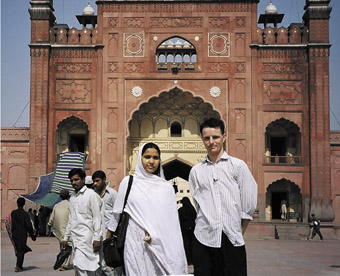
Donkey in Lahore
THE VANCOUVER INTERNATIONAL FILM FESTIVAL (VIFF) IS A PERFECT EXAMPLE OF THE WAY THAT FESTIVALS PERFORM TWO OPPOSITE FUNCTIONS: THEY ALLOW PEOPLE TO SATISFY THEIR CURIOSITY ABOUT THE FOREIGN AND THE UNFAMILIAR, WHILE ON THE OTHER HAND, THEY CAN ALSO BE INTENSELY LOCAL AND PAROCHIAL. THIS TRANSLATES TO TWO MAIN PROGRAMMING STRANDS. THE DRAGONS AND TIGERS SECTION ON NEW ASIAN CINEMA HAS BEEN RUNNING FOR 15 OF THE FESTIVAL’S 27 YEARS. IT GIVES VIFF ITS INTERNATIONAL REPUTATION, AND THIS YEAR DREW REPRESENTATIVES FROM MOST OF AUSTRALIA’S FILM FESTIVALS. IN THE SECOND WEEK OF THE FESTIVAL, THIS STRAND GIVES WAY TO THE CANADIAN IMAGES FOCUS, WHERE NATIONALISM IS PAID ITS DUES.
Given Canada’s status as a Commonwealth country whose nationalist impulses are generally constructed through finding ways to distance themselves from the overpowering presence of the United States, there are grounds for considering analogies between Australian and Canadian film production. This is no new idea, dating back to the influence of John Grierson in founding the National Film Board of Canada and providing the conceptual basis for documentary production in Australia.
When Susan Dermody and Elizabeth Jacka wrote their history of the Australian film renaissance at the end of the 1980s [The Screening of Australia, Vol 2: Anatomy of a National Cinema, Currency Press, Sydney, 1988], they referred disparagingly to the possibility that the Australian cinema might become prone to “Canadianisation”, that is, it might become a place overtaken by Hollywood production. Closer to the present day we have the meagre domestic box office of both industries and similar government responses divided between location subsidies to attract Hollywood (we should be so lucky as to be Canadianised!) and tax credits to encourage the locals.
The films shown at VIFF this year encourage a further analogy between Australia and Canada based on a growing interest in the othering of the cultural mainstream.
deepa mehta’s heaven on earth
It was significant that directors whose reputations are tied to their cultural otherness made the most prominent Canadian films at Vancouver this year. Deepa Mehta (Earth, Water, Fire) is an Indian-born Canadian resident who makes most international middle-class viewers’ favourite Indian films. While she has moved her production activities back and forth between Canada and India, Mehta has constantly foregrounded the ways in which Indian cultures victimise women.
Her new film Heaven on Earth (you ought to be able to guess that the title is ironic) is no exception. Bollywood star Preity Zinta plays the decidedly anti-glamorous role of a battered wife in a Canadian-Indian family. There’s not a lot in the film to surprise you with the familiar narrative arc of (1) woman as victim, and then (2) victim finds her inner strength. One of the more interesting things about the film is how matriarchal families produce and reinforce positions of oppression for women. Chand, the protagonist, finds her strength to resist from the inspirational story given to her by her mother, but Rocky the brutish husband is a mummy’s boy who beats his wife with his mother’s consent and tacit encouragement.
While India is heat and colour, Canada is cold and blue. The power of the matriarchy is the constant between the two, suggesting that power over sons is a very different thing from power over daughters. Mehta suggests that maternal power over sons breeds a resentment, which finds its outlet wherever it can—and usually this means spouses.
atom egoyan’s adoration
Atom Egoyan (Exotica, The Sweet Hereafter) is perhaps Canada’s best known art cinema director given that he has never been tempted into genre filmmaking and enticed south of the border like David Cronenberg. Critics have made much of Egoyan’s Armenian-Egyptian background, though he has lived nearly all of his life in Canada. His new film Adoration returns him to familiar territory where a slowly tracking camera moves constantly across the surface of a brooding landscape. Conversations always appear pregnant with meaning as every utterance gestures towards something more.
A schoolboy creates an online sensation by revealing his father’s terrorist attempt to blow up an airliner. Things are rarely what they seem however, and terrorism becomes a symbol for more intimate forms of dysfunction. Egoyan’s narratives (think of The Sweet Hereafter) often work through reference to some primal trauma, and this is no exception. For Egoyan’s characters, the present is generally a way of working back to the past. His films are the fictions of inwardness and, for them to be effective you need to find the right wavelength for encountering their specific form of stylisation.
There is a lot of blather in the film about online discussion of morality, about the lack of an imaginative understanding of the sufferings of people from Middle Eastern cultures, but the terrorism that Egoyan sees as the model for all trauma and revolt is that inflicted within families. At this level, perhaps his film enters into a conversation with that of Deepa Mehta.
So what’s the bridge back to my analogy between Canadian and Australian filmmaking? For all of the rhetoric of cultural nationalism, all of the Daryl Kerrigans and Crocodile Dundees, of telling our own stories, the most fruitful strand of Australian cinema comes from the engagement of Australia and distinctly separate cultures. I’m thinking here of the tradition of Film Australia docos in Papua New Guinea, the South Pacific and Asia.
australia & other people’s stories
The contemporary inheritors of this tradition can be found in the work of George Gittoes in the Middle East, or in recent films such as Benjamin Gilmour’s Son of a Lion made in Pakistan. The Australia represented by (if not in) these films is not the inward looking one conjured up by the rhetoric of a nationalism obsessed with its own stories. Rather it is the Australia that has finally started to look outward at its region, to insist that Australia must engage with the people of the Middle East on a personal basis and not just through superpower politics.
The case in point at VIFF was Faramarz K-Rahber’s documentary Donkey in Lahore. The Australian-Iranian documentarist, who is based at Griffith University, follows a Queensland goth puppeteer in his unlikely pursuit of Amber, a young Pakistani girl with whom he fell in love during a brief stay in Lahore. Brian (or Aamir as he renames himself after his conversion to Islam) is an unlikely hero but clearly a romantic in every sense of the term. He takes in his stride the repeated kicks in the head the world delivers to him, reasoning that sooner or later, it is only reasonable that brute reality will have to lie down in the face of his ambitions.
The most interesting thing about the film is the way K-Rahber starts to function as a go-between for Brian/Aamir in Pakistan and an interpreter of his actions for viewers of the film. The film neatly reverses the cultural politics of much traditional anthropological filmmaking where Anglo-Australian filmmakers occupy a high ground of knowledge and truth, explaining the quaint ways of the natives.
Donkey in Lahore gained additional stature from the comparison with The Convert, a Thai film in the Dragons and Tigers section. This documentary also tells the story of a woman who converts to Islam in order to marry. The problem here is that the filmmakers simply don’t have much that is very interesting at which to point the camera. This is a problem compounded by the fact that the couple who are the subject of the film obviously participate in the shooting of it. Rather than the growth of a productive (if potentially painful and embarrassing) relationship between filmmaker and subject, there is a closeness here which seems to preclude insight, as if you don’t want to pry too closely into the troubles of someone close to you.
So, maybe this is the conclusion to bring away from Vancouver: to praise not the telling of our own stories, but the curiosity to stick our noses into the stories of those who are different from us.
Vancouver International Film Festival, Vancouver, Sept 25-Oct 10, www.viff.org
RealTime issue #88 Dec-Jan 2008 pg. 18
© Mike Walsh; for permission to reproduce apply to realtime@realtimearts.net
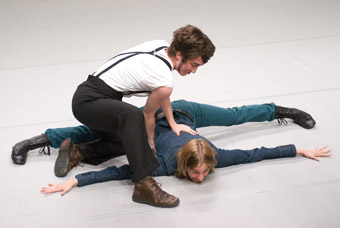
If I Sing to You, Deborah Hay Dance Company
IN THEATRE, THAT OL’ BRECHTIAN ALIENATION EFFECT IS ABOUT AS CONTEMPORARY AS IAMBIC PENTAMETER. IF THIS YEAR’S MIAF WAS ANYTHING TO GO BY, THOUGH, AESTHETIC DISTANCING IS THE BIG THING IN DANCE TODAY. KRISTY EDMUNDS’ TIME AT THE HELM HAS ALWAYS BEEN MARKED BY A STRONG CHOREOGRAPHIC FOCUS AND IN HER FINAL YEAR AS ARTISTIC DIRECTOR SHE PRODUCED A PROGRAM WHICH BOTH SHOWCASED THE DIVERSITY OF DANCE AT THE CUTTING EDGE WHILE MAINTAINING—PERHAPS INCIDENTALLY—CERTAIN COMMON THREADS INTERWOVEN THROUGHOUT THE FESTIVAL.
From Deborah Hay’s “counter-choreography” to Chunky Move’s literal interrogation of process, the dance works on offer variously deconstructed, reinvented and defied conventional expectations of the form. Of course, frustration as an aesthetic goal has its obvious limitations—in asking an audience to think about dance, the sheer wonder of performance can slip away in favour of a purely intellectual appreciation.
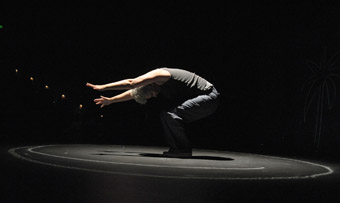
Wendy Houstoun, Desert Island Dances
wendy houstoun’s desert island dances
The perfect contrast in this sense would be Wendy Houstoun’s coolly rendered Desert Island Dances and the vast, impenetrable Sunstruck by Helen Herbertson and Ben Cobham. Houstoun’s solo performance was an oral meditation on the history of movements she has acquired or been given over her long career, a cerebral exercise which purposefully prevented the audience’s immersion in its physicality by constantly pulling back to discuss it. Sunstruck, on the other hand, was an event of pure dance that challenged its spectators’ ability to rationally understand it, instead creating an intensely overwhelming experience that could not be reduced to words. In this sense, Sunstruck truly merits the term ‘sublime’, a word overused in arts writing and seldom deserved.
Houstoun is a leading artist who has worked with an enviable range of fellow dance- and theatremakers, including Lloyd Newsom’s DV8 and Tim Etchells’ Forced Entertainment. Etchells’ influence is especially evident in Desert Island Dances (and as a side note, it could be argued that Forced Entertainment has been the most profound influence on a massive range of Melbourne theatre at the moment, too). Desert Island Dances relentlessly questions the act of performance-making and liveness; like Forced Entertainment’s Bloody Mess, it attempts to invoke a sense of immediacy and spontaneity while actually maintaining an incredibly tight structure and logic. Houstoun talks her audience through a series of speculative moments: what if this happened? And what if I did this? And what if I then did this? It all seems loose, off-the-cuff, a performance always on the verge of beginning. But in this constant deferral, Desert Island Dances becomes a very cool work. Houstoun appears a fascinating dancer who only occasionally allows us to witness her, well, dancing. Moreover, the restrictions of the work’s solo nature become evident. It’s difficult to create a dialogue around dance-making when there’s only one voice to discuss it.
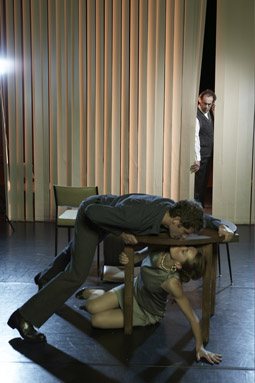
Two Faced Bastard, Chunky Move
photo Chris Budgeon
Two Faced Bastard, Chunky Move
chunky move’s two faced bastard
Chunky Move’s Two Faced Bastard explores similar territory to far more sophisticated effect. A large playing space is bisected by a curtain of vertical blinds; the audience is split in two, one half on either side. The work we see depends on our placement—on one side an abstract, contemporary dance begins while on the other a panel discussion on performance occurs. There’s a certain bleed between the two from the outset. The gently swaying blinds allow infrequent glimpses of “the other side” while the microphoned forum can be heard in both halves of the space. And soon enough, the collision of worlds becomes more obvious, as performers enter one another’s space and influence their new surroundings. Brian Lipson interrupts dancers to question the meaning of their movements; a relationship begins between dancer Stephanie Lake—who is situated on the “dance” side throughout the performance—and actor/dancer Vincent Crowley, who begins as a pivotal figure on the discussion side.
As things proceed, the engagement becomes more hysterical. At one point performers suit up in robotic battle outfits fashioned from boxes and polystyrene and charge through the curtain to wage war on their counterparts. At another, the audience is offered the chance to cross the stage and see what effect a new perspective will provide. And at no point are the performers able to step offstage; with no wings to speak of leaving the playing space simply means moving into another.
What all of this results in is a wonderfully dialectical form of performance. It is the presentation of conflict—between action and interpretation, dance and theatre, body and mind—which creates a third space of meaning. For much of the work we are acutely aware that we’re missing out on something, that our position only affords access to half of a work. But when, finally, the curtain pulls aside and all of the performers are made visible across the space, we realise that this concealment is itself an integral part of theatre, and that what we have been watching all along has been a single, coherent work, not two distinct productions which intersect at vital points.
Two Faced Bastard’s duality is probably due to the differing interests of its creators—it feels at times to be an exchange between Lucy Guerin’s focus on the moment of dance, on dance as a form of presence, and Gideon Obarzanek’s more conceptual explorations of the framing of works. It’s a deeply intriguing, and often very funny exchange, and it’s also apparent that the performers themselves have been crucial to the formation of the work.

Corridor, Lucy Guerin Inc
photo Jeff Busby
Corridor, Lucy Guerin Inc
lucy guerin inc’s corridor
Several of Two Faced’s dancers also contributed to Guerin’s Corridor, a work that more closely adheres to the ongoing investigation of the theme of communication which has marked much of the choreographer’s output. Here, it is the way in which movement itself is communicated from one body to the next which is put into relief: set along a narrow strip bordered by an audience row on either side, the dancers ‘pass’ motion to one another in a variety of ways. Instructions are given via microphones, MP3 players, whispers and written text. Spontaneous choreography bounces back and forth along the space as dancers imitate one another’s moves; and the signal distortion increases as dissimilar bodies hastily attempt to replicate a particular phrase created by a distant figure.
Like Two Faced Bastard and Desert Island Dances, Corridor is dance about dance, in this case the process of instruction and translation of motion. It also serves up many memorable sequences of actual movement, preventing it from becoming a navel-gazing exercise or a piece which undermines itself in order to provoke. It’s smart, witty and very rewarding.
deborah hay dance company, if i sing to you
Deborah Hay occupies a different stratum entirely: the veteran US choreographer has created a vocabulary of dance that speaks to her contemporaries while remaining utterly distinct. She challenges her subjects to unlearn the inherited movements of their history; to become aware of the body’s momentary existence in any particular spatial and temporal environment; and to respond to the cues sent by this body in every instance. Hers is a kind of cellular choreography, and she asks her dancers to try to sense the signals of the trillions of cells which make up a single human figure. She has written extensively of her craft, and the writing is often obtuse and provocative in its esoteric nature. But it was a privilege to witness Hay’s theories in action, and If I Sing to You is a difficult but unforgettable experience.
The six dancers themselves appear a kind of sluggish organism as the work commences. It’s hard to delimit a particular starting point as they stand vacantly while the audience take their seats, and no conventional cues—the dimming of house lights, for instance—occur to mark off the performance. They stand closely, swaying slightly, surveying their surroundings. We are not watching six bodies performing. We are watching bodies ageing, evolving, existing. They may make noises. They may shift a foot, or lean, or react to another’s leaning. They are listening and watching.
Over the next hour, these dancers don’t dance. At least not in a recognisable sense—there is much movement, but it is startling in its unexpectedness. As trained performers, of course, these movements are not naïve, but are instead a kind of physical version of the negative space of visual art, the physicality that is made absent by choreographic convention. Hay forces her audience to think about dance not by telling us to do so—as does Houstoun’s work—or by explicitly exploring the problematics of thinking about dance, in the way that Chunky Move succeeded in doing. Hay simply does something so different that one’s preconceptions need revising.
If I Sing to You’s dancers are all female but decide upon the gender of their performance shortly before it begins. Some will dress in male attire if they choose, and the result will apparently affect the dynamics of the performance. Apart from a hilariously oversexed routine in which a facially-haired performer indulged in some animalistic thrusting, this conceit didn’t really contribute much to the performance I witnessed. This is a minor quibble, however. For a newcomer to Hay’s work, this piece was confounding, brilliant and impossible, without any dressings.
helen herbertson & ben cobham, sunstruck
And so to Sunstruck. In a gigantic, pitch-black warehouse in a remote area of Melbourne’s Docklands huddled a ring of chairs. Two dancers moved around the space. A lofty golden light on a rail-track circled behind us, casting luminescence and shadow upon the pair. It was a sun; we watched a world. The shifting light made shadows dance, evoking planetary cycles, a human sundial or shifting continents. There was no context, no explanation, but this interpretive openness conjured up uncountable possibilities. The two performers presented a rich contrast, Trevor Patrick a brittle, pointed form to the earthy muscularity of Nick Sommerville.
After the many, often successful choreographic experiments of the 2008 MIAF, Sunstruck alone seemed to genuinely achieve that daggy, old-fashioned result so rarely sought these days—theatrical magic, and the sheer wonder of the living body.
–
Melbourne International Arts Festival: Desert Island Dances, devisor-performer Wendy Houstoun in collaboration with John Avery, music John Avery, lighting Nigel Edwards, Arts Centre, Oct 9-13; Chunky Move, Two Faced Bastard, direction, choreography Gideon Obarzanek, Lucy Guerin, performers Vincent Crowley, Antony Hamilton, Michelle Heaven, Stephanie Lake, Brian Lipson, Byron Perry, Lee Serle, design Ralph Myers, lighting Philip Lethlean, costumes Paula Levis, composer Darrin Verhagen, Arts House, Meat Market, Oct 8-12; Lucy Guerin Inc, Corridor, choreography Lucy Guerin, performers Sara Black, Antony Hamilton, Kirstie McCracken, Byron Perry, Harriet Ritchie, Lee Serle, sound design Haco, set design donald Holt, lighting Keith Tucker, costumes Paula Levis, Susie Gerraty, Arts House, Meat Market, Oct 16-25; Deborah Hay Dance Company, If I Sing to You, choreography, direction Deborah Hay, performers Michelle Boulé, Jeanine During, Catherine Legrand, Juliette Mapp, Chrysa Parkinson, Amelia Reeber, Malthouse, Oct 19-21, Sunstruck, by Helen Herbertson, Ben Cobham, director Helen Herbertson, performers Trevor Patrick, Nick Sommerville, design, lighting Bluebottle, Ben Cobham, set realisation Alan Robertson, soundscape Livia Ruzic, music Tamil Rogeon, Tim Blake. Shed 4, North Wharf Road, Docklands, Oct 13-18
RealTime issue #88 Dec-Jan 2008 pg. 2
© John Bailey; for permission to reproduce apply to realtime@realtimearts.net
PREMIERING AS PART OF THE MELBOURNE INTERNATIONAL ARTS FESTIVAL, JENNY KEMP’S LATEST WORK, KITTEN, DRAWS INSPIRATION FROM THE STORY OF ICARUS. THE WAX AND FEATHERS ARE GONE, REPLACED BY NEOPRENE AND MICROPHONES, AND KEMP’S FASCINATION LIES NOT WITH THE YOUTHFUL CURIOSITY OF ICARUS NOR WITH THE NATTY CRAFTSMANSHIP OF DAEDALUS, BUT WITH THE NARRATIVE DYNAMIC OF THE MYTH, ITS FREEFALLING VERTICALITY.
However, Kemp inverts the arc of Icarus and begins underwater. A woman, Kitten, realises her husband, Jonah, has somehow descended from the cliff outside their house and disappeared into the waters below. Her husband’s friend, Manfred, continues the archetypal nomenclature and acts as a well-worn third wheel. The ensuing action, narratively speaking, follows Kitten as she and the watchful Manfred search for Jonah but find each other—a romantic structure as old as L’Avventura. Like Antonioni, Kemp is not interested in the narrative suspense of the search, but on the other hand, neither is she interested in the relationships. The only driving force behind Kitten is the internal life of the eponymous character.
This life is refracted through the prism of Kitten’s triple casting. Margaret Mills and Natasha Herbert, regular collaborators with Kemp, as well as Kate Kendall, don’t play vastly different versions of the role, but their combined energies suggest the fracturing of Kitten’s mind. Beset by the trauma of Jonah’s disappearance, Kitten is plunging through her grief without rational anchor points—Manfred is a characterless vacuum, only capable of bankrolling Kitten’s increasingly tangential searching.
In the end, Kitten’s freefall takes her, and the audience, from the thick, submerged world of the first act, through the temperate naturalism of the second act into the stark, clinical clarity of a psychiatric ward. At this point, jumping into a liminal space of polar bears and inflated tuna, Kitten performs a concert. Kemp stays true to her inversion of the Icarian arc and finishes with this theatrical parachute, a floating denouement, where the audience leaves the theatre to find themselves in Crete.
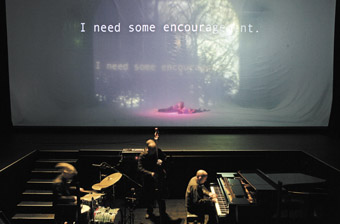
Back to Back with The Necks, Food Court
photo Jeff Busby
Back to Back with The Necks, Food Court
There are no parachutes in Back to Back’s Food Court. Bruce Gladwin and his team of co-creators have produced a formidably terrorising piece of theatre that also achieves astonishing beauty.
Back to Back is a remarkable company in itself, not least because it maintains a steady ensemble of actors. Throughout the company’s 21-year history, these actors, all with disabilities, have aimed at challenging audiences to reconsider their “unspoken imaginings.” Within this paradigm, the pieces that are created also serve to challenge and re-energise the performers—the ensemble’s welfare being integral. However, to regard the company’s work as primarily therapeutic denies the danger of the theatre that is produced and merely serves to reaffirm the binary of abled/disabled that is being deconstructed.
Food Court begins and ends with music. Led to the orchestra pit by torchlight, the inimitable trio of The Necks begin by building a slow trickle of sound in the dark—a cymbal scratch here, a solitary chord there. Their music has always created a sense of inevitability. Its driving pulse and dynamic is constantly building towards a climax that never quite arrives and a resolution that leaves no conclusions, simply space for silence.
In Food Court, The Necks meet their theatrical parallel. The action onstage opens in front of a curtain with a lone man placing a chair in the darkness. He then walks downstage, removes a white marker from the floor, and places it at the foot of the chair. A brilliant conceit—is the mark wrong, or is he? And in that question, in that moment, we are faced with our own judgment and perhaps taken aback by his confidence, his precision and his comedic sensibility. It is the first delicate, perfectly-pitched note.
Then, like figures from a Diane Arbus monograph, two women, clad in lurid gold leotards, take to the stage and begin an innocuous conversation. “Have you ever eaten a hamburger?” But with the arrival of a third woman at the other side of the stage, their attention and manner shift markedly. They begin to tease her about her intellect, her personal hygiene and her weight.
The barrage of abuse continues and becomes both abstracted and reified behind what appears to be a plastic scrim. In fact, it’s an inflatable cube of plastic that diffuses the shapes inside it while providing front and rear screens on which to project images and text. Beyond its practical attributes, the bubble acts like a Jungian ewer of the objective psyche—displaying a dreamlike state of archetypes engaged in sadism, torment, desire and struggle. Throughout this, The Necks drive on, carrying us through a forest of our own shadows.
Finally, our voiceless victim finds herself alone. It has taken 50 minutes for her to speak and, when she does, her voice cracks the air with a rush of forthrightness tinged with venom. She speaks the words of Shakespeare’s Caliban (“Be not afeard; the isle is full of noises…”) and, in so doing, throws off and embraces the weight and complexity of theatrical representation and history, leaving us both punctured and inspired.
Shakespeare is given another rather different outing in OKT/Vilnius City Theatre’s accomplished production of Romeo and Juliet. The Lithuanian company is headed by the wry, floppy-haired Oskaras Korsunovas, who treats the text with élan—setting the action in rival bakeries and giving the story both the seriousness of social drama and the pep of bawdiness.
Korsunovas’ first gambit is a textless overture of competition, envy, sex and curiosity. The large cast immediately display their physical agility and alacrity, zipping from vignette to vignette across the steel bench tops. The set has both the whimsy and the darkly fantastical detailing of a Jeunet and Caro film and the posturing of the Montagues and Capulets is cleverly undermined by the mirror-image sameness of their respective kitchens. Korsunovas reveals that, for all their fear and loathing, their differences are merely imagined, yet this, in turn, renders them all the more tragic.
From this departure point, Romeo and Juliet steadily develops and expands. It captures the expressive youthfulness of its romance and matches it to the deep ferocity of its older generations. It also builds up a bank of imagery based on the vocabulary of the kitchen—ladles become weapons of masculine scorn, flour gives both life and death—that pulls the play back into the concrete world of social drama without in any way diminishing it. As it began, the production concludes wordlessly, but now, rather than hubristic poses, the tragedy is rendered by a silently aching collapse.
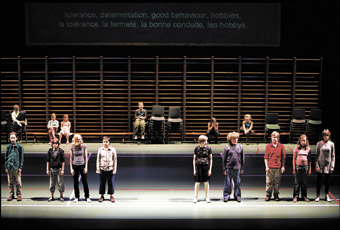
Victoria, That Night Follows Day
photo Phile Deprez
Victoria, That Night Follows Day
In Tim Etchells’ That Night Follows Day, there is no such poetic physical imagery. That is not to say that there is no poetry—the wonder of this production is in its essentialism. Working with the Belgian company Victoria, Etchells has crafted a brilliant provocation in a deceptively naïve guise.
The cast of sixteen children are a chorus of voices listing with mantric clarity the ways in which adults construct the cosmos around them—“You feed us. You dress us…You tell us to be quiet…You act surprised.” The children stand across a stage decked out in the features of a multi-purpose school hall. It is a beguiling and carefully created simulacrum—the chairs are the right size, the playground antics seem genuine, the screen for surtitles even has the powdery finish of a chalkboard, surely the clothes worn by the children are their own. Of course, the clothes are not their own, they are costumes, and the playground scene is choreographed, after all, this is theatre, this is artifice. But Etchells also knows that his audience of adults look to children not for artifice but for authenticity, for that elusive prelapsarian truth.In this respect, That Night Follows Day is as much a show about theatre as it is about the adult-child connection. Like Food Court, it engages the audience with an artifice that subtly subverts the traditional discursive structures of spectatorship—not by literally stamping on theatrical convention but by metaphorically returning the audience’s gaze. As a result, both pieces provoke questions, not answers and shift our perspectives rather than merely pleasing them.
Melbourne International Arts Festival: Malthouse, Kitten, writer, director Jenny Kemp, performers Chris Connelly, Natasha Herbert, Kate Kendall, Margaret Mills, designer Anna Tregloan, composer, sound designer Darrin Verhagen, lighting Niklas Pajanti, choreographer Helen Herbertson, Malthouse, Oct 8-25; Back to Back Theatre, Food Court, director, designer, devisor Bruce Gladwin, performer-devisors Mark Deans, Rita Halabarec, Nicki Holland, Sarah Mainwaring, Simon Laherty, Scott Price, Sonia Teuben, Brian Tilley, music The Necks, set design & construction Mark Cuthbertson, lighting design, technical direction Andrew Livingston, bluebottle, animated design Rhian Hinkley, sound design Hugh Covill, costumes Shio Otani, Malthouse, Merlyn Theatre, Oct 9-12; OKT/Vilnius City Theatre, Romeo and Juliet, writer William Shakespeare, director Oskaras Koršunovas, set design Jurate Paulekaite, Arts Centre, Playhouse, Oct 22-25; Tim Etchells and Victoria, That Night Follows Day, concept, text, direction Tim Etchells, design Richard Lowdon, lighting Nigel Edwards; Malthouse, Merlyn Theatre, Oct 22-25
RealTime issue #88 Dec-Jan 2008 pg. 3
© Carl Nilsson-Polias; for permission to reproduce apply to realtime@realtimearts.net
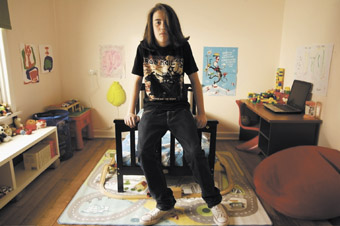
The Meaning of Moorabin is Open for Inspection
photo Michael Williams
The Meaning of Moorabin is Open for Inspection
ANY WORK OF ART IS A WORLD UNTO ITSELF; ONE THAT ALSO ATTEMPTS TO COMMUNICATE TO OTHERS ITS OWN IDIOSYNCRATIC CULTURE. IN RECENT TIMES THIS LINE OF COMMUNICATION HAS MOSTLY RESIDED WITHIN AN HIERARCHICAL FRAMEWORK. THAT IS, THE DISTINCTION BETWEEN PERFORMER AND AUDIENCE HAS OCCURRED AS A STRICT PROTOCOL BETWEEN THOSE BEING OBSERVED AND THOSE DOING THE OBSERVING. THREE RECENT WORKS AT THE MELBOURNE INTERNATIONAL ARTS FESTIVAL AIMED TO CORRUPT THIS PROTOCOL. IRONIC, ECCENTRIC, AND AT TIMES QUIETLY DEVASTATING, THEY SET A FRESH BREEZE BLOWING THROUGH THE MELBOURNE PERFORMANCE SCENE.
nyid: the meaning of moorabin…
I’m sitting in a freshly upholstered mini-bus with two punters from Perth when our driver Lydia loads a disc into the CD player. The gently mocking voice of concept creator David Pledger of NYID (Not Yet It’s Difficult) announces four less than salubrious Melbourne landmarks as we make our way to Moorabin, and invites us to consider our journey to this inconspicuous south eastern suburb alongside some classic Australian rock anthems. The Angels’ Doc Neeson rails against suburban oppression in the band’s rendition of “We gotta get out of this place” while Dave Warner from the Suburbs reminds us that he was indeed from the suburbs, in his cheeky pop mock tune “I’m just a suburban boy.” “Warner’s from Perth”, pipes up one of the punters from the most isolated city on the planet, while I’m successfully reminded of a boozy night spent in Moorabin’s South Side Six Hotel some 35 years earlier. Yes, the meaning of Moorabin is open for inspection, as we both begin to dissect memories from our respective lower middle-class pasts.
Arriving at a house that NYID Real Estate will eventually mock sell during a ‘public’ auction is at once novel and savage. Each room within this house, as well as spaces defined by the presence of wardrobes and bare mattresses in bedrooms, shirts and an ironing board in a sunroom, film projected upon a venetian blind in the lounge room and the obligatory incomplete white Holden panel van lurking in a masculine bound and sexually charged garage, have as their foundation text Gaston Bachelard’s 1958 seminal work The Poetics of Space. In search of inspiration, artists need look no further than the spaces contained within a domestic dwelling, and the labyrinth of the unconscious that these spaces of memory, mind and imagination inspire. With this work though, NYID have upped the ante. In 2008, a participatory culture is also one in which the commodification of intimate experience has become an explicit characteristic of artistic practice. Regardless of the quiet tragedy of a life lived in the suburbs, the meaning of Moorabin, like black gold, is now a marketable commodity and indeed, open for inspection.
“The successful bidder will receive a visual documentation of The Making of the Meaning of Moorabin including excerpts of selected video artworks and selected footage of interviews with potential buyers and associated research subjects which will have been uploaded onto the company’s project website during the presentation and viewing of the property. The successful bid will be donated to charity.” http://themeaningofmoorabbin.com.au
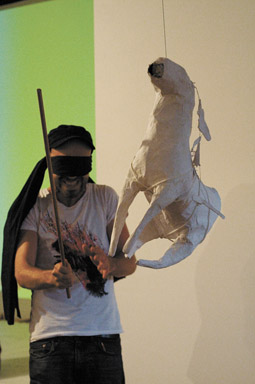
Panther, Exercises in Happiness
photo Alison Bennett
Panther, Exercises in Happiness
panther: exercises in happiness
Climbing a narrow stairwell to a first floor space situated above a tyre repair business, I’m immediately handed a scorecard. Co-creator Madeleine Hodge then fires off a series of questions meant to test my suitability for Exercises in Happiness. Yes, I live alone. No, I’m not involved in a permanent relationship… And on the questions go until, thoroughly qualified by an increasing sense of isolation, I go to the top of the class and am permitted to explore Panther’s eclectic environment.
As I investigate each exhibit and attempt to rate each on a happiness scale of 1-5, I become unhappy. If NYID commodified intimacy, Panther requires we assess subjective experience via techniques of market research. There’s “Things to do before I Die”, which induces a fine sense of melancholia, not because of a fear of annihilation, but because the majority of answers scrawled on a white wall in lead pencil avoid the question. Over by the north wall resides “The Garden Wilderness” comprising miniature human figurines placed within and alongside king-sized pot plants and other insurmountable and arbitrary greenery. Nature’s devastating indifference and our narcissistic inability to recognise this makes me sigh, then want to cry, and throw myself face down on the floor and die…But this is not to be; Panther’s other half, Sarah Rodigari, has other ideas.
As if trying to sell me a vacuum cleaner, Rodigari corrals me toward the “Piñata Shot.” We share a hit of tequila amidst a mutual concern for the state of our speckled livers, then like some humiliated and blustering town idiot I’m blindfolded, given a big stick, spun three times in order to accentuate the rush of 30 proof alcohol to my pallid brain and prompted to strike a papier mache donkey that hangs somewhere in the turbulent darkness. By the end of it all I have acquired an exhilarating sense of despair. That fast fading idea of the recuperative power of art has been put through the mincer, and so have I. Forced to participate in an ironic dissection of my own pithy understanding of what art has become, I am bundled back down the stairs and out onto the street as a marketable commodity; fully researched and ready for my chosen demographic, all prepared to spread the word and commodify.
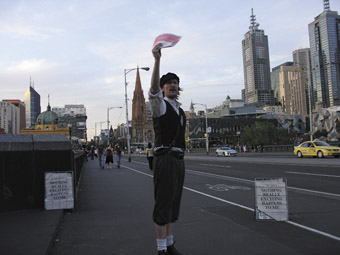
Joseph O’Farrell, Newsboys, Lone Twin & The Suitcase Royale
photo Tom Supple
Joseph O’Farrell, Newsboys, Lone Twin & The Suitcase Royale
lone twin & the suitcase royale: newsboys
This commodification of the individual achieved catharsis in Newsboys. A humble show, it nevertheless, in retrospect, provided the previous two with a progressive through-line that, all three combined, became a caustic comment on the state of the art during a global economic meltdown.
As a former paperboy myself, I was empathetic while watching members of The Suitcase Royale attempt to give away copies of a broadsheet titled The News during peak hour on Federation Square. Dressed like characters from Oliver Twist—floppy caps, grandpa shirts and knickerbockers—they were largely ignored by a crowd preoccupied with i-Pods and 3G mobile phones. Yet this intervention of an archaic form of communication into a culture largely unconcerned with its history was also a wry commentary upon the desperate status of the artist in the 21st century.
Selling newspapers was a performative act, as those of you who can remember the rhetorical rendition of a newspaper’s title—registered by pubescent vendors on city streets—as being a primal scream for commercial means. If you did not perform you did not sell, and many a paperboy succumbed to the fear that accompanied being forced to scream in public at peak hour. And so it is for the artist in the 21st century. Intervening in a cultural flow and criticising the conventions that govern our lives is an act of courage that often goes unnoticed. And so it was in Fed Square when I approached a member of The Suitcase Royale and requested a copy of The News. “Thanks mate”, he said, and his appreciation was heartfelt. Later, when reading the broadsheet, it became clear that its stories were private anecdotes of people interviewed for the project. One headline read: EVERYBODY’S OUT OF JAIL. Like The News, these performances by NYID, Panther and The Suitcase Royale that cast a critical eye over the commodification of the individual were free of charge, part of MIAF artistic director Kirsty Edmunds’ broad agenda to encourage audience participation in the festival. Freedom from the trite constraints of commodification is a necessary component of any participatory culture.
The Meaning of Moorabin is Open for Inspection, concept/creation David Pledger, project coordinator Lydia Teychenne, sound Lawrence Harvey, lighting Niklas Pajanti, website designer Alex Gibson, online Video Artist Jarrod Factor, photography Michael Williams, film editors Greg Ferris, Mark Atkins, Moorabin, Oct 9-25, http://themeaningofmoorabbin.com.au/; Exercises in Happiness, Panther & Tape Projects, creators Sarah Rodigari & Madeleine Hodge, Tape Space, Oct 11-25; Lone Twin & The Suitcase Royale, Newsboys, Federation Square, Oct 8-13, Melbourne International Arts Festival, October 9-25, www.melbournefestival.com.au
RealTime issue #88 Dec-Jan 2008 pg. 6
© Tony Reck; for permission to reproduce apply to realtime@realtimearts.net
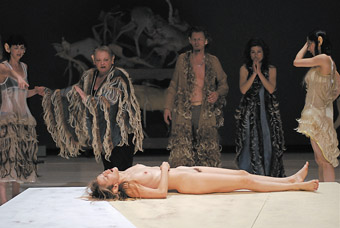
Jan Lauwers and Needcompany, The Deer House,
photo Maarten Vanden Abeele
Jan Lauwers and Needcompany, The Deer House,
A MATRIARCH STANDS OVER HER DEAD DAUGHTER’S PALE, SUPINE BODY. SHE HAS AWKWARDLY DRESSED HER LONG-LIMBED ADULT-CHILD, WEEPING THROUGH HER FRUSTRATION, CHOKED BY MATERNAL PAIN BUT DETERMINED TO CONTINUE, TO REMAIN A CONSTANT THAT THE REST OF HER FAMILY CAN RELY ON. HER GRIEF-STRICKEN FACE IS FRAMED BY TWO OVERSIZED PIXIE EARS, HER BATWING-SLEEVES TRAIL FRINGES OF MOUSEY HAIR. BUT DESPITE THIS GNOMISH INCONGRUENCE, SHE COMMANDS RESPECT.
All eyes are drawn to her, a bold figure in the sparse white landscape of the stage. Beyond the platform where her daughter lies, on the outskirts of the colourless expanse, large rubber stags stand pallidly in line and the small ivory torsos of deer are heaped haphazardly under rows of huge antlers hanging on the far wall. Family members take their time at the corpse’s side, her long blonde hair falling over them onto the bare podium as they hold her.
The mother—the inimitable Viviane de Muynck—moves downstage towards us. No longer crying, her canorous voice is strong and unstrained as she addresses us directly. For now she is no longer the mother of the girl, but Viviane the performer, the storyteller recounting the back story to what we have just witnessed. She speaks about a Europe that has become a wilderness, and a family seeking refuge from the atrocities of war in an abandoned station, deep in the countryside. This is the deer house, a sanctuary from which they sell antlers to survive. As her musical words paint landscapes in the imagination, her round eyes settle on every one of us. Her gaze captures me and I could be sitting by a fire listening to fairytales. She is mother to all of us.
But something goes wrong. The mesmerising flow of her speech stalls and sputters. She’s lost her way, she struggles to finish a word, she can’t push it out of her mouth. Her eyes panic, glaze and fix on a distant spot. The family crowds in as she crumples. A jumble of languages rises from the bodies huddled round her. We crane to catch a glimpse of her, shocked into tenseness as the represented world invades its own narration.
For tonight we all seem to be part of this family, as Jan Lauwers and Needcompany tell us about community and death and the blurry boundaries between theatre and the world, where the real and the simulated merge and overlap, and intimate human conflicts are a microcosm of encompassing global occurrences. The performance centres on an actual event: the death of dancer Tijen Lawton’s brother, a war photographer killed in Kosovo while Lawton was on tour with the company.
At the start of the show we see the company’s dressing room reconstructed: the performers cavort around semi-naked, cheekily attention-seeking as they exchange jeans and tracksuits for rustic elfin tunics and large impish ears. Although playful, they’re equally absorbed in darker topics, stories of violence and death. They read extracts from a diary discovered by Lawton in Pristina when she identified her brother’s body, and from this a new story arises.
A war photographer is forced to choose between shooting a mother or her child to save the other. He kills the woman, and journeys with the body to the rural home of her relatives. They must decide whether he should die for his crime, and then whether his killer should also die. The Needcompany family assume the roles of this folkloric clan with a Brechtian-style self-awareness, presenting a narrative that dips in and out of its own frame, as the characters —and the corpses—step in and out of the action, attempting to alter or prevent the story’s progression.
The Deer House is the third part of Jan Lauwers and Needcompany’s Sad Face/Happy Face trilogy, following on from Isabella’s Room (2004) and The Lobster Shop (2006). While the first two parts focused on the past and the future, this third instalment looks to the present. And the company’s frenetic, unpredictable presentation aptly reflects its fleeting ephemerality. Dance, music, performance meld into a new, self-reflexive form, embedding skilfully manipulated reference to earlier mythologies, including the mourning rituals of Greek tragedy. The multilingual musician-performers also mix and match French, English and Dutch, the surtitles flashing as ideas fire simultaneously, tightly packing in ambiguous images to constantly widen the breadth of associations.

Jan Lauwers and Needcompany, The Deer House
photo Maarten Vanden Abeele
Jan Lauwers and Needcompany, The Deer House
The show careers ahead of us and moments we can’t catch are swept up in the commotion; sometimes it’s a struggle that fragments our concentration, but then we are reined back in, particularly when characters attempt to take control of their present, trying out alternative possibilities. Their stories are a way to stall death: perhaps this bag is full of stones instead of a child’s body; perhaps the photographer doesn’t have to die. But ‘no-one writes their own story’ and the present inexorably progresses, even though we can’t see how after such momentous and tragic events. Just as the matriarch picks herself up and carries on with the tale, life itself continues after bereavement. Routine and order are broken, but trepidation is eased away as a new structure is settled on. Stories rise from death, providing ways to continue.
So at the end of this epic journey, hope grows from despair. Perhaps, as the characters suggest, grief is “the only thing that keeps all cultures from falling to bits”, providing “the driving force for the new.” The performers sing out a final image of community in this fantastical, ridiculous world: “We are a small people with a big heart, we love each other and it’s a real art.” Spectres of the chorus from an ancient Greek tragedy, perhaps.
Jan Lauwers and Needcompany, The Deer House, text, direction, set design Jan Lauwers, music Hans Petter Dahl, Maarten Seghers (except “Song for The Deer House”, Jan Lauwers), performers Grace Ellen Barkey, Anneke Bonnema, Hans Petter Dahl, Viviane De Muynck, Misha Downey, Julien Faure, Yumiko Funaya, Benoît Gob, Tijen Lawton, Maarten Seghers, Inge Van Bruystegem, choreography the company, costumes Lot Lemm, lighting Ken Hioco, Koen Raes, sound design Dré Schneider; Kaaitheater, Brussels, Sept 25-27
RealTime issue #88 Dec-Jan 2008 pg. 8
© Eleanor Hadley Kershaw; for permission to reproduce apply to realtime@realtimearts.net
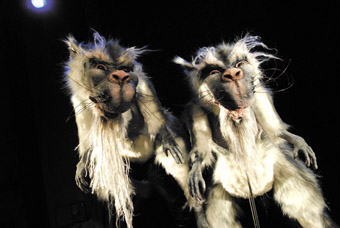
Erth, Nargun and the Stars
photo Heidrun Löhr
Erth, Nargun and the Stars
FERGUS LINEHAN COMPLETES HIS SYDNEY FESTIVAL DIRECTORSHIP WITH A MEATIER THAN USUAL PERFORMANCE PROGRAM, ONE POPULATED IN PARTICULAR WITH EPIC WORKS FROM FOUR TO NINE HOURS; A SLENDER DANCE LINE-UP (AFTER THE AUSTRALIAN RICHES OF 2008) ALBEIT WITH THE SUBSTANTIAL PRESENCE OF STAR UK CHOREOGRAPHER CHRISTOPHER WHEELDON (WORKING LARGELY OUT OF THE US); AND A CONTINUING PASSION FOR THE SERIOUS END OF THE POP MUSIC SPECTRUM. AS EVER WITH LINEHAN, SYDNEY ARTISTS OF ANY IDIOM ARE LUCKY TO GET A LOOK IN—ERTH VISUAL & PHYSICAL AND SYDNEY THEATRE COMPANY ARE THE FAVOURED TWO IN 2009. THERE’S ALSO A WELCOME FESTIVAL KIDS SEASON AT RIVERSIDE THEATRE, PARRAMATTA, THE HIGHLIGHT BOUND TO BE ERTH’S ADAPTATION OF NOVELIST PATRICIA WRIGHTSON’S NARGUN AND THE STARS. HERE’S MY FESTIVAL WISHLIST.
robert lepage: lipsynch
Marie-Anne Mancio wasn’t convinced that the 8 hour 35 minute work by Robert Lepage’s Ex Machina altogether cohered when she saw it at London’s Barbican Arts Centre (RT 87, p3), but along the way there was much to appreciate. She wrote, “In order to concentrate on the notion that voice is genetic (almost part of the fabric of the soul, whereas language or speech is encultured) Lepage courageously eschews the stunning visuals for which he is known. So, sets are witty and efficient—the side of a plane morphing into a train—but not spectacular. Instead, there is a glut of sound from singing to speeches, to a baby’s cries, to advertisements, to canned laughter. In a Los Angeles restaurant, conversation is punctuated with simultaneous translation and ringing telephones. Characters switch languages as do actors—text is in English, French, German, Spanish, Italian. On occasion, where surtitles are unclear, we are immersed in pure sound and sometimes, as [one character] tells us, music transcends failing language. As her son departs for California, [another] sings from Górecki’s Symphony no. 3 the lament in which the Virgin Mary asks Jesus dying on the cross to ‘Share your wounds with your mother.’ In other episodes we learn: we can speak without saying anything (President Bush is quoted); the content of speech—however plaintive or important—can be reduced to an analysis of harmonics and frequency; by recording permutations for British Rail announcements, you could read your own obituary. And death does not mean your body stops farting.
“To its immense credit, Lipsynch is often very funny, moving, insightful and never boring. It deserves multiple viewings to appreciate all of its references and nuances, the motifs of loss, of absent fathers, biblical characters, dualism; the incredible performers who take us on journeys as their multi-faceted roles age, change context or gain knowledge.”
nature theater of oklahoma: no dice
Also focused on communication, this time around kinds of telling, is No Dice from New York’s Nature Theater of Oklahoma. Jana Perkovic in her review from Zagreb’s Eurokaz performance festival wrote, “Starting with traditional oral narrative as a model, No Dice is an epic, four-hour replication of hours of telephone conversations between group members (ranging from artistic laments to complaints about work, drinking and eating disorders, to ‘dinner theater’ experiences). It employs tropes of oral epic (repetition, variation) which clash with the tropes of Shakespearian theatre (acts, climaxes), which in turn clash with the overturned tropes of good acting (misplaced foreign accents, hyper-articulation, exaggerated costumes). Modes of communication split apart, nothing quite matching: even the gesticulation employed is their own confusing invention (including, but not limited to, the sign of the cross, thumbs up, mimed wall and some nameless but recognisable gestures, such as intravenous drug use). It is a legible, but closed system of references, until it suddenly opens towards the end: the actors take their wigs and sunglasses off and address the audience: ‘The question is, what do we require in order to enjoy ourselves?’ Communication itself, they conclude. Poignant, semiotically imaginative, intellectually provocative but emotionally rich, Nature Theater of Oklahoma’s performance—with its roundabout, illogical, confusing conversations—is a manifesto of faith in our ability to engage with each other through speech.” (RT86, p56). At only $25 a ticket (compared with Lip Synch’s $100-140), No Dice could be the festival bargain for the adventurous but cash-strapped performance-goer.
stc actors company: the war of the roses
Another welcome epic, The War of the Roses will allow us an extended glimpse (at eight hours) of rarely performed plays by William Shakespeare that offer a view of English history that is at once idiosyncratic and predictably Tudor. The cutting and pasting and editing of these sizeable plays (to make the playing time manageable and the history presumably comprehensible) is by Tom Wright (most recently Barrie Kosky’s collaborator on The Women of Troy) and the show’s director Benedict Andrews, who can always be relied on to create lateral but faithful and telling interpretations of classic works. The STC Actors Company, in their last outing, is joined by Cate Blanchett and Robert Menzies (Brutus in Andrews’ Julius Caesar) and the design is by Alice Babidge, who impressed with her set for The Women of Troy. The War of the Roses Part 1 includes Richard II, Henry IV and Henry V, Part 2: Henry VI, and Richard III. The rise and fall of kings and queens, their allies and enemies on fortune’s wheel, and of their own volition, right or wrong, is the grimly exhilarating stuff of the younger Shakespeare’s vision and will doubtless achieve additional topicality in the hands of Andrews and Wright.
morphoses/the wheeldon company
This is bound to be a fascinating program, not least because it’s the Australian premiere of Christopher Wheeldon’s own innovative company, such a rarity for a ballet choreographer these days, and includes the exacting Slingerland Pas de Deux (an excerpt from the truly surreal full-length postmodern ballet by William Forsthye, music by Gavin Bryars) alongside Wheeldon’s own creations, Fools’ Paradise, accompanied by a chamber orchestra, and his acclaimed Polyphonia, set to piano music by György Ligeti.
malthouse: the tell-tale heart
Barrie Kosky’s account of Edgar Allen Poe’s The Tell-Tale Heart for Melbourne’s Malthouse with the virtuosic Martin Niedermair as the haunted murderer and director-adapter Kosky on piano (for songs by Bach, Purcell and Wolf) has induced trepidation and excitement wherever it’s been played around the world. John Bailey wrote, “This is a theatre of ellipses, in which the unsaid holds as much weight as the spoken word” (RT 82, p8).
katona józsef theatre: chekhov’s ivanov
Budapest’s Katona József Theatre and director Tamás Ascher set Chekhov’s early play Ivanov in the context of Hungarian rural culture after the Soviet Russian crushing of the 1956 Hungarian Uprising. If we see Chekhov’s plays as precursors, in a metaphoric rather than literal sense, of the Russian Revolution, then this version of Ivanov makes for an intriguing reversal of expectation. Here the focus is not “the fading Russian bourgeoisie” but is “planted…firmly within Hungary’s ascendant peasant classes of the 1960s.”
belarus free theatre: being harold pinter
Company B are hosting Belarus Free Theatre, an underground theatre project formed in 2005, and still banned, to battle the censorship imposed by dictatorial President Alexander Lukashenko. Being Harold Pinter draws on the playwright’s Nobel Prize acceptance speech and uses excerpts from his plays to reflect on life under dictatorship. In Belarus, the company continues to perform in homes and other unadvertised locations despite police harassment and job losses in a culture where theatres are otherwise state controlled. The Free Theatre’s performance style is reputedly raw and anarchic, winning praise for its performances in the UK. Sam Marlowe wrote in The Times (Feb 20), “Beneath a photograph of Pinter’s own watchful eyes, the cast of seven, dressed in grey suits…create a nightmarish kaleidoscope of darkness, light and blood-red. Their hands are stained as if by stigmata; their delivery is packed with punchy aggression, and the menace of Pinter’s writing becomes uncompromisingly overt.” Being Harold Pinter will also play at Q Theatre Penrith.
erth: the nargun and the star
s
A classic of literature for children here in Australia and the world over, Patricia Wrightson’s Nargun and the Stars (1973) was awarded the Australian Children’s Book of the year (1974) and the Hans Christian Andersen Medal (1986). When a boy’s parents are killed in a car crash, he is moved to a sheep farm to live with cousins he doesn’t know and there encounters and befriends mythical Indigenous creatures. But development in the area unleashes a vengeful spirit, the Nargun, in the form of a giant murderous rock. The boy must act, to save lives, but also the land. Adapted by playwright Verity Laughton and directed by Wesley Enoch and Erth’s Scott Wright, and blessed with Erth’s considerable skills at creature making and large scale puppeteering (like their baby dinosaurs for the Natural History Museum of Los Angeles), Nargun and the Stars should be a festival highlight for children and adults alike.
2009 Sydney Festival, Jan 10-31, www.sydneyfestival.org.au
RealTime issue #88 Dec-Jan 2008 pg. 10
© Keith Gallasch; for permission to reproduce apply to realtime@realtimearts.net
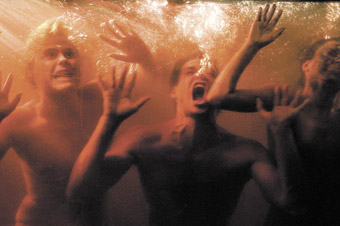
La Fura dels Baus, SUB
photo Oskar Perez
La Fura dels Baus, SUB
LA FURA DELS BAUS IS KNOWN FOR ITS HIGHLY PHYSICAL AND CONFRONTING PERFORMANCE SPECTACLES. THE COMPANY HAS DEVELOPED ITS OWN THEATRICAL AND VERBAL LANGUAGE (FURAN), STYLE AND AESTHETICS. MY MEMORIES OF THEIR EARLIER WORK INCLUDE BEING CHASED AROUND BY MUSCLE BOUND MEN WIELDING CHAINSAWS, BEING PELTED WITH OFFAL AND HERDED AROUND BY GIGANTIC CARDBOARD BOXES.
La Fura’s work bursts out of the chaos of Barcelona. I discovered that nothing there is straightforward—not even finding out about their show, SUB. After a futile online investigation, I decided to leave it to fate. As I wandered down the back alleys of Barcelona, desperate to find some clue, I literally walked into the wall that bore the only extant poster anywhere in the city. And, as it happened, the last night of the performance was my last night in Spain.
The venue, Naumon, is an old Norwegian icebreaker ship that La Fura bought in 2003, saving it from being turned into scrap metal and returning it to life as a floating theatre on Barcelona’s harbour.
In SUB the line between theatre and life is blurred. The experience begins outside the boat, while the audience wait to board. Loudspeakers bark orders in a neat reversal of maritime law—women and children first! All the women talk and laugh nervously with each other—strangers bonded through fear and excitement at the mysteries awaiting us. One by one we proceed up the gangplank, leaving the men behind. Bags and bodies searched, we are pushed and shoved, forcefully herded down the dark stairs into the belly of the ship, a small torch our only source of light.
Down, down into the hold, like descending into hell. It’s dark and claustrophobic. We are forced to sit on the floor—bodies squeezed very closely together. Finally the men enter, with their energy and the stink of sweat, herded aggressively and made to sit opposite us. Doors shut, occasioning slight panic. It is now impossible to escape. We are all imprisoned—slaves or illegal refugees crammed into a freighter. Or into an Orwellian world in which people are powerless. And then La Fura dels Baus pull out all their party tricks—and it is one hell of a ride.
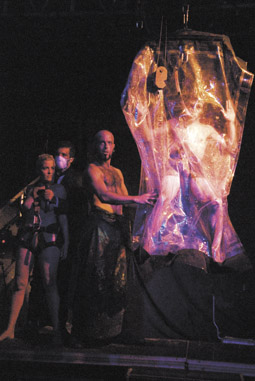
La Fura dels Baus, SUB
photo Oskar Perez
La Fura dels Baus, SUB
A performer drops through the ceiling hanging naked from a rope. Is he being punished for trying to escape? Are we all being punished? What is our crime? An amplified version of “Love Me Tender” booms from the opposite end of the boat. A woman, in boiler suit, sings karaoke as she descends the staircase, leading in the latecomers—the dispossessed. Her plea for love goes unheeded. Instead she is defiled, raped and hung from a meat hook. A powerless trophy of war?
Above us, two women and two men hurl paint, the drips forcing the audience to shift uneasily in the first of the company’s manipulative crowd/body orchestrations. Characters emerge from all directions—above, below, from the sides…Who is that big bellied man lurking in the shadows? A slave master ready to pounce? In a moment of pure theatrical release, the separated male and female audience members are allowed to reunite. In this subterranean domain there is panic to locate partners, wives, husbands, children—all of us forced to think about the ones in reality who will never find each other.
One side of the ship opens to reveal a ‘human aquarium.’ A man drops into the water, almost naked, a breathing apparatus in his mouth. The water turns red as another body plunges in. And another, and another, now without a line of air. The tank is getting overcrowded, limbs pressing against the scratched glass wall. At first they help each other breath, happily sharing their lifelines but friendship quickly dissolves into a watery struggle for oxygen and space. Outside the aquarium we are powerless—fated to watch but unable to help. And yet, how generous would we be in such a life and death situation? Would we share our last gasp of air with a stranger?
More airless moments: another two bodies are strung up—each totally covered in plastic, a snorkel their only source of air. But, instead of it bringing air into their plastic cocoon, air is being sucked out—the bodies become literally vacuum packed. The amplified wheeze of their breath echoes in this cavernous prison.
A booming voice-over infiltrates the space. A mythical tale unfolds, set in Queensland of all places, in which people are ordered to drink whatever they can find—but to purify it with a pill (a reference to the current debate over drinking recycled sewage). Following orders, a performer, suspended on the side of the boat, flops out his penis, relieves himself into a watering can, puts in a tube and then proceeds to drink this ‘precious’ liquid. Has he gone too far? Extreme circumstances cause extreme transgressions.
And, all throughout the performance, while bodies are dragged across the ground, suspended, vacuum-packed; or as we are chased by gigantic electric fans; while water gushes into the boat, is caught in buckets and thrown at the audience, or is sprayed at the performers; while they are finally strung up against a blank canvas only to be painted out of existence, there is the constant flash of mobile phones and cameras as members of the audience clamor to record the events. The horror preserved for later observation—once we are safely removed from the experience.
As I make my way through Barcelona’s streets, filled with the excitement of having been totally consumed by this performance, I reflect on how much I have been hankering for this style of extreme performance back home. On board the train, I sit in an airless carriage totally controlled by raucous hash-smoking Spanish teenagers. Is this part of the show? Have the lines between theatre and life totally disappeared?
La Fura dels Baus, SUB, text Ahmed Ghazali, Rafael Argullol, direction Younes Bachir, Carlos Padrissa, performers Samuel Delgado, Oumar Doumbouya, Irene Estrade, Zamira Pasceri, Younes Bachir, producer Isabelle Preuilh, coordination Adrìa Guadagnoli; venue Naumon, Barcelona, Sept 22-Oct 12, www.lafura.com
RealTime issue #88 Dec-Jan 2008 pg. 11
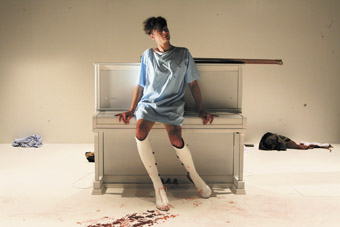
Brendan Ewing, The Red Shoes
photo Bohdan Warchomij
Brendan Ewing, The Red Shoes
ARTISTIC DIRECTOR MARCUS CANNING’S EXHIBITION CELEBRATING ARTRAGE’S 25TH ANNIVERSARY DEPICTED A FRINGE ORGANISATION DETERMINED NOT TO GROW UP AND TO REMAIN THE EDGY, EXPERIMENTAL—AND SOMETIMES HIT AND MISS—INSTITUTION OF ITS YOUTH. THE MESSY LIVE WIRE OF THE RETROSPECTIVE ASIDE, THE SUCCESS STORY OF THIS YEAR’S FESTIVAL WAS THE DANCE PROGRAM, ATTRACTING STRONG HOUSES AND REVIEWS.
Choreographer Bianca Martin presented her first large scale, full-length production, Home Alone, complete with an impressive if sparse two-storey set and onstage drummer, placing three dancers within an abstract world of troubled domesticity. Keira Mason-Hill—best known for her work with youth dance group Buzz—was the most happily playful of the performers, making one interlude where she was grabbed about the throat by an abusively dominating Joe Jurd all the more affective. In contrast Kathryn Puie’s aggressive athleticism combined with sliding grace saw her and Jurd clambering up walls and hanging from the steel-rimmed rafters in what occasionally looked like a homage to Fred Astaire’s famous ceiling dance in Royal Wedding (1951). Particularly in Mason-Hill’s dancing, there was a tendency towards ground movements and swinging body-twists in a low centre of gravity, contrasting with the up/down, climbing trajectories elsewhere apparent. A mime game of dinner involving cutlery and three cans of tinned goods traded amongst the performers appeared several times, imparting a sense of rhythmic continuity and return. Generally though, the piece was dramaturgically opaque, and the drummer was not used as often as one might have expected, with recorded music more frequently employed.
Compared with Paradise City and other athletic, post-Pina Bausch dance-theatre works seen in Perth in recent years, Martin’s Home Alone did not quite reach the right level of chaos, power, or density of relationships to fully soar. After Home Alone’s abuse scene, Puie retired to the upper level to crouch into herself and push about an old and out-of-place fake Christmas tree, suggesting a spirit in the attic whose physicality reflected through a glass darkly the actions of her fellows. With more attention to making visible such abstract relationships between the performers, Home Alone could make a fine contender for a Mobile States touring program.
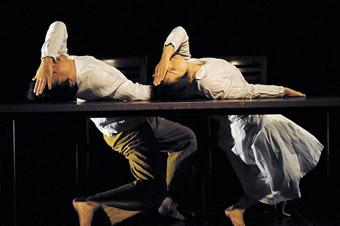
Maho Sumiji, Shuichi Abiru, Selenographica
photo Christophe Canatpo
Maho Sumiji, Shuichi Abiru, Selenographica
Dyuetto presented choreography by locals Sete Tele and Rachel Ogle alongside Japanese duo Selenographica (Maho Sumiji and Shuichi Abiru), together with a less effective, schlocky socio-sexual critique from Melbourne’s Luke George. In recent years, Tele and Ogle have been working with the differently-abled company The Get Downers (RT87, p18). Not having observed the pair perform such technical material in their own work before, what struck me about N_TN_GLD was the physical difference and dialogue present throughout every aspect of their actions. Tele is black, weighty and masculine, Ogle white, female and long-limbed. The production generated a wonderful slipping and sliding of affect and stylistics across the pair, from moments when similar inflections, poses and ways of holding the criss-crossing bodily forms of the two seemed to meld them into a construct of very similar modalities, to other instances where Ogle’s lengthy extension of form or Tele’s meteoric redirection of inertia and mass carved two almost irreconcilable forms onstage.
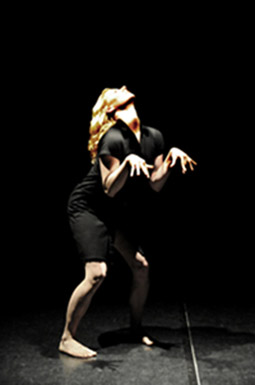
Rachel Ogle, Dyuetto
photo Christophe Canato
Rachel Ogle, Dyuetto
The spatial dramaturgy and lighting reinforced the structure of the piece around this dialogue of separation and confluence. Tele started alone, in blackness, spot-lit from above, vibrating and articulating in a manner which erased his awareness of anything outside of the body and its neuroanatomical sensations. Here the performance recalled butoh. Then in a duet the dancers’ focus was still deeply internal, suggesting something of the non-human or posthuman in these bodies. N_TN_GLD ended with Ogle alone, hair masking her visage, and a sense of deep weariness and resistance to further action evident in her arms, her hands and the sometimes clawed shapes that decorated the space about her intermittently jerking, yet elegant columnar form.
French reviewers have focused on the exotic orientalism of Selenographica. What Follows The Act certainly could be read in culturally specific terms. The central role of critiques of the alienated husband-and-wife team in modern, post-WWII Japanese society and the arts after Mishima, butoh and Suzuki, does inform What Follows The Act. Selenographica however had none of the deliberate attempt to shock or to invoke taboos which was such a feature of this earlier work, reflecting a different trend in Japanese performance which has become more prominent since the 1990s, characterised by a deadpan, potentially comic lightness of touch. This is a mild, charming work, focusing on semi-improvised play and games between Sumiji and Abiru who begin by exploring how many movements and dialogues can be sketched between the pair as they sit, somewhat anxiously, at a domestic table, or later move towards and climb a prominently displayed ladder (a sign of escape perhaps?). To read such allusions in national terms would overstate matters. It is not just the Japanese who admire minimalism or enjoy quirky moments within an otherwise seriously performed work. In one particularly rich moment, Sumiji reclined on the table to let one hand snake and coil filigrees in the air, a totally pointless act whose joyful affectivity lies precisely in its unnecessary character. Such motifs place Selenographica at least as close to Euro-American dance theatre as to the particularities of Japanese aesthetics within today’s world of globalised performance—something which this company seems to embrace.
Outside of the world of dance, Mar Bucknell presented A History Of Glass. Better known for his more extreme performance art works, Bucknell’s Glass was a surprisingly gentle piece consisting of a soporific set of prose-poems describing a population caught within a room of glass, blasted by light from outside, and within which the boundaries, meaning and structure of everything become evermore hazy. Bucknell’s recitation was accompanied by an electronic soundscape whose organ tones evoked film-maker John Carpenter’s music, while Stuart Reid used a digital sketch pad to project a yellow tinted doodle which he constantly added to, its curling scratches and deep, inky outlines lending a third rhythmic element to this gradual unfolding of sound, text and image, filling the space and the time of the performance. Overall the piece had a durational quality, the experience of its slow length being a key part of its structure and affect. Bucknell’s prose could have used a firmer structure—several apparent climaxes arose in which the inhabitants suddenly became free to walk beyond the glass and across the yellow sands, before returning to their prison—but this also helped give a sense of repetitive sustain and detailing, which made for an enjoyably somnambulistic yet existentially dystopian work; shades of Sartre’s No Exit, to be sure.
A festival highlight was director Matthew Lutton’s return from Sydney and Melbourne to stage Humphrey Bower’s adaptation of the Hans Christian Andersen story, The Red Shoes. Lutton’s most mature work so far, the production had a sparse, Grand Guignol nastiness to it. Paris’ infamous horror theatre of the early 20th century, the Grand Guignol employed a taut, dramaturgical understatement before releasing a fervid, melodramatic excess and buckets of blood. It was a theatre of shock, a style of performance structured more around scenographic electrocutions and tensed release than any coherence of narrative or character. Staged on a blindingly white stage, complete with trapdoors into which objects could be dropped and a piano centrestage behind which material was hidden, The Red Shoes positively blazed with red when the perverse young male protagonist Kevin (Brendan Ewing, also showing a level of craft over and above previous achievements) finally asked the woodsman to sever from his feet the glistening, imprisoning devil shoes which had overtaken him and forced him to dance, Tourette-like, forever.
George Shvetsov, his lanky form often casting gargantuan shadows above and behind him, was an equally sexually troubling presence, not a perverse character per se but certainly one capable of seducing all on stage (and in the audience) as they trembled before him. Igor Sas however virtually stole the show as a cross-dressing temptress (the Ice Princess) and Kevin’s stern, comically Catholic conscience (Auntie C). Explosions in intensity within this otherwise minimal structure were heightened by Ash Gibson Greig’s score, varying from eruptive noise to almost Weiner cabaret.
The Red Shoes could have gained clarity from dramaturgical development—quite what, for instance, was signified by having Kevin’s mother, the Princess, Auntie C and other female characters collapsed into the dangerously sexy form of Sas was unclear—but as indicated, horror is not necessarily a form which requires transparency of meaning. This was a theatre of effects, and such scenes as where the naked Ewing quaked in a veritable seizure of pain and desire as dark red liquid dripped across his white skin was sufficient to bind The Red Shoes into a richly affective, sadomasochistic pleasure.
2008 Silver Artrage 25th Anniversary Festival, curators Marcus Canning, Andrew Gaynor: Company Upstairs, Home Alone (The Suburbs Dream Tonight), choreography Bianca Martin, performers Kathryn Puie, Keira Mason-Hill, Joe Jurd, design Jamie Macchiusi, drums Tim Bates, lighting Deidre Math, Rechabites, Oct 30–Nov 8; Thin Ice Productions, The Red Shoes, text/adaptation Humphrey Bower (after Hans Christian Andersen), director Matthew Lutton, performers Brendan Ewing, George Shvetsov, Igor Sas, designer Claude Marcos, music Ash Gibson Greig, sound Kingsley Reeve, lighting Matthew Marshall, PICA, Oct 18–28; Bright Edge, History Of Glass, text/recitation/digital-slides Mar Bucknell, sound Allan Boyd, projected live drawing Stuart Reid, Blue Room, Oct 29-Nov 8; Strut, Dyuetto, N_TN_GLD, performer-devisors Rachel Ogle, Sete Tele, lighting Mike Nanning; Selenographica, What Follows The Act & It Might Be Sunny Tomorrow, direction, choreography, performers Maho Sumiji, Shuichi Abiru, direction, design Genta Iwamura, music Koichi Sakota, PICA, Nov 5-8, Artrage, Perth, Oct 17–Nov 23
RealTime issue #88 Dec-Jan 2008 pg. 12
© Jonathan Marshall; for permission to reproduce apply to realtime@realtimearts.net
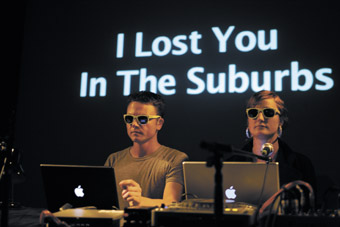
Martyn Coutts, Willoh S Weiland, Deadpan
photo Bohdan Warchomij
Martyn Coutts, Willoh S Weiland, Deadpan
IN THE OPENING PANEL DISCUSSION OF THIS IS THE TIME…THIS IS THE RECORD OF THE TIME, A TWO-DAY SYMPOSIUM ON INTERDISCIPLINARY PERFORMANCE PRACTICE AT THE PERTH INSTITUTE OF CONTEMPORARY ARTS, JULIE VULCAN REMARKED OF UNREASONABLE ADULTS’ GIFT/BACK (2006) PERFORMANCE PROJECT THAT “YOU OFTEN DO NOT KNOW WHAT YOU HAVE BEEN GIVEN TILL FURTHER DOWN THE TRACK.”
With its wordy titular focus on the here-and-now, titt…titrott was staged to mark the 10-year anniversary of pvi collective establishing their practice in Perth, and situated deeper within the retrospective context of the Artrage festival’s Silver anniversary program. That both of these auspicious events took place at all, would seem like acts of defiance against the city’s natural-born tendency to efface local cultural memory and to continually replace and renew. Silver, a compelling historical exhibition of visual art and artefacts connected to Artrage over 25 years—installed throughout the vast spaces of PICA—celebrated the work of local practitioners both past and present and also served as a reminder, to me, of the more recent demise of the artist-run initiative in this my former hometown.
But while the mineral boom and rising real-estate values have pushed out artist-run spaces from the city, organisations like Artrage has shifted focus to devising programs that assist artists with longer-term development of new work. They have maintained ongoing relationships with practitioners—Artrage presented pvi collective’s first performance project, Easy Listening Under the Truth Serum, in 1998 and has continued to support the efforts of the collective ever since. Perth is also the site of two significant and collegiate national centres for research in emergent and cross-disciplinary art forms: SymbioticA, now a Centre of Excellence in Biological Arts at the University of Western Australia, and the pvi collective’s newly established Centre for Interdisciplinary Arts (CIA), both of which provide opportunities for residency, exchange and discourse with peers nationally and internationally. SymbioticA were hosting a visit by Steve Kurtz of the USA-based Critical Art Ensemble (CAE), who had been cleared in June of all criminal charges brought against him and another scientist in 2004 for procuring harmless bacteria cultures for an exhibition. It was around Kurtz’s lecture at UWA entitled Crossing the Line—a convergence of politics, activism, democracy, terrorism, freedom of expression, citizenship and justice—that the participants gathered, setting the tone somewhat for the symposium and performances to follow.
The event drew artists together from across the country including panther (Melbourne), Spat ‘n’ Loogie (Sydney), David Williams of version 1.0 (Sydney), Sam Fox of Hydra Poesis (Perth), Unreasonable Adults (Sydney/Adelaide), Deadpan (Melbourne), Something In Common [sic] (Perth) as well as producers Cat Jones from Electrofringe (Newcastle), Rebecca Conroy from Performance Space (Sydney) and Jeff Khan of the Next Wave Festival (Melbourne)—many of whom initially worked with pvi on their TTS Australia and Reform tours. Pvi collective divided the symposium event into two parts: this is the time…, an evening of performances held at The Bakery, and this is the record of the time, a two day symposium which book-ended the performance night. This is the time… provided an occasion for the participants and audience to reflect on a vignetted representation of an artist’s/group’s practice before returning to articulation and discussion around the realisation of their work. As such, punters arriving at this is the time… as a separately-billed event, expecting pvi to deliver on the promotional hyperbole of an evening that “promises to rattle the cage of contemporary performance practice as we know it”, might have been confused by the lecture-style delivery and necessarily pared-back nature of some of the works.
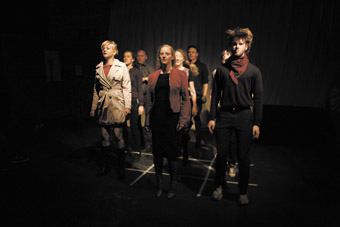
Something In Common (sic)
photo Bohdan Warchomij
Something In Common (sic)
One of the main topics of discussion throughout the symposium was the site-based or non-institutional nature of much of the work being produced by interdisciplinary performance practitioners in Australia today, and of the risks, challenges and possibilities of creating work on the “hybrid stage of public space” (a useful description offered by Andrew Donovan of the Australia Council’s Inter-Arts Office), collapsing the distance between art and everyday life while finding, engaging, implicating and including new audiences in performance experiences. The cabaret and installation format of this is the time… while somewhat paradoxical to the methodologies of most of the artists involved (Michelle Outram’s political oratory and endurance-based performance Not The Sound Bite!, for instance, originally conceived for Speaker’s Corner in The Domain in Sydney had an obviously decontextualised resonance when re-staged in The Bakery’s courtyard) afforded a semblance of projects past, present and in-development that all hinged around particular contingencies, whether political, societal, temporal, technological or environmental.
The scheduled part of the evening of live art, this is the time… began with Unreasonable Adults’ If Not For You Then Who with Jason Sweeney performing live and Fiona Sprott emerging from the white-noise-ether of videotape to deliver dark and self-annihilating monologues on sex, failure and illness. As a part of their collaboration, Unreasonable Adults are adaptable and deliberately flexible to the specificity of the moment in which a work is being made, choosing to deliver performance and other outcomes across the internet, through installation, videos and performance. For this event Sweeney punctuated the meditative slowness of the grainy black and white video and audio environment after each of Sprott’s confessions by writing in loud staccato on an amplified blackboard in chalk, questions like “ARE YOU DEAD INSIDE?”, renting apart the darkly comic reverie created in these scenes by questioning the emotional health of the audience.
Among the participants in the symposium Sam Fox of Hydra Poesis identified a personal intent to create a platform for outrage, pathos and emotion to be directed at perceived injustices as an honest form of communication back to the ”hegemony”, reflecting more violently comments by Michelle Outram during the symposium that artists should be “agents within their own culture” and by David Williams of the desire to “perform citizenship.” For this is the time…Hydra Poesis created a one-on-one interactive performance utilising a threatening teleprompter with the intention of causing the sole participant to feel fear or aggression. Meanwhile, panther, an artistic duo also interested in person-to-person relationships, arrived in Perth fresh from presenting their new work Exercises in Happiness for the Melbourne International Arts Festival [p6] wherein audience members could perform and articulate the things that made them happy, or occasionally find deep-seated sorrow as a result of being rejected from an experience of the work. For this is the time… panther also yelled at the stars in a proclamation that mixed nihilism with optimism, pessimism with passivity and gave philosophical answers to pragmatic questions (and vice versa).
On the first panel David Williams of version 1.0 responded to questions regarding the sustainability of an issues-based theatre and the actual time it takes to bring new work to the stage. Williams counterpointed the rapid delivery of much of version 1.0’s verbatim source material—Hansard, the transcript of parliamentary proceedings being complete and available on the day after a sitting of the Senate or House of Representatives—against the need for continual revision of a script in order for its issues to remain pertinent both to the company and to an audience cognisant of changing world affairs. Embellishing the history of version 1.0 in a performance lecture for this is the time… Williams also alluded to the inadequacy of critical language in providing feedback to new and developing forms of performance by quoting from the retinue of version 1.0 reviews, “Apparently we were ‘challenging and hilarious.’ Apparently we didn’t ‘have strong characters’ and, as such, ‘had no clear character motivations’.”
Cat Jones, a performer and a curator of Electrofringe also manipulated language through the relatively new form and sonic intonation of avatar dialogue through a ‘play reading’ of a cat_gURL interactive event. Delivering a verbal introduction to the experience of entering a previous installation, Jones intercut video documentation and her reading with live performances of webmistress cat_gURL’s automated, gendered script about sexing and finding definitive sexuality. Creating another kind of visceral/virtual paradigm that connected the fleshy with the flat and pre-recorded, Spat ‘n’ Loogie’s Holiday took members of the this is the time… audience away on a sensorial approximation of an exotic holiday, replete with cocktails, a walk in the sand and a mushy holiday romance.
In closing this is the time…this is the record of the time, a producer’s panel convened to discuss the ways in which certain organisations including Next Wave, Electrofringe and Peformance Space are continuing to support the development phases of interdisciplinary performance practice through programs such as Kick Start and by working in concert with one another. With the understanding that the field is continually redefined, reframed and revised by both practitioners and the changing nature of the social and political spheres in which they choose to make work, this is the time…this is the record of the time, was an invitation to participate in the nurturing of an artist-led commitment to hybrid performance practice. And it took place in Perth. While this was the place and a particular moment, the effects and the influences of the program will continue to be felt “further down the track.”
this is the time…this is the record of the time conference presented by pvi collective in partnership with PICA and Artrage, PICA, Oct 31, Nov 1; performances: The Artrage Bakery Complex, Oct 31
RealTime issue #88 Dec-Jan 2008 pg. 13
© Bec Dean; for permission to reproduce apply to realtime@realtimearts.net
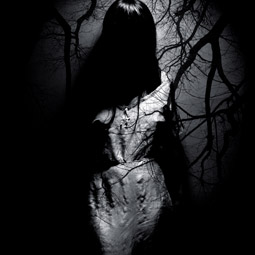
Jane Burton, Wormwood I (2006-7)
Courtesy of the artist and Bett Gallery, Hobart; Heiser Gallery, Brisbane; Johnston Gallery, Perth; Karen Woodbury Gallery,
Jane Burton, Wormwood I (2006-7)
FOR HALF THE YEAR TOKYO IS ONLY ONE HOUR BEHIND SYDNEY—SO CLOSE YOU CAN CONDUCT NORMAL BUSINESS ACTIVITIES AND MAINTAIN RELATIONATIONSHIPS AS IF YOU WERE JUST IN ANOTHER PART OF AUSTRALIA. MELATONIN LEVELS ARE RELATIVELY UNMODIFIED WHILE SENSES AND SOUL ARE OVERWHELMED BY OTHERNESS. PERHAPS THIS IS WHAT MAKES TOKYO FEEL NOT SO MUCH LIKE A FOREIGN COUNTRY BUT MORE LIKE A PARALLEL UNIVERSE.
trace elements
I was in this parallel universe for seven weeks undertaking a residency at Tokyo Wonder Site Aoyoama. Co-initiated by Artspace, Sydney the residency culminated in a group exhibition, Diorama of a City: Between Site and Space with fellow Australian artists Alex Gawronski and Tim Silver and Japanese artists Hiraku Suzuki, Exonemo and Paramodel. Co-incidentally another Australian/Japanese collaborative exhibition had just opened at Tokyo Opera City—Trace Elements: spirit and memory in Japanese and Australian photomedia—curated by Bec Dean from Performance Space with Shihoko Iida.
As with most activities I undertook in Japan, I got the instructions slightly wrong and entered the exhibition via the exit. This meant that the eroto-gothic photo manipulations, Wormwood (2005-07) by Jane Burton (Australia), were my introduction—sensual curves of female bodies caressed by shadows and forest branches. Burton’s images are richly evocative of adult fairy tales, perhaps a little undercut by the sterile corridor in which they are hung. However the resonance with Lovers (1994) by Teiji Furuhashi (Japan) in the next room installation serves as the correction.
As the video artist for Dumb Type it’s not surprising that Furuhashi’s is quite a performative installation. Images of naked people walk slowly around the four walls, meeting, embracing, passing through and by each other. Slide projectors on turntables rotate around the large room casting scanning lines across the images, while ceiling-rigged projectors throw messages onto the floor: “do not cross the line…” Melancholic chimes ring out, setting the meditative pace of the work that is all activity but with curiously little action. Its overly fussy mechanics reveal this is an early example of an immersive ‘multimedia’ environment.
Mixing with Furuhashi’s chimes are the clamouous explorations of Philip Brophy’s Evaporated Music (Part 1 A-F [2002-04, Aus]), in which the artist has remade the soundtracks to a series of popular music video-clips. Treating myself to the comfortable armchair I experienced the horror show that Brophy has made of Celine Dion’s ‘It’s all coming back to me now.’ The diva croaks through her lyrics, in desperate need of an exorcist, accompanied by wild foley and swirling 5.1 spatialisation. Infinitely more interesting than the original clip, full of film soundscape theory experiments, Brophy’s work provided a spikey element within the generally contemplative exhibition.
Continuing my backwards journey I worked from end to beginning across Japanese expatriate Seiichi Furuya’s series of images of his wife Christine. This course allowed me a little more ambiguity, and sense of discovery, in what is essentially a linear pictorial essay of love and loss. Accompanied by a booklet of excerpts from both Furuya’s and his subject’s diaries, the photos are mostly snapshots, personal moments, forming a deeply moving document of love and the tragic decline of a woman into irrevocable despair. Furuya has also made several publications, rearranging and regrouping the images to make sense of the course of events. Learning this later in the bookshop, I find the artist’s obsessive remembering even more tragic.
The small and seemingly unassuming works of Lieko Shiga (Japan) offer much for contemplation in their surrealistic photomontage of humble snapshots and provide a nice foil to fellow Japanese artist Kazuna Taguchi’s slick monotones of young girls treated with an etching-like finish. Poses are contrived, faces disappearing into contentless backgrounds. The irony of the images creeps up on you.
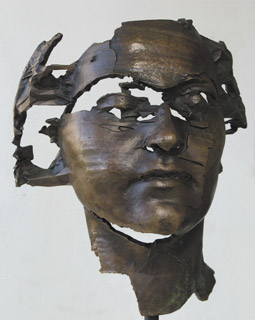
Sophie Kahn, Head of a Young Woman (2004)
courtesy the artist
Sophie Kahn, Head of a Young Woman (2004)
Taguchi’s cool and efficient pieces are in turn a nice match for the prints of Sophie Kahn (Aus/US) exploring the medical imaging of her body—twisted vectors alluding to muscle and bone. The body is simultaneously seen from inside and out, fractured by movement, refusing to be finally known. Also exhibited is a bronze cast of Kahn’s head—like a death mask—the brutal gouges and gashes made from finessing processing glitches rendering it both beautiful and disturbing.
An undercurrent of the exhibition was the relationship between moving and still images and their different powers as vehicles of memory. Genevieve Grieves’ video work, Picturing the Old People (2005), dresses contemporary Indigenous Australians in turn of the century clothing, re-enacting the portraiture of the time. These subjects refuse to remain still, to become the forgotten anonymous ‘natives’ of the archival images that Grieves was researching through the State Library of Victoria. It is a neatly conceived work, full of meaning for both Australian history and the history of photography and its role and responsibilities in documenting culture.
She dissolves (2000) by Chie Matsui (Japan) was a curious work secreted on tiny monitors in several parts of the gallery. The artist’s first video creation, it documents a performance in which a woman repeatedly disappears down a ladder under the floor and reappears a few minutes later soaking wet, up another ladder back into the room in a seemingly endless cycle.
This pared-back performance documentation modality appeared in several pieces I experienced in Tokyo, the most remarkable example by Yosuke Amemiya (Japan) at Tokyo Wonder Site in Shibuya. In the gallery Amemiya meticulously constructed a space (a set) involving buckets, apples and gym lockers and captured a series of Absurdist, minimal performance vignettes. He left the set intact and projected the video documentation, lifesize across one wall. The slippage between the screen reality and physical reality in the gallery created a sense of disembodiment most often experienced in telepresence works. On screen a man appeared out of the locker and you couldn’t help but look at the real object to see if maybe he was still there. And sometimes he actually was, because for the month of the exhibition, Amemiya and collaborators offered improvised afternoon performances. Sitting in a liminal zone between live art, sculpture and video performance this artist’s work is truly fascinating.
Rubbing up against the hyper-real of Chie Matsui’s work in Trace Elements, Dislocations (2005-6) by Alex Davies (Aus) felt more performative than in previous viewings. Davies interweaves the realtime presence of viewers with bizarre pre-recorded presences. Some sequences are more seamless than others, and the overly moodly, multichannel soundscape is ambiguous, but viewing this work in the middle of Tokyo was totally surreal. As I stood there looking at myself, a series of people I know walked in beside me—Leon Cmielewski and Josephine Starrs, Swerve from DualPlover…what are they doing here? In those moments I was truly in a parallel universe.
For a group show of 10 artists, Trace Elements was generous yet spacious and the curation felt rigorously considered. No one work felt stronger than another, rather the choices and arrangements allowed the resonances of the various formal approaches to photomedia, and cultural approaches to ideas of memory and history, to strengthen and challenge each other.
time crevasses
In the final days of my time in Tokyo, the art stars aligned to bring about the third Yokohama Triennale offering a bold focus on time-based activities beyond the normal scope of video to performance and sound. Art of Body, Art of Action, housed at the Red Brick Warehouse, featured several rooms dedicated to documentation of performance art and happenings in Japan from the 1950s to the 70s including works by Butoh founder Tatsumi Hijikata, Hi Red Centre and manifestations of the Fluxus movement in Japan. Several of the installations had perfomance elements such as the impressive if precious installation Fragments of Time (2008) by choreographer Saburo Teshigawara (Japan) consisting of a room full of glass shards into which ventured an occasional dancer. There was also a performance program including Jerome Bel and Pichet Klunchun, along with a series of sound concerts co-ordinated by Oren Ambarchi including Robin Fox, Merzbow, The Incapacitants, Tony Conrad and William Bennett.
While the warehouse style of the Shinko Pier proved challenging for the sound installations, there were many interesting works. In the cavernous space of constructed walls it was easy to miss the piece by Mario Garcia Torres (Mexico/US). The free standing right-angled wall partition sported two superflat speakers, playing back a detailed recording of the construction of the aforementioned partitions in situ. A very neat conceptual package and the documentation of a performance of sorts to boot.
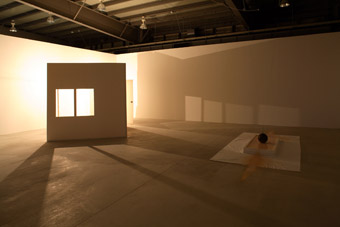
Tony Conrad, Brunelleschi, 2008
photo Keizo Kioku, courtesy of Greene Naftali, New York
Tony Conrad, Brunelleschi, 2008
The faux construction fetish continued into the next room housing Brunelleschi (2008) by Tony Conrad (US) which, along with a replica wall and door construction, featured a Civil War canon ball suspended like a pendulum over a low tray of yellow paint. As the ball swings across the surface the paint is quite daintily dispersed—visually and kinetically interesting. I am told that the wire holding the ball was also amplified, but I admit for once a sonic element passed me by.
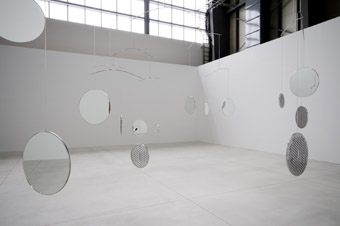
Cerith Wyn Evans and Throbbing Gristle, A=P=P=A=R=I=T=I=O=N
photo Norihiro Ueno, Courtesy of the Artist and Jay Jopling / White Cube, London
Cerith Wyn Evans and Throbbing Gristle, A=P=P=A=R=I=T=I=O=N
A=P=P=A=R=I=T=I=O=N (2008) by Cerith Wyn Evans (UK) broke with the minimalist ethos. Walking around the gently bobbing giant mobile comprising flat discs of mirrors, you’re in for a multi-dimensional sonic and visual experience as your being is fragmented and multiplied, accompanied by the exotic rumblings, text shards and klang of a soundscape by avant art band Throbbing Gristle.
Drawing on a more popular music is The Second Sentence of Everything I Read Is You (2006) by Stephen Prina (US). The sonic element here is a beautiful, multitracked pop song with voices split between individual speakers (in mini Janet Cardiff style), however the physical installation is quite confounding. Designed as a self-contained touring kit, the packing crates turn into large benches with pastel upholstery. The text “…things Felix forgot to tell us…” marked up on the wall alludes to artist Felix Gonzalez-Torres (1957–1996), from whose writings the title is derived. With these elements Prina is suggesting larger issues, as taken up by Gonzalez-Torres, regarding art audiences and art consumption. Perhaps it’s the extreme self-consciousness, the awkwardness of this work that make it so beguiling.
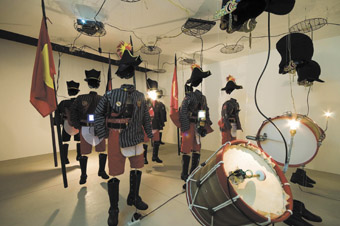
Kuswidananto a.k.a. Jompet, Java’s Machine: PHANTASMAGORIA (2008)
photo Norihiro Ueno, courtesy Yokohama Triennale
Kuswidananto a.k.a. Jompet, Java’s Machine: PHANTASMAGORIA (2008)
Java’s Machine: PHANTASMAGORIA (2008) by Kuswidananto aka Jompet (Indonesia) was perhaps most intriguing for its performativity, and not a performer in sight. Rather there were three rows of automated Javanese palace guards made purely from articles of traditional clothing. Some of these bodiless robots integrated small video screens showing a documentary piece also projected on the walls while two big bass drums played themselves at the front of the contingent. Beautifully constructed from low tech tools, the Disneyland automaton feel took on a strange mix of menace and subversive humour.
Spread across four venues including a site-specific element, Time Crevasses had many hidden joys, and provided an introduction to the cultural resurgence taking place in Yokohama including a new local government supported artist-run gallery district in the former redlight zone. Sitting in the amazing boat-come-hill construction that is the international passenger terminal after my day in Yokohama, I caught sight of two separate suns setting across the water behind me (a reflection of a reflection)—I was in a parallel universe indeed.
Trace Elements: spirit and memory in Japanese and Australian photomedia, curators Bec Dean, Shihoko Iida; Tokyo Opera City, July 19 – Oct 13. Trace Elements: will be presented at Performance, CarriageWorks Sydney Feb 19-March 21 2009, http://www.operacity.jp/ag/exh96/e/index.html
Time Crevasse, Yokohama Triennale 2008, various venues Yokohama, Sept 13 – Nov 30
http://yokohamatriennale.jp/2008/en/
The second stage of the residency-exchange between Artspace and Tokyo Wonder Site will take place at Artspace in Feb-March 2009 with the exhibition opening March 13.
http://www.tokyo-ws.org/english/
http://www.artspace.org.au/
RealTime issue #88 Dec-Jan 2008 pg. 14
© Gail Priest; for permission to reproduce apply to realtime@realtimearts.net
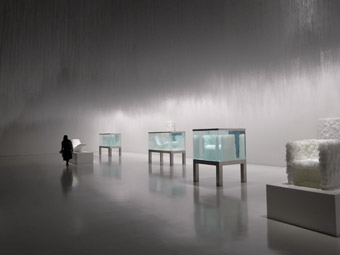
CLOUDS installation with some works, Tokujin Yoshioka
courtesy the artist
CLOUDS installation with some works, Tokujin Yoshioka
IN A STONE HALLWAY ON YOUR WAY TO THE SECOND NATURE EXHIBITION YOU COME UPON A SMALL TREE IN A BLOCK OF ICE INSIDE A REFRIGERATED GLASS CABINET. THE TREE, A CYPRESS PINE, HEALTHY, RICHLY GREEN, APPEARS TO FLOAT BEFORE YOU, THE ROOTS TRAILING, BUT UTTERLY STILL. IN A WAY MAKOTO AZUMA’S SHIKI 2 IS A COOL, GENTLY PREPARATORY GESTURE FOR THE WORKS OF TOKUJIN YOSHIOKA ASSEMBLED IN A LARGE ROOM WHICH AT FIRST ASTONISHED GLANCE HAS THE APPEARANCE OF AN ICE CAVE. IT’S LIKE WALKING INTO A FOG HANGING JUST ABOVE AND SOMETIMES IN FRONT OF YOU, BENEATH WHICH ARE PLINTHS DISPLAYING OBJECTS COMPOSED OF NUMEROUS CRYSTALS. OTHERS SIT IN SOLUTIONS IN GLASS TANKS, STRAY CRYSTALS CONTINUING TO FORM ON THE WALLS AMIDST THE SLOW BUBBLING OF LIQUID.
Second Nature is an exhibition of artworks in a program directed by Tokujin Yoshioka, the major component of which is his own most recent work which occupies and transforms the largest of the semi-subterranean galleries of 21_21 Design Sight. The gallery, established and directed by clothing designer Issey Miyake and partners, is built into the gardens beside the towering Tokyo Midtown business and shopping monoliths in Roppongi. The focus of 21_21 is design (Second Nature was also part of Design Tide Extension), bringing together artists, scientists and designers, including the increasing number who embody a number of disciplines. A key impulse for the Second Nature show is biomimicry (emphatically not to imitate or resemble nature, but to learn from it): “future-oriented ideas born from once again inquiring of nature.” The very title suggests that the creators of these works are drawing on something innate, in ourselves and in nature, but, writes the catalogue editor, Kazuo Hashiba, this “’second nature’…symbolises a ‘new kind of nature’, one that is desirable for the future of design.”
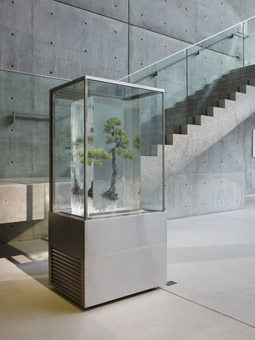
Shiki 2, Makato Azuma
photo Masaya Yoshimura
Shiki 2, Makato Azuma
The ‘fog’, titled CLOUDS, is made of thousands of immaculately gridded, thin translucent plastic fibres hanging from the ceiling (installed with the assistance of 100 design students). Below, the objects on plinths or hanging on walls are finished works: rectangles of crystals hanging like paintings, and couches—some chunky and rigidly symmetrical, others like sleek modernist chaise longues (their form inspired by Titian’s Venus of Urbino). They all glow and sparkle, conjuring cold and the magic of diamonds. The works inside the glass cabinets are still forming, growing on thin, curling synthetic fibres. In the cool, but not at all cold, calm of the room, passages of 19th century classical music can occasionally be heard: these turn out to be providing something more than relaxing ambience.
You can sit on a slab of glass titled Water Block, deep but strangely transparent, solid but evoking rippling liquid, and watch a film that shows Tokukjin Yoshioka researching and growing his crystalline sculptures, revealing painstaking attention to detail, complex procedures and a very surprising component of the process. The crystals are shaped by music—and not merely by inspiring the artist. The forms that eventuate are determined by the playing of music during the crystallising process: the works “are completed by the laws of nature and embodying a beauty born of coincidence”, writes the artist. The process is not explained, but Beethoven’s Moonlight Sonata has helped generate one work; another, forming in a blue-ish solution in the gallery, is aptly parented by Schubert’s Symphony No 7, The Unfinished; another, titled Destiny, by Beethoven’s Fifth.
A single human shape can be found among these works, a small classical statue of Venus on which crystals have grown, the past encrusted by nature, another layer of art.
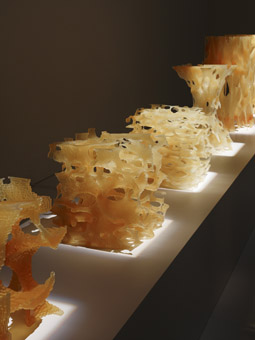
Cellular Automation, Origin of the Species 2, Ross Lovegrove
photo Masaya Yoshimura
Cellular Automation, Origin of the Species 2, Ross Lovegrove
Another aspect of the human is evoked in Ross Lovegrove’s Cellular Automation, Origin of the Species 2 (UK, 2008). Lovegrove has made bone mass structures that replicate and build on the discovery that “the science of structure was in making holes” (Michel Ragon, cited in the catalogue), His shapes appear beautifully organic but comprise small, often identical units, ‘digital’ in appearance. The catalogue editor writes that Lovegrove is seen as heir to Arne Jacobsen and Charles and Ray Eames “in a quest to recreate natural organic forms in mass-produced products”, but that he goes further in evolving organic design: “Instead of the designation ‘designer’, it might be more appropriate to call Ross Lovegrove a designer-cum-cell morphologist-cum-biologist.”
Before experiencing Second Nature at 21_21 in Tokyo, my companions and I walked an 8km section of the old Kyoto-Edo Highway across the Magome Pass to the village of Tsumago in the alpine Kiso Valley. Everywhere we witnessed and revelled in the artfulness of nature: boulders shaped as if sculpted, adorned with perfectly symmetrical moss patterns; the patterned shafting of light through bamboo forests; the musical dance of water rushing, flowing, trickling from every direction. Japanese artists, designers, poets, musicians and gardeners have long distilled these already essential forms into enduring art works. Second Nature continues a rich tradition, looking both to nature and the science of nature for inspiration.
Second Nature, directed by Tokujin Yoshioka, works by Tokujin
Yoshioka, Ross Lovegrove, Makato Azuma, Campana Brothers, Asuka
Katagiri, Keiji Moriyama & Takeshi Kushida, Yukio Nakagawa, Ambe
Noriko; 21_21 Design Sight, The Issey Miyake Foundation, Tokyo, Oct
17, 2008-Jan 18, 2009
www.2121designsight.jp; www.tokujin.com
RealTime issue #88 Dec-Jan 2008 pg. 15
© Keith Gallasch; for permission to reproduce apply to realtime@realtimearts.net

Leah Heiss, Diabetes Applicator Neck Piece
THE ARTS HEALTH SYMPOSIUM BROUGHT TOGETHER ARTISTS, RESEARCHERS, MEDICAL PRACTITIONERS AND ALLIED HEALTH PROFESSIONALS FOR A TWO DAY EVENT. THE PRESENTERS ARTICULATED DIFFERENT VIEWS ON HOW THEIR SPECIALISM INTERSECTED WITH THE ARTS HEALTH PARADIGM. PATRICK FUERY, DIRECTOR OF THE ARTS HEALTH CENTRE, UNIVERSITY OF NEWCASTLE, CHEEKILY ASSESSED THE UNION BETWEEN THE TWO DISCIPLINES AS BEING LIKE TWO POTENTIAL LOVERS DESPERATE FOR A FIRST KISS, BUT NOT SURE HOW TO INITIATE IT.
The four keynotes provided some broad architecture to the debate. The first speaker was Jane Davison, University of Western Australia, who wove together a useful overview of the history and evidence of music in a range of social contexts with examples from her practice involving the development of choirs with isolated older people. She argued for the concept of ‘musicking’, or the need to emphasise music in everyday life. Her research was based on the way music generates social capital: the pragmatic benefits of bringing potentially isolated people together, with the qualitative and indefinable qualities that music-making offers participants.
The need for evidence-based practice was a strong feature in a number of papers. Clearly this was a response to the dominance of scientific paradigms. If the arts are to prove themselves in a health context, they need to define themselves in terms that are acceptable to the orthodoxies of the field. Clive Parkinson, from the so-called ‘ministry for the bleeding obvious’, otherwise known as Arts for Health, Manchester Metropolitan University, argued that for most health professionals the link between the two disciplines is self-evident. However there is a strong political argument to be made particularly in a sensitive environment where a dollar spent on an arts health project is a dollar not spent on vital resources.
In the second keynote Graeme Sullivan, Columbia University, offered an alternative insight by critiquing how conventional systems of research are being challenged by post-disciplinary perspectives. Sullivan argued that the ‘empirical traditions’ of research are limited in solving problems in all contexts, and that increasingly a network approach is developing that seeks to ‘braid’ cross-disciplinary understanding. Sullivan’s theme was also reflected in a paper given by Christine Putland, Flinders University, who identified significant shortcomings in the present definition of what constitutes ‘evidence.’ She argued for new approaches to capturing the meaning of art in a health context, involving concepts such as pleasure, happiness and engagement in living.
The third keynote was a double act: Lizbeth Goodman, Director of SMARTlab Digital Media Institute (University of East London), and her colleague Mick Donegan. Goodman’s contribution provided an impressive overview of the work of SMARTlab, whose ethos is to invent technological tools that address specific social needs. This is high-tech community cultural development, which attempts to work from the needs of individuals and groups. Goodman’s achievements have won her and the team considerable global attention, and the presentation outlined an extensive range of innovative projects from an online support service for women and children experiencing domestic abuse (SafetyNet) to an international multi-media, multi-lingual disability performance piece (A Street Called Home).
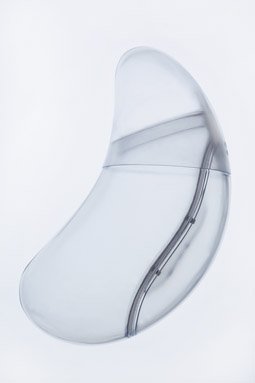
Leah Heiss, Arsenic Water Purifier
Her co-presenter, Mick Donegan, beautifully underplaying his supporting role, develops interfaces for assistive technology, specifically with clients suffering from cerebral palsy or severe head injuries. Donegan’s personal motivation in the research is to lessen the shortfall between the potential and the ability of individuals with degenerative diseases and paralysis. The Mytobii eyegaze system allows users to access computer software through recognising and following the movement of the eyes. Adapted from a marketing tool, the technology has been used to help people with a variety of disabilities to compose music, write emails, play games and listen to CDs. The presentation was a powerful reinforcement of SMARTlab’s commitment to humanising the possibilities of technology.
The final keynote was from Oron Catts, Director of SymbioticA, University of Western Australia, and was scheduled, unapologetically, as a provocation. SymbioticA is an ‘artistic laboratory’ focused on the research, learning and critique of life sciences. The centre is pioneering and exploring the relationship between the arts and a range of bio-medical research areas. The research is grounded in artistic experimentations under laboratory conditions; this is not artist as outsider, but artist as scientist. One of the examples was Victimless Leather, a Tissue Culture and Art Project which developed a “semi-living” leather jacket grown in the laboratory. Another example was Disembodied Cuisine (2003) in which the team attempted to grow frog skeletal muscle over biopolymer for potential food consumption. A biopsy was taken from an animal which continued to live and was displayed in the gallery alongside the growing “steak.” The installation culminated in a “feast” where the performers/scientists eat the steak.
If there is something of the freak-show mentality present in the work, it is a conscious one. Catts describes the practice as “philosophy in the wild”, of artists having an informed knowledge of scientific methods. He argues that artists should not just present or render scientific protocols, but should be conceptual artists manipulating working prototypes that simultaneously resist and explore scientific ways of seeing.
The keynotes were striking in their presentation of convergent and discordant issues that established some of the parameters of the debate within the field. The paper sessions were equally diverse with 26 papers organised into five thematic sessions, explored arts and health from a range of perspectives. There were presentations about Occupational Therapy and the use of photography, analysis of hospitals as cultural sites, the role of theatre in the wellbeing of refugees, a fascinating case study reflecting on the healing capacity of a Childers Backpacker Memorial, the socio-historical relationship between spirituality and medicine, and an analysis of how artist engagement with the AIDS campaign shaped and influenced changes in attitudes and behaviours.
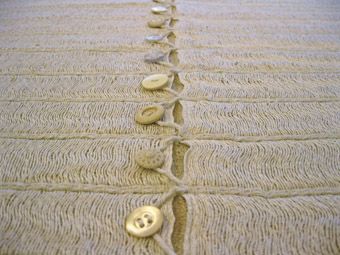
Birgitta Nordström, Memory, a funeral textile, 2008
The way artists interact with scientific paradigms was broadly interpreted. Birgitta Nordstrom’s delicate work with funeral textiles (Funeral Pall: Textile as Comforter; Sweden) explored the ways artists engage with death and the rituals surrounding it. The process of mourners taking ownership within the ceremony, of unfolding and draping the pall over the coffin, was described by Nordstrom as “the last opportunity to make a cosy and secure bed in which a loved one can rest.” Leah Heiss (School of Archiotecture and Design RMIT University) described her residency with Nanotechnology, Victoria. Rather than simply representing the technologies she found, Heiss developed “therapeutic jewellery” with the scientific team in which the design of the applicators (in this case for the treatment of diabetes) was considered in both aesthetic and practical terms.
Taken as a litmus test of where the arts health field is, the symposium made clear that definitions were elusive, and that the developing field struggles with borrowed terminologies that impact on its abilities to define its own discourse. There is still broad suspicion within the medical scientific field that the arts have a limited contribution to make, at best as an educational tool, at worst an indulgence. However, based on the quality of the contributions during the symposium, it was equally clear that the interactions and intersections between practitioners from both disciplines were filled with curiosity, appreciation and considerable respect for each other. There was a determination that medicine, science and art can have a potentially efficacious relationship, and a growing trust and interest in articulating how aesthetic-scientific networks might evolve.
The debate will continue with the launch of two new journals in 2009, Arts & Health (Routledge) and the online Australasian Journal of Arts Health, plus the promise of a follow-up symposium in Newcastle next year.
ArtsHealth Centre for Research and Practice, University of Newcastle, Arts Health Symposium #1, Newcastle Oct 8-9, http://www.newcastle.edu.au/research-centre/artshealth/
RealTime issue #88 Dec-Jan 2008 pg. 16
IT’S A MOMENTOUS YEAR FOR FILM IN AUSTRALIA, BRINGING A NEWLY CREATED SUPER-AGENCY WHICH WILL PROVIDE ALL FEDERAL GOVERNMENT SUPPORT, AND A NEWLY BEDDED IN PRODUCER TAX REBATE (OF 40% FOR FEATURE FILMS AND 20% FOR TELEVISION PRODUCTIONS AND DOCUMENTARIES) WHICH CARRIES THE PROMISE OF A SYSTEM THAT WILL RE-ENERGISE LOCAL PRODUCTION. THROUGH A CONCENTRATED PROCESS OF MINISTERIAL STATEMENTS, DISCUSSION PAPERS, DRAFT GUIDELINES AND INDUSTRY AND FILMMAKER MEETINGS AROUND THE COUNTRY OVER THE LAST MONTHS, IT’S BECOMING CLEARER JUST WHAT THE FUTURE HOLDS FOR FILM IN AUSTRALIA; A FUTURE, IN THE WORDS OF ARTS MINISTER PETER GARRET, IN WHICH THE GOVERNMENT IS EXPECTING THE FILM INDUSTRY TO “DEVELOP COMMERCIALLY FOCUSED SCREEN BUSINESSES.”
Speaking at a Melbourne Film Festival forum earlier in the year, Garrett said that filmmakers would be supported for developing productions that attract strong financial backing and are genuinely appealing to audiences; he emphasised that those who work in the industry “must change, look outward to the country and the world and enthusiastically reach out to them on the screen.”
What’s now becoming clear is that succeeding in this new environment is going to be a challenge to both experienced and emerging filmmakers. Much of Screen Australia’s support will be directed at producers with track records, albeit ones who also offer support to less credentialed filmmakers. With preference going to those with a range and a diversity of projects, a producer should be clever, hopefully original, and definitely very enterprising. The most immediate aim is to get Australian audiences interested in Australian films again; after the heady days of Muriel, Priscilla and Crocodile Dundee, when Australian films were taking a substantial slice of the box office. Local box office returns have shrunk in recent years to a miserable few percent.
Screen Australia has a stated commitment to screen culture (that rather nebulous area of support that includes film festivals, publications, screen industry awards, screening programs, industry conferences and seminars), as well as to distribution and marketing, but details of just what this commitment amounts to have not been released. In fact, those areas are apparently not even being considered until early next year. What has been on the table is what Screen Australia believed they could achieve in the coming calendar year.
Formed by the merger of the Film Finance Corporation, the Australian Film Commission and Film Australia as part of a process of review and implementation that extended over three years and through two federal governments, Screen Australia formally came into being on July 1, with the existing programs of the three agencies continuing until the end of the year while the necessary reorganisation and restructuring took place. In its draft guidelines the new agency has collapsed an enormous array of programs into quite a small number, arguing that funding was being spread much too thinly. It will still be responsible for development and production funding for what it calls “a range of audience engaging and culturally relevant” feature films, television drama, children’s TV drama, and documentaries. It will also fund workshops, hoping to do this in partnerships with the states and other bodies, and digital media through the Innovation Program, encouraging producers to look at multiple platforms for their projects.
What it will not be funding, and who it will not be supporting, has caused the most concern and adverse comment. It will no longer finance short film production and will also considerably reduce its support for new or less experienced filmmakers, arguing instead that producers supported through the new Enterprise Program (with a slate of productions), or the state funding agencies, can take up those activities. A number of filmmakers, either singly or in joint submissions, have argued strongly against this, saying that a viable industry needs up and coming talent, needs to nurture developing filmmakers, and that hoping or expecting producers or the states or some other entity to fulfill this activity is not good enough. At the very least, they argue, criteria relating to the outsourcing of professional development for emerging filmmakers should be applied to experienced producers supported by the Enterprise Program (currently the Enterprise guidelines include no criteria that require experienced producers to devote a percentage of those funds to help cultivate new and establishing practitioners).
And just how realistic is it that all the short and innovative projects currently being thought up by emerging filmmakers can now really only come to fruition through either cashed up Enterprise Program producers or the state agencies?
Both the Australian Writers’ Guild (AWG) and the Australian Directors’ Guild (ADG) have made very strong comments regarding what they see as the unnecessarily high bar applying to writers and directors, and the disproportionate emphasis on producers and production companies. What annoys them most is the inequity between the experience required of a producer, and the higher standard set for writers and directors. They question the research behind these standards, arguing that the levels of experience required are inappropriate. The AWG comments that “Screen Australia’s assertion at its consultation sessions that there are in excess of 70 screenwriters who qualify under the ‘three features’ requirement is incorrect; five to 10 is the accurate range. As such the guidelines will close yet another door to experienced writers in the Australian screen sector.” The AWG wants to see in the guidelines an acknowledgement of the importance of the script; recognition of the vital role of the screenwriter; and acknowledgement of the essential need for intensified, prolonged and properly funded script development.
The ADG also argues that while Minister Garrett stated that the industry would have a voice in the review process, they believe that “policy was largely crafted behind closed doors, and when consultation began, we were presented with broad principles that had been devised without any open debate about the big issues we face.”
Documentary makers, too, are concerned that Screen Australia is moving away from supporting and encouraging fresh talent, from giving emerging filmmakers opportunities to experiment and challenge while refining their craft, and have expressed this concern strongly. However, the documentary sector is very pleased with the National Documentary Program, and particularly with what they’ve understood to be part of the new Terms of Trade, the retention of rights by filmmakers and the abolition of the role of executive producer. That’s something documentary makers have been fighting for in the industry consultations for the past months.
Screen Australia has a new CEO, who took over mid-November. Dr Ruth Harley was CEO of the New Zealand Film Commission, which had been transformed during her tenure, with a sizable increase in the number of films produced, in revenue generated, and in both the size of the audiences and number of awards received by New Zealand filmmakers. She is a very interesting appointment, upholding the feeling within the industry that the government was looking outside the recognised possibilities. With more than 20 years experience in the film and television industries, Harley has a serious academic background and is a former Fulbright Scholar. She says that “getting Australian films to connect with Australian audiences is what everybody has expressed to me as their biggest concern”, and “is something I’ll be wanting to talk to a lot of people about, and I think a lot of people have got theories, and with luck we can pull those theories together into something that can make a difference.”
Already two feature films and seven documentaries are well under way using the producer offset. Screen Australia has been given financial stability for the next three years, although the federal government has removed some $10m from what would have been the total AFC, FFC, and Film Australia budgets which will affect the 2009-10 budget. The government believes that the reduction reflects the increasing role of the producer offset, and that “overall, the level of funding available to the film industry from the uncapped film offsets and Screen Australia has increased significantly.”
Following the final consultation process, Screen Australia is to release its final guidelines in December, with the new agency commencing activities under those guidelines on January 1. It will be instructive to see if any of the strongly worded comments and criticisms received has resulted in any changes.
Details of Screen Australia’s programs, the guidelines, and the many comments received can all be found on the Screen Australia website, www.screenaustralia.gov.au.
RealTime issue #88 Dec-Jan 2008 pg. 17
© Tina Kaufman; for permission to reproduce apply to realtime@realtimearts.net
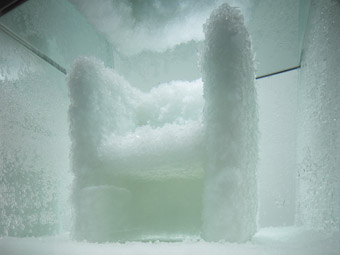
Venus, Natural Crystal Chair, Tokujin Yoshioka, from the 21_21 Design Sight show Second Nature, directed by Tokujin Yoshioka, Tokyo
photo Masaya Yoshimura
Venus, Natural Crystal Chair, Tokujin Yoshioka, from the 21_21 Design Sight show Second Nature, directed by Tokujin Yoshioka, Tokyo
to all our readers
have a cool xmas and
a calm new year rest
readying yourself for
the high dramas and
the great art of 2009
the editors
Image: Venus, Natural Crystal Chair, Tokujin Yoshioka, from the 21_21 Design Sight show Second Nature, directed by Tokujin Yoshioka, Tokyo, Oct 17,2008-Jan 18, 2009. See page 15 for a report on this fascinating bio-art exhibition. www.2121designsight.jp www.tokujin.com
RealTime issue #88 Dec-Jan 2008 pg. 1
© RealTime ; for permission to reproduce apply to realtime@realtimearts.net
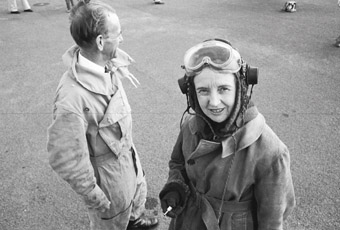
Max Price and Brenda Hean
LAKE PEDDER LOOMS LARGE IN THE HISTORY OF AUSTRALIA’S ENVIRONMENTAL MOVEMENT, A FOUNDATIONAL MYTH WITH A LOST SHANGRI-LA AND A MARTYR AT ITS CORE. A STUNNING INLAND BODY OF WATER IN TASMANIA’S REMOTE SOUTHWEST, FLANKED BY A PRISTINE TWO-MILE-LONG BEACH, PEDDER DISAPPEARED BENEATH DAM FLOODWATERS IN 1972, A VICTIM OF THE ALL-POWERFUL HYDRO ELECTRIC COMMISSION’S DRIVE TO INDUSTRIALISE THE ISLAND STATE. TASMANIAN-BORN DOCUMENTARY-MAKER SCOTT MILLWOOD TOUCHED UPON THE CAMPAIGN TO SAVE PEDDER IN HIS AWARD-WINNING FILM WILDNESS (2003, RT60, P17), AND HAS RETURNED TO THE STRUGGLE WITH HIS LATEST FEATURE-LENGTH DOCUMENTARY, THE MURDER MYSTERY-CUM-PHILOSOPHICAL REFLECTION, WHATEVER HAPPENED TO BRENDA HEAN?
Hean and pilot Max Price vanished without trace on the morning of September 8, 1972, while flying to Canberra to emblazon ‘Save Lake Pedder’ across the capital’s skies and lobby federal politicians on the ground. It was three months out from the federal election that was to bring Gough Whitlam’s Labor Party to power after 23 years in opposition, and Hean was seeking to make Pedder’s flooding a federal issue. The cursory police investigation that followed her disappearance failed to cast light on the activist’s fate, although there was evidence that the plane’s hangar had been broken into the night before the flight. Rumours of sabotage and a cover up have persisted ever since.
In the opening moments of the documentary, Millwood evokes the sense of loss that came with Pedder’s inundation through ageing colour archival footage of the lake and its stunning surrounds. The area’s ethereal beauty is obvious even through the scratches and dust flecks scattered across the film’s surface. Shots of Pedder are intercut with black and white news coverage of Hean and Max Price as they prepare for their flight north in Price’s ancient Tiger Moth. At the end of the introductory montage, Millwood enters the film through a contemporary radio broadcast and a TV interview, announcing a $100,000 reward for information leading to the solving of Hean’s disappearance.
Millwood began his career with the essayistic Proximity (1999), an autobiographical account of a soul-searching trip around the globe that took the filmmaker from shady homoerotic encounters in Iran to time in an Indian leper colony. Wildness was a more conventional, if still quietly poetic, made-for-television documentary. Whatever Happened to Brenda Hean? lies somewhere between the two earlier films, returning to the Tasmanian environmental concerns of Wildness, while foregrounding the filmmaker’s authorial presence as he delves into the fog of contradictory stories, rumours, myths and insinuations surrounding the Brenda Hean mystery. In doing so Millwood documents the Pedder campaign and the beginnings of Australia’s Green movement, but also probes the dark recesses of Tasmania’s history, and by extension his own identity as a Tasmanian.
Having established his hotline and publicised the reward, Millwood starts to follow various leads, ranging from amusing cranks to eye-witnesses to the ill-fated flight. He speaks to a farmer who claims to have seen Hean and Price fly over his family’s property as a boy, adding that he also once spotted a Tasmanian Tiger. A more credible series of witnesses report having seen the plane on its way up the state’s east coast. We also journey out into the Tasmanian bush with Stan Hanuszewicz and Derek Kooistra, who have been obsessively traversing the island’s northeast for over a decade, searching for the plane wreck using information provided by a clairvoyant.
The most startling turn comes when several interviewees suggest the Tiger Moth was sabotaged not in order to prevent Brenda Hean reaching Canberra, as has commonly been assumed, but to dispose of pilot Max Price. The aviator was, it seems, a well-known philanderer, and among other local women was having an affair with his sister-in-law. In addition, Price had supposedly uncovered information indicating his business partner was embezzling funds from their company, Tasmanian Aviation Services, and was planning to hand over the incriminating evidence to police upon his return from Canberra.
After more than an hour of false leads and conflicting theories and accusations, both Millwood and viewers are left feeling utterly confused. We see the filmmaker looking lost and alone on a hotel bed, admitting to his information hotline operator, “I don’t think we’re ever going to get to the bottom of this mystery. Not because we’ve found so little truth, but because there seems to be so much truth.” But just as Millwood’s search and the film’s narrative seem to be floundering, Whatever Happened changes gear.
Having conceded he is unlikely to learn what happened to Hean, Millwood begins to consider whether the swamp of innuendo and secrecy he finds himself mired in speaks of a deeper truth regarding Tasmania’s culture of repressed atrocities and extreme violence. In the process Whatever Happened becomes a film about the frustrations—perhaps the impossibility—of writing history in such a close-knit, tight-lipped community. Tasmanian Greens Senator Christine Milne comments at one point, “In other places, after 10 or 15 years, usually mysteries are cleared up. There are always ways in which the truth eventually comes out. But in Tasmania it never does. The secrets go to people’s graves with them.” In this context, the act of retelling the story of Brenda Hean, and the lake she fought to save, is almost as important as revealing the truth of her fate.
Throughout the film, Millwood obsessively returns to archival images of Hean and the lake, clinging to two central facts amongst all the deceit and legend surrounding this strange story. Hean was an ordinary woman who stood up to extraordinary power, and the lake was an extant place destroyed in a misguided ideological drive to turn Tasmania into the “Ruhr Valley of the south seas.” If we simply allow the story to fade into myth it becomes all too easy for the violence at its heart to recede into comfortable abstraction, divorced from a brutal reality of greed and political struggle. Furthermore, as Tim Flannery tantalisingly reveals towards the end of the film, the fulfilment of Hean’s dream is still possible. Unlike the extermination of Tasmania’s Indigenous population or the forced extinction of the Tasmanian Tiger, Lake Pedder’s flooding is a catastrophe that can be reversed, since the beach and the lake’s surrounds still lie intact beneath the dam reservoir.
In the film’s final sequence, Millwood travels by boat to the site that was once Lake Pedder and plunges into the dam waters. We follow him down as his flashlight illuminates a glass bottle lodged in the submerged sands. A relic of some long ago beach party? The last trace of the final vigil on the Lake’s shores? As Millwood scoops up a handful of buried sand we think back to the opening images of the snow-white expanse nearly four decades ago. We recall Brenda Hean walking on Lake Pedder’s shore and planning her flight north. We ponder Flannery’s claim that this beach, and the lake it once hugged, could be brought back to life. The sand trickles through Millwood’s fingers and is dispersed in the water, an ephemeral reminder of what Pedder was and the potential wonder that still lies beneath the dam’s surface.
Whatever Happened raises more questions than it answers, but perhaps their posing is all than can be expected of a humble documentary. What Millwood’s film does reveal is that answering the question of whatever happened to Brenda Hean will require more than just bringing to light the buried truths specifically related to her disappearance. The mystery surrounding her death speaks of a broader, more profound culture of silence, cloaking a systematic abuse of power and campaign of violence against the people and environment of the island state.
Whatever Happened to Brenda Hean?, writer, director, producer Scott Millwood, producer Michael MacMahon, writer Mira Robertson, Big and Little Films, Australia, 2008
RealTime issue #88 Dec-Jan 2008 pg. 19
© Dan Edwards; for permission to reproduce apply to realtime@realtimearts.net
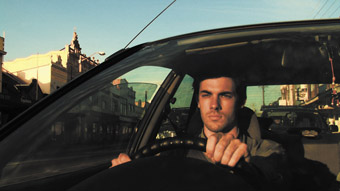
Road Movie, John Gillies
SYDNEY’S MUSEUM OF CONTEMPORARY ART RECENTLY HOSTED TWO INTERESTING CONTRIBUTIONS TO THE CONVERSATION AROUND MOVING IMAGE ART IN AUSTRALIA. THE VIDEO LOGIC SHOW AND A TWO-DAY CONFERENCE EVENT HELD IN CONJUNCTION WITH THE EXHIBITION, DISAPPEARING VIDEO, PROVIDED INSIGHTS INTO VIDEO ART HISTORY AND PRACTICE IN AUSTRALIA, AND ADDRESSED SOME OF THE ISSUES CONFRONTING WORK IN THE MEDIUM.
Video Logic curated by Russell Storer, consisted of a select set of works by artists who have contributed to the development of video work in Australian art: Eugenia Raskopoulos, Denis Beaubois, John Gillies, Adam Geczy, John Conomos and Philip Brophy. It cleverly revealed the breadth of video practice, ranging from Beaubois’ very video-specific investigations into surveillance technologies, to hybridisations with other forms, such as Raskopoulos’ work, which explores corporeality in ways that marry with performance art, and Geczy and Sculthorpe’s colour organ, connecting with the history of light art, music and abstract film. The compact selection offered an economical expression of the irreducible heterogeneity of video practice.
The Disappearing Video event, organised by Ross Harley and John Gillies, began with a rare historical survey screening which, Gillies explained in his introduction, was curated around the canonicity and availability of important works of Australian video art. It’s exhilarating to see a big overview program with a broad chronological sweep, and this one, taking in three decades of experiment, and most of the big names and key works, was a real ride. From the brilliant magnetic meddlings of electronic art’s earliest explorations to heavily distorted video clips and subversive scratch video, computer art, performance documentation and theatrical experiments, the screening developed a fascinating portrait of a diverse national history. What we saw in the program’s 90 minutes was a vivid demonstration of the many uses and pleasures of video for artists over the last 40 years: video as both plastic and graphic medium, valued for its ability to capture the ephemeral, as well as for its own expressive potential. Seeing the works all abutted, as they must be in a single-screen program, can be a rather intense experience—I saw a few furiously blinking eyelids at the screening’s conclusion as spectators’ heads swam with electronic imagery. Some momentary processing delays are, however, surely worth it for the sheer nourishment that a program such as this provides.
Installed in the conference venue was one of the first bona fide video artworks in Australia, Mick Glasheen’s Teleologic Telegraph from Spaceship Earth: On Board with Buckminster Fuller (1970, 28min), a seminal work in the ‘synthetic’ cinema described by Gene Youngblood. It featured, amidst various vibrant synthesised electronic imagery, a talk by the utopian architect on a 1968 visit to Australia. As Stephen Jones notes in his remarkable PhD research, Fuller’s talk is processed with “laser disk slow-motion, reverse-motion and freeze-frames, colour mattes, luminance keying and various kinds of video wipes some of which are modulated by Fuller’s voice” with effects “mixed through one of the earliest colour video mixers in Australia.” I loved it that this work, which illustrates the persistence of experimental and utopian documentary urges in Australian moving image art history, was posted in such a prominent position at the event. I also really loved the wry staging—plonked up on a plinth, almost at eye-height, the sculptural qualities of the installation meant that Fuller’s hypercoloured head floated amongst conference delegates’ own, delivering a disembodied address from the past on the future (and making for fun and games in the coffee breaks). This installation also subtly foregrounded the conference’s enquiry into preservation and restoration. Compared to the grimy, dropout-ridden U-matic tape I first viewed of this work some years ago, Stephen Jones’ digitalised preservation version of Teleologic is bright, clean and crisp—virtually another work altogether. The experience was both sobering—for the realisation it ushered in about the role format loss and degradation play in the experience of a work’s textuality—and joyful. It looked fantastic.
The conference proceedings began with Jones’ “dissassembly” of video art. Teasing out some of the elements which have been ‘subsumed’ in the (scant) narratives that exist of this kind of work, he explored the methods and intentions of the first generations of artists working with art and technology. Undergirding the extraordinarily technically detailed discussion was Jones’ archaeological approach, which grounds electronic art in a specifically televisual—as opposed to cinematic—tradition. Tracing video history back to the history of scanning technology, which first emerged in the mid-19th century, he showed how thinking about time-based art could be connected to an electrical, scan-based tradition which extends beyond narrative into the abstract. I found his emphasis on why we should be interested in interactive processes of input/output, video feedback, and their relationship to human consciousness, particularly resonant for thinking historically about video art.
This was the ideal opening salvo in what was to be an intense day. In my own talk I discussed “disappearing” in the context of forgetting and remembering in Australian history and art. I suggested we could take a few cues from other nations whose foregrounding of “artists’ film and video” discourse—as opposed to “new media art” and “video art” etc—seems to have paid dividends in terms of both institutional recognition and audience awareness of the work. I was then completely eclipsed by the dynamic John Conomos who followed with an extraordinary, performative address about the moving image as a form of writing with special focus on the essay. Laced with irony and delivered with total panache, Conomos’ free-ranging talk left some big impressions (for me, not least, his description of being “cauterised to [his] seat” at the Bucky Fuller session captured by Glasheen in Teleologic, while being “totally intellectually raped” by the visiting American).
In his confrontation with the disappearance of historical works from public memory amidst the ascendancy of the “morphing cult called new media”, Conomos noted the lack of dedicated videographic facilities at key art institutions. This theme was the one developed with most intensity, even ferocity, in the discussions after talks. Genuine, impassioned debate broke out over what exactly the remit of institutions in providing moving image access facilities is, and should be. Scholars and participants recounted tales of cupboards full of mouldering tapes, mass culls, threadbare collections, overstressed staff, deterrent-level fees and other ongoing tragedies. While there is doubtless much that needs to be remedied at the level of institutions taking moving image art and its history seriously, as others pointed out, institution-bashing, though cathartic, is not the most useful long-term strategy. Rather, the consensus seemed to be that a set of deliberate strategies, starting with a heritage mindset and emphasis on preservation and access, might be the way to start redressing the loss of cultural memory and ‘cultural amnesia’ many speakers noted as endemic to Australian (moving image art) history.
Intensifying our understanding of the particularity of Australian work, Lyndal Jones’ elegant presentation offered a fascinating survey of her work in moving image. This brought a welcome focus on artistic practice over a period of immense technological change, and provided some much-needed insights from the artist’s point of view, from how to compose for the pragmatics of sound in installations (“we don’t have earlids”), to other thoughtful observations on the construction of works for empty versus peopled spaces. I particularly liked Jones’ quotation of Hélène Cixous’s notion of “writing by the light of the axe” as a metaphor for the way artists not only make work, but have to talk about it.
In her spirited address, Louise Curham provided a glimpse into the climate-controlled terrain of moving image archives, and shared with us the fascinating world of physical, biological and chemical decay. Though she was perhaps too modest to mention it herself, I was struck by the crossover between Curham’s professional expertise in the arena of decomposition and her artistic interest in deliberately ‘tortured’ hand-processed film in the projected environments and single-screen works for which she is rightly feted. Discussing the archival detective work that makes the encounter with “orphaned” and other mysterious works so electrifying, Curham argued convincingly for an approach which considers, and attempts to preserve, both the work, and the context of which it is part. She also spoke to the critical mass gathering around the “historical turn” in thinking about the moving image—at the precise moment when, as digitalisation is nearly complete, the reality of format obsolescence is beginning to make itself felt, and various other major initiatives to preserve and restore moving image work are underway.
Visual art critic Andrew Frost wrapped things up with a timely rumination on the unfolding possibilities of a medium which has mutated so much in just a generation. “Once a career step to obscurity and outsider grumbling”, Frost noted, “video has now become mainstream practice.” His amusing prognostications for what might lie ahead for the changing landscape of video art masked the more serious mood uncovered at the conference as the realities of a reeling economy and decomposing materials sank in. As John Conomos said, the “nagging, half-glimpsed” realisation is that the “continuing dialogue between the past, present and future” of video art is up to us.
Video Logic, video art exhibition, curator Russell Storer, Aug 19-Nov 2; Disappearing Video conference, organiser Ross Harley, John Gillies, speakers Stephen Jones, Danni Zuvela, John Conomos, Louise Curham, Lyndal Jones, Andrew Frost; Museum of Contemporary Art, Sydney, Oct 23-24
RealTime issue #88 Dec-Jan 2008 pg. 20
© Danni Zuvela; for permission to reproduce apply to realtime@realtimearts.net
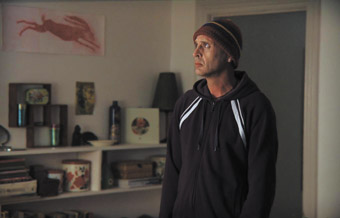
Alex Martin, Next of Kin
IT WAS QUITE REFRESHING TO SEE A FILM THAT DID NOT CONCERN ITSELF WITH WHAT I’VE COME TO SEE AS DOMINANT TROPES IN TASMANIAN CULTURAL FORMS, WHICH I USUALLY NAME AS CONCERNS WITH PLACE AND HOW PEOPLE FIT INTO IT. IT’S ALWAYS BEEN EASY TO SEE WHY, GIVEN THE ASTONISHING LANDSCAPE AND THE DRAMATIC WEATHER DOWN HERE, BUT THERE ARE OTHER STORIES THAT NEED TELLING THAT MAY NOT BE QUITE SO FOCUSED ON BEING HERE, LEAVING HERE, AND RETURNING HERE. THERE ARE SOME PEOPLE WHO HAVE OTHER ISSUES TO DEAL WITH.
Next of Kin, Rose Schramm’s nine-minute short could really have been made anywhere and this is part of its achievement as a film made in Tasmania; it doesn’t look or feel particularly of this place. Far from an interaction with cold mountains and dense bush, the film has a distinct urban feel, when the plot takes us outside at all—it could be out west in Sydney, it could be a chunk of Zone 3 Melbourne. Much time is spent inside in tight, slightly odd interiors that are subtly colour coded; the film has a fairly meticulous, stylised feel. It’s a tiny world with just two people in it: Angela (Gemma Gates) and Laurie (Alex Martin). Martin, in particular, gives a remarkable performance, all the more noteworthy when you learn he’s never acted before and probably never will again. Laurie’s been away, somewhere, and has been out of touch with Angela for some time. She’s shocked, and possibly worried, when he contacts her after he’s been released from some kind of psychiatric hospital. Laurie has named Angela as his next of kin which, as Schramm pointed out to me when I spoke with her about the film, makes Angela responsible for him. Laurie has changed somewhat in the lengthy time since Angela knew him last, ie, from male to female. This change is far more a broad symbol than it appears at first to be though; the filmmaker has worked to capture a sense of the shock of someone you knew very well being different somehow, whether by accident or design.
“What I first wrote it about was how sometimes a child-parent relationship can turn the other way—particularly with mentally ill parents, [children can] end up becoming the parent[s]. It’s sort of about mental illness, but I don’t want to exactly say that. It’s not about transgender; it’s deeper than that. I mean I already did that [Schramm’s 2004 student documentary, Rachael, told the story of her father’s journey to becoming a woman at 65 years of age]. I wasn’t writing exactly from my point of view, it was more about a daughter who’s trying to be an adult or a father who won’t take responsibility for his role. It’s not my life but I can draw from my experience to make those characters believable, because it’s an unbelievable situation. There’s not a lot of reality in that. But it’s real.
“I was also writing about how, sometimes the child, grown up or not, doesn’t really want to hear a lot of things; it’s hard enough. It would be quite surreal sitting next to your father and he’s dressed in a frock. I was also looking at how you’ve got to grieve in a way, because you know that the person they were is never coming back. Seeing someone with different inflections, all the old gestures disappearing and that sort of thing, I wanted to portray a bit of that no going back.
“I just got these two characters in my head; they stayed in my head for about six months. I’d just done a script writing course. I was bored and they just came up. It’s not the film that came into my head, it was the characters. Now I’ve got three more characters who’ll be in the next film. I haven’t actually written a script, I just spend all day thinking about the characters, for about three or four months, but I can’t write a script unless the characters are there. I never thought I was going to write drama, ever. I always thought I would make documentaries. When I went into film making I thought that’s all I want to make. Then I was bored.”
Ideas are one thing, mechanics are quite something else. Schramm is a camera operator and editor by trade so the film’s existence comes as something of a surprise, not in the least to her. She seems to have almost made it by accident, but it was all due to her participation in the Raw Nerve 08 program.
“It’s an initiative between Wide Angle Tasmania and Screen Australia; they’ve been going on in other states for a few years and last year we got funding to have one in Tasmania. There was an invitation to put in either a first draft of a script or an idea for a script; if you were accepted on your first draft you went through a lot of script development, given a script development mentor, an executive producer and then given not very much money, $2000, almost all of which went on the cinematographer Simon Gray. He was worth it. He was great. People were telling me not to, they were saying you can’t get him, he’s from Sydney and I knew nothing about him. I went completely on intuition. I‘d not seen anything he’d done. He was the director of photography, so I was behind the camera, but he was working it. I even had a focus puller. It’s the first professional shoot I’ve ever done. Now I’ve got a Slingshot grant and I’m going to try and get Next of Kin into festivals.”
Schramm has another film project on the horizon, a story about growing up Catholic in the 80s. When she told me what it was about, I laughed a lot. It sounds deceptively simple, but later I wondered, with a little trepidation, what territory she would take that simple premise into, given the raw and potent emotion she produced in Next of Kin.
Next of Kin, producer, writer, director, editor Rose Schramm, cast Gemma Gates, Alex Martin, director of photography Simon Gray, series producer Chris Gallagher, executive producer, Beverly Jefferson; made with the assistance of Screen Tasmania, Wide Angle Tasmania, Screen Australia, SDA; Raw Nerve 08 program
RealTime issue #88 Dec-Jan 2008 pg. 21
© Andrew Harper; for permission to reproduce apply to realtime@realtimearts.net
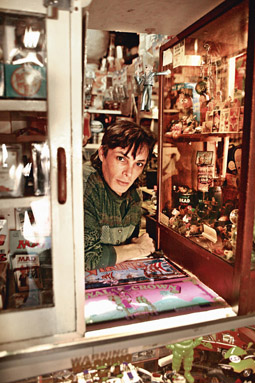
Richard Blackie
photo Steve Bacon
Richard Blackie
RICHARD, THE MOST INTERESTINGEST PERSON I’VE EVER MET, IS A FUNNY-SAD DOCUMENTARY OF THE LIFE OF AN IDIOSYNCRATIC INDIVIDUAL—RICHARD BLACKIE, 41 YEARS OF AGE, A FORMER AND VERY CONVINCING MICHAEL JACKSON IMPERSONATOR, BONSAI GARDENER AND TOY COLLECTOR OF 20 YEARS, WHO BECAME AN ANTIQUE AND VINTAGE TOY SHOP OWNER AND WHO SUICIDED BEFORE MAYA NEWELL’S FILM WAS COMPLETE. SHE WAS 17 AT THE TIME AND A STUDENT AT THE SYDNEY FILM SCHOOL AND UNTIL PERSUADED OTHERWISE, THOUGHT THERE WASN’T ENOUGH OF RICHARD’S LIFE IN HER FOOTAGE TO MAKE A COMPLETE FILM. HOWEVER IT PREMIERED AT THE 2007 DIRECTOR’S FORTNIGHT IN CANNES, IS NOW AVAILABLE ON DVD AND DESERVING OF A WIDE AUDIENCE.
The power of the film is generated by the dynamic between how little we learn about Richard (Newell eschews standard documentary story-telling and there are no interviews with her subject’s friends or acquaintances of whom there were possibly few) and the feeling that we’re building a very strong impression of an intensely private and secretive man—narcissistic, obsessive, authoritarian, but all in the nicest possible way. This is compounded by Newell’s approach, which is informal, patient and gently probing, and Richard’s response which is cautious and evasive, but at the same time characterful, often droll and very immediate. He’s also very controlling, visibly determining the duration of a conversation or deliberately keeping his distance from the camera. At one point early in the film he takes the camera and turns it on the filmmaker, a moment illustrating his playfulness, authority and the acknowledgment perhaps of a creative partnership, and one where, with unconscious prophetic irony, Newell shyly promises to make his collection of toys live on. He wants this film—of “the most interestingest person you’ve ever met”—to be made.
After Richard’s death well-known poet and screenplay writer Billy Stoneking Marshall told Newell, who felt her project was lost, that she had the makings of a film not so much about Richard as her relationship with him. Not surprisingly then, except for the brief glimpse of a cemetery at the film’s opening, a few shots of the immediate front of Richard’s shop and, much later, his doomed foray into an auction house, there’s no sign of the outside world save the visit of an occasional customer or postman. Tellingly, you’ll find some wider shots of the street, and some plainer statements of fact (Richard telling Newell that he was an orphan), in the out-takes on the DVD. Clearly Newell and her editor have focused the film tightly on Richard’s closed world and his meetings with the filmmaker, and cleverly and effectively so for a film which, on the surface, displays so little artifice.
This interplay of immediacy and the witholding of information and speculation is amplified by frequent filming of Richard in hand-held close-up or medium shot in the crowded confines of his shop, in narrow corridors, or perched by display cases having a smoke, or with his small dogs in his tiny kitchen, the camera looking around the corner or over his shoulder. The viewer constantly reads the strange, handsome architecture of Richard’s face—male, female, Aboriginal (compounded by occasional touches of Aboriginal English), the result of surgery? But if information is short, emotion is not, and although not expressed overtly we are witness to Richard’s growing anxieties about the failure of his shop and the need to sell his beloved toy collection (to get himself out of debt). He dreams of creating a museum from his remarkable collection (with which we grow steadily and fondly intimate), but he can’t get local council support. He’s momentarily buoyed by the prospect of profit from the auction, but, at around that time, in his sleep he smothers the one puppy he was going to keep from a new litter. The film’s most emotionally demanding passage is of Richard placing the body of the dog in box, adding Newell’s name to the inscription, and then burying the box in his backyard. Here, there’s restraint on both sides of the camera and we feel we’re in the grip of a chilling inevitability. In the notes accompanying the DVD, Newell writes that she had no idea that Richard would kill himself. That only became clear as she looked back over the five hours of footage she had recorded over three months and is subtly built into the film’s structure. The youthfulness of Newell’s voice, the naivety of some of her early questions and the wisdom evident in her final voiceover make Richard an unusual rite of passage film. Early on, Richard tells Newell, “I become under a code in life where you don’t reveal your life too much, you know. You’re more behind the curtain for what you do. So you’re very very privileged.” And thanks to Newell, so are we, because she has lifted the curtain just a little to reveal a fascinating, seriously funny, complex person, and asked that perplexing question, can we ever foretell a sucide?
Angie Abdilla’s 25-minute documentary Wanja is, at one level, a fond eulogy for Wanja, a blue heeler with an intense dislike for police officers. At another, it’s a lament for a dying community, Redfern’s The Block, in inner suburban Sydney. The interviewees are mostly Aboriginal elders, some bitterly hostile to the police, suspecting them of having killed Wanja. One man blames his own community for its troubles as much as the police, not least because of drugs, another the government for eliminating a large number of houses and reducing Aboriginal control of the area. These brief statements are insterspersed with re-created images of Wanja in basic blue-tinged video, wandering the streets like a phantom guardian of the community, and other footage that lingers recurrently over the pruned back Block, wasted houses and the art and graffiti of Aboriginal occupation on building walls. Other footage constructs the imagined view from the police surveillance cameras atop the tall building diagonally opposite The Block. Save for its moments of anger, Wanja is a gentle, carefully paced weaving together of points of view (personal and cinematic)—a meditation on a culturally signficant but sad place.
Richard, the most interestingest person I’ve ever met, a film by Maya Newell, 2007, Siren Visual DVD, 52mins, www.sirenvisual.com.au; Wanja, writer, director Angie Abdilla, producer Tom Zubrycki, editor Leah Donovan, sound design David White, cinematography Kim Batterham, Sean Bacon, 2008, 25minutes.
RealTime issue #88 Dec-Jan 2008 pg.
© Keith Gallasch; for permission to reproduce apply to realtime@realtimearts.net
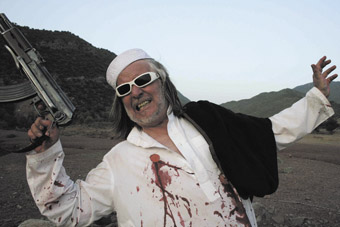
The Miscreants
THE MOST STARTLING MOMENTS AT THIS YEAR’S SYDNEY UNDERGROUND FILM FESTIVAL (SUFF) WERE NOT THE VOMIT, SLASHINGS, BLOOD, TURDS OR SLIME—THOUGH THERE WERE PLENTY OF THESE—BUT THE AUDIENCE’S DISBELIEF WHEN CONFRONTED BY THE MAINSTREAM, ESPECIALLY HOLLYWOOD. THIS REACHED A HIGH POINT AT THE AUSTRALIAN PREMIERE OF SLIPSTREAM, THE FEATURE-LENGTH MOVIE STARRING, WRITTEN AND DIRECTED BY ANTHONY HOPKINS, WHO ALSO WROTE THE MUSIC.
There were incredulous whispers: “Is this the Anthony Hopkins?”, “Anthony Silence of the Lambs Hopkins?”; “Sir Anthony Hopkins”? But indeed it was. Co-starring John Turturro and Christian Slater, Slipstream owes something to David Lynch but also to the globally dominant cinema that created Hopkins the Oscar-winning actor and has given us distantly similar forays into memory-lapse such as in the Bourne franchise movies. MTV also has some sort of relationship to the extraordinary and often extremely rapid editing in Slipstream that takes us in and out of the fantasy and reality in the mind of a Hollywood screenwriter (Hopkins) who may or may not be mad.
Slipstream was a real surprise for anyone believing the gap between mainstream and the underground to be huge and who define the underground in terms of its art and opposition to all that it is conservative, reactionary and commercial.
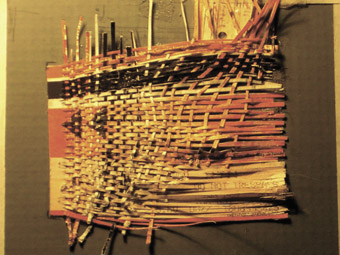
Ticketweavels
Another big surprise was the quantity and quality of Australian films. Caroline Huf’s Ticketweavels, for example, is a short, sad love affair between two Sydney train tickets that creates an animated existential crisis for the lovers. The deserved winner of the Material Effects award, Jessica Mutasco’s Paneye, is an impressive stop-frame exploration of corporeality as the conduit for converting inner perception into an external image. Peter Newman’s formal Paperhouse: the 5:19 is a disturbing video fusion of image and meaning. Geoff Wheatley’s achingly lovely Light/Strike (An Open Window) captures uncanny, wafting images from the past with a 1975 original Sony Portapak.
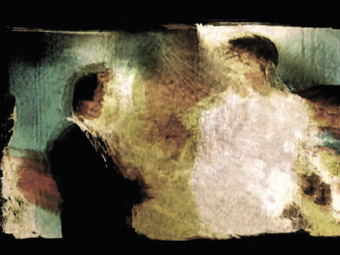
Paperhouse
And, as ever, Paul Winkler’s fertile imagination refreshed our inner-eyes with his glorious technicolour (not actually, but certainly glorious) Many Buddhas. Running film partially exposed in horizontal and vertical stripes and patterns through his camera as he has done for many years, Winkler’s images bore their way into our mind’s eye where they resonate, echo and repeat like a visual ear worm—while also managing to be different each time.
Was it the presence of senior filmmakers of the experience and calibre of Hopkins or Winkler which created a strong historical ether that pervaded the weekend? Whatever the cause, it became increasingly difficult to understand claims of the avant-garde to be at the forefront of filmmaking practice. In the turbulent storm of moving image art which is, or aims to be, ‘progressive’, the past tends to appear and reappear in underground cinema: it’s a two-way process and it is hard to know which way history’s angel is looking.
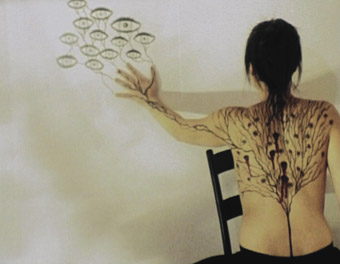
Paineye
The documentary, a genre devoted to the past is not widely associated with the underground although there are many instances—Buñuel’s 1932 Las Hurdes (Land without Bread) is a notable early example. Many of the docos at SUFF this year outshone the fictional, the abstract and the frequently rather conventionally formalist avant-garde and experimental and called into question the whole definition of underground.
George Gittoes’ The Miscreants is a superb documentary. Reflexive, self-deprecating, and fiercely political, this is the last in his trilogy about the impact of US aggression in the Middle East upon art and creativity. Humour and hyper-reality are so mixed up that it becomes impossible to know whether a gun or a camera is doing the shooting. One can’t always fathom who’s doing the shooting, nor distinguish between the good and the bad guys. Laughter quickly turns to chilling fear as realisation of the implications of Bush’s foreign policy sinks in.
SUFF co-director Stefan Popescu claims Gittoes is a ‘film artist’ who responds to state sanctioned terror through his art. But is he an underground film artist? His is a doco, after all, that might well be screened on mainstream television, perhaps even in the local multiplex.
Less difficult to categorise is the compelling Czech documentary, Lost Holiday (director Lucie Kralova). This makes innovative use of sound and form to shape a story about some missing holiday photographs into a mesmerising experimental transnational detective story and a reverie upon the role of the camera (still and moving) in the evermore intense and speedy passages of global cultural flows. This is more clearly the work of a film artist than many of those in the diverse collection screened over the weekend.
But does it make sense to claim the film artist for the underground? Where does this leave the national mainstream cinema? Over and over, Hollywood has not only proved the genius of its system by absorbing ideas, images, sounds and other cultural phenomena from alternative cinemas to create something new, but also by introducing invention and creative innovation to its so-called radical ‘other.’
One criticism I have of the SUFF is that too often the curators gave the benefit of the doubt to the film when more rigour would have been valuable. It’s not just that there were a few too many cute-but-naughty animated lumps of clay, silly penis jokes and women getting vigorously bonked from the rear (not always violently but usually so), but that these do not the underground make.
SUFF was successful, however, in showing just how heterogeneous the underground is and, in effect, pushing the definition of underground filmmaking to new (or back to old) boundaries.The festival offered films ranging from John Waters’ still outrageous 1981 classic Polyester to the undeniably enjoyable, if Tarantino/Rodriguez-inflected, Austrian On Evil Grounds (Peter Koller) which is more B-movie than underground; and from the wondrously abject New Zealand short Eel Girl (Jennifer Scheer) to Song Sung Blue, Greg Kohs’ documentary feature about the husband and wife tribute band, Thunder and Lightning. This very straight doco has been selected for some very conventional mainstream film festivals this year: does this make the Philadelphia or the Melbourne International Film Festival underground? Or does it mean that mainstream and avant-garde exist in productive tension?
I like blood, pus, piss, sex, cum and a good dollop of sparagmos and evisceration as much as the next underground addict. But it felt good to be reminded that the intellect can be challenged as well as the gut and the genitalia. After the weekend the SUFF morphed into a symposia and an art gallery event at the Sydney College of the Arts. Poorly attended, maybe, but hugely valuable.
We were treated to an exhibition curated by Jenny Brown of films and other artefacts by the New York’s celebrated underground Franklin Furnace Archive and some lunch-time lectures. Melbourne Underground Film Festival Director and filmmaker Richard Wolstencroft showed an extract from his new film, The Beautiful and the Damned, teaching us that the underground can include a film based on a book that appears on many an undergraduate literature reading list. Sydney experimental media artist, lecturer and author John Conomos offered us yet more blurring of cultural boundaries. After seeing a couple of bewitching extracts from his amazing repertoire, including one work in progress filmed at Canberra’s disappearing and reappearing Lake George, I drove straight to the Museum of Contemporary Art to see his film Autumn Song Take 2 at the Video Logic exhibition [page 20]. Conomos is the sort of filmmaker who leaves you wanting more.
In offering such diversity and by paying attention to cultural crossovers, audiences could learn, or learn anew, not only how to challenge and how to see, or ‘read’ underground cinema but also how to reimagine mainstream cinema. SUFF, now two years old, has become indispensable to Sydney screen culture.
Sydney Underground Film Festival, co-directors Katherine Berger & Stefan Popescu, The Factory, Sydney, Sept 11-14
RealTime issue #88 Dec-Jan 2008 pg. 22
© Jane Mills; for permission to reproduce apply to realtime@realtimearts.net
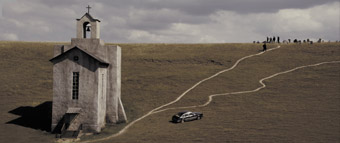
The Banishment
THE SEARCH FOR AN IMAGE OF NATIONAL IDENTITY IS A CENTRAL PREOCCUPATION IN CONTEMPORARY RUSSIAN CINEMA. THIS IS HARDLY SURPRISING—RUSSIA’S BEEN THROUGH A LOT OF SIGNIFICANT CHANGES IN THE PAST 20 YEARS. THE COLLAPSE OF SOCIALISM, THE RESULTANT RECESSION, THE MORE RECENT BOOM AND THE WAR IN CHECHNYA HAVE UNFOLDED DURING A TIME OF SIGNIFICANT MIGRATIONS BETWEEN THE OLD SOVIET REPUBLICS. DEMOGRAPHICALLY, ECONOMICALLY, CULTURALLY, RUSSIA TODAY IS A VERY DIFFERENT PLACE THAN IT WAS ONLY A FEW YEARS BACK; SO MUCH SO THAT MANY OLDER RUSSIANS CLAIM TO BARELY RECOGNISE THE PLACE. IN LIGHT OF SUCH MAJOR TRANSFORMATIONS, IT MAKES SENSE THAT RUSSIAN CINEMA SHOULD BE FOCUSED RATHER INTENTLY ON DOCUMENTING WHAT KIND OF A PLACE THIS ‘NEW RUSSIA’ IS. AND AT THIS YEAR’S 5TH ANNUAL RUSSIAN RESURRECTION FILM FESTIVAL, THIS CONCERN FORMED THE THEMATIC BACKDROP TO ALMOST ALL OF THE NEW FILMS SHOWN.
At the top of this year’s list was Andrei Zvyagintev’s second feature The Banishment (2007), to my mind it is one of the few genuinely great narrative films of this century. Delicately composed around a scenario of grief (the details of which are, believe it or not, of secondary importance), The Banishment employs style over plot to enter an emotional, metaphysical, even spiritual narrative realm. It’s a realm beyond language, of sounds and passing visions, an uncanny space where dream, reality, nightmare and archetype overlap, and through which humans pass, often unaware of its many details. The vision Zvyagintev presents of this life is uncompromising, life is difficult, and no doubt many viewers will find the director’s typically Russian preoccupation with death too bleak. But there is also potential redemption here. So much of our lives, it seems, remains unspoken, unshared, unnoticed, and it is these gaps between expression and between each of us, that the director seeks to open up with The Banishment. I was left spiritually shaken by this film, as if a formally dormant part of my life had been prodded and awoken. There are few cinematic experiences I can compare it to.
If The Banishment was the dark jewel of the festival, the gala film (the type of feature that goes rather well with smoked herring and vodka cocktails) was Karen Shakhnazarov’s The Vanished Empire (2008). Set in 1973 at the high water mark of the Soviet state, this refined pseudo-autobiography unfolds around the slow awakening to adulthood of young Muscovite Sergey Narbekov (Alexander Lyapin). A brash, cocky, “would-be-intelligent-if-he-weren’t-so-stupid” kind of guy, Sergey is your standard model, post-adolescent male who just happens to live a few blocks from the Kremlin. Uninterested in the glorious history of the Communist Party, Sergey’s principal concerns include acquiring a black market copy of The Dark Side of the Moon, smoking grass with his loafer friends and getting it on with the leggy brunette who sits two rows in front him at the pedagogical institute. This is, at least, until the high energy of Sergey’s hormonal influx is met and pulverized by the equal and opposing force of true heartbreak.
A nostalgic film, full of happy colours and conspicuously free of secret police, The Vanished Empire is far from the dark history of Brezhnev era Russia that audiences might expect. Indeed, its director Shakhnazharov has been criticized by more than one reviewer for indulging in an unforgivably rosy representation of life in the late Soviet system. Such criticisms are further provoked by the film’s coda, where a now 50 year old Sergey bumps into his former chum Kostia in Moscow’s vast and depressing Sheremetyevo airport. Both have now left Moscow and both are relatively bemused by what they find. “Where’s Moscow?”, the sad and puffy eyed Kostia asks. “I look around, and I don’t recognise anything—everything is foreign, evil.” While this is a view that Shakhnazharov cares neither to affirm nor refute, what remains at the end of The Vanished Empire is a strong sense of the disappearance of an identity, both national and personal. It is perhaps the ageing Sergey’s nostalgia not for Russian socialism but for his young self that colours this film so strongly.
A more modest production was the young director Vera Strozheva’s Traveling with Pets (2007), winner of the Best Film Award at the 2007 Moscow International Film Festival. A minimal narrative, Strozheva’s film tells the story of Natalia, an enslaved and emotionally frozen young woman who suddenly finds herself freed from bondage when her cruel overlord/husband drops dead one cold morning. As Natalia hauls the fat corpse to the morgue, a younger and far more desirable Russian beau makes his move on the woman’s body. And though for a time Natalia submits to her new mate, it soon begins to dawn on her that this is all tastes a bit too much like the same old wine. So she paints a canoe and begins a search for happiness elsewhere.
Like the more difficult The Banishment, Traveling with Pets provides a clear example of the influence of Andrei Tarkovsky on young Russian filmmakers. Although not a particularly complex, religious or philosophical drama, Strozheva’s film nevertheless employs the distinctively Tarkovskian approach by engaging its audience in a kind of metaphysical journey through a subjectivist Russian landscape (captured in typically beautiful de-saturated tones by director of photography Oleg Lukichev). Simultaneously personal and allegorical of the nation at large, Traveling with Pets was another film concerned with the finding of identity, in this case not an identity lost, but an identity yet to be discovered. Watching Natalia’s face gradually open over the course of the narrative, Strozheva invites her audience (though without obligation) to witness the thawing of Russia.
These were just a few of the stand-out films at this year’s resurrection. It was a fine season—a real reflection of the health of the Russian film industry today. And had I the room I would just as willingly heap praise on Nikita Mikhalov’s legal drama 12 (2007), Sergei Dvortseyov’s lovely Tulpan (2008), Alexei Uchitel’s harrowing war-drama Captive (2008) and Aleksei Popogrebsky’s multi award winning Simple Things (2007). All of these films were, of course, quite different. But in saying that, it’s not altogether irrational for a person to claim their general appreciation for Russian cinema. There is a perspective that a national cinema adopts—a position in relationship to the rest of the world. And in Russian cinema this position tends to be at one step removed from what we are used to here in Australia. It’s an aloofness to the rules of the game that we might label “reflective”, or “eccentric” or just plain “deep.” In any case, it’s helpful to take a deep breath of Russian cinema’s aloofness, because in doing so, we can also afford to take a step back, and begin to discern, at the very least, what does and does not matter.
2008 Russian Resurrection Film Festival National Tour, Oct 29-Nov 19, www.russianresurrection.com
RealTime issue #88 Dec-Jan 2008 pg. 23
© Tom Redwood; for permission to reproduce apply to realtime@realtimearts.net
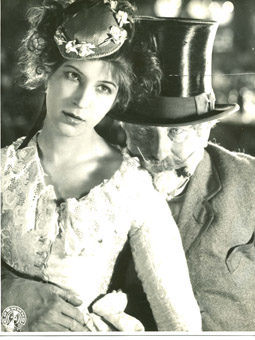
New Babylon
A GENEROUS, INSTRUCTIVE AND MOVING BONUS FOR SYDNEYSIDERS ENJOYING THE 2008 RUSSIAN RESURRECTION FILM FESTIVAL WAS THE SCREENING OF AN EXCELLENT PRINT OF THE 92 MINUTE SILENT FILM CLASSIC NEW BABYLON (1929), PROJECTED ONTO A LARGE SCREEN AND ACCOMPANIED BY THE ORIGINAL DIMITRI SHOSTAKOVICH SCORE PLAYED BY THE SBS YOUTH ORCHESTRA. IT WAS THE COMPOSER’S FIRST FULL-LENGTH SCORE AND HIS ONLY ONE FOR SILENT FILM. THE RESULTING JUXAPOSTION OF MUSIC AND IMAGE WAS REVELATORY, NOT LEAST IN THE COMPOSER’S RESTRAINT, LARGELY WORKING AGAINST THE COMPULSION TO LITERALISE OR, WHEN HE HAD TO, WORKING TO GLORIOUS EXCESS, MATCHING THE FILMMAKER’S MONTAGED DELIRIUM OF DECADENCE AND REVOLUTION.
Gregoriy Kozintsev and Leonid Trauberg’s New Babylon is endlessly inventive, always coherent and complexly empathetic despite a couple of stock class villains and predictable but brilliantly realised juxtapositions of war and shopping. Set during the Paris Commune of 1871, a young woman working in a luxurious department store, a crystalline palace, identifies with the city’s exploited workers, but her attention is increasingly drawn to a young soldier. Exhausted, empty of emotion, he seems a likely candidate for the cause but, despite his growing love for her and his own maltreatment at the hands of the bourgeosie, he remains on the side of the establishment, digging our heroine’s grave, by way of grim tribute, as she awaits peremptory execution in flooding rain. Throughout, the camera’s gaze allows us to read emotional subtleties in faces that underplay rather than overact, and there’s music in the very editing. The orchestra, conducted by Matthew Krel (who also played the piano passage in synch with the doomed musician on the onscreen commune barricade) rose to the occasion with a clarity and delicacy of playing that revealed in the score both the exuberance of the early Shostakovich symphonies and the austerity of the later.
The reception of the film and its music in 1929 was restrained, both regarded as ironic and intellectual, a taste of the brutal oppression of the arts to come in the 1930s. This Australian premiere screening of the film with live music provided clear evidence of the innovations and the nuances that Stalinism would not tolerate. The audience, many of them Russian-Australians, applauded this Soviet era classic fulsomely.
2008 Russian Resurrection Film Festival, New Babylon, directors Gregoriy Kozintsev, Leonid Trauberg, music Dmitri Shostakovich, conductor Matthew Krel, SBS Youth Orchestra, City Recital Hall, Sydney, Nov 9
RealTime issue #88 Dec-Jan 2008 pg. 23
© Keith Gallasch; for permission to reproduce apply to realtime@realtimearts.net
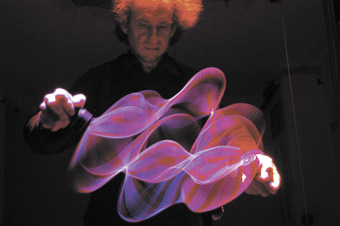
Wave Function (2007), Paul Friedlander
courtesy the artist
Wave Function (2007), Paul Friedlander
WONDER IS THAT AESTHETIC EXPERIENCE CHARACTERISED BY THE PLEASURE OF AMAZEMENT, ADMIRATION AND DELIGHT IN THE QUALITIES OF A THING, A FEELING OF THE FRESHNESS OF THE WORLD. RENÉ DESCARTES DESCRIBED IT IN HIS PASSIONS OF THE SOUL AS “A SUDDEN SURPRISE OF THE SOUL THAT BRINGS IT ABOUT THAT THE SOUL GOES ON TO CONSIDER WITH ATTENTION OBJECTS THAT ARE RARE AND EXTRAORDINARY TO IT…IT MAKES US LEARN AND RETAIN IN OUR MEMORY THINGS THAT UNTIL THEN WE WERE IGNORANT OF.” WONDER OFTEN HAS AT LEAST TWO MOMENTS, THE FIRST PLEASURE OF SURPRISE THAT IS MORE STRONGLY SOMATIC, IMMEDIATE AND UNREFLECTIVE—THE ‘AH!’ OF WONDER—AND THE SECOND THAT IS MORE STRONGLY INTELLECTUAL, THE DRIVE WITHIN WONDER TOWARD CURIOSITY, QUESTIONING AND THE SEARCH FOR EXPLANATION.
American philosopher Philip Fisher argues that wonder, or “the aestheticisation of delight”, is “the most neglected of primary aesthetic experiences within modernity”, a movement more often characterised in terms of the terror of the sublime. It is an aesthetic experience he (along with several other philosophers and art theorists in recent times) seeks to revalorise, for contrary to the sensations of privation and fear characterised by the sublime, in wonder the beholder’s perception is ego-transcending and unselfish, at times so struck by a thing’s originality that preconceptions or a definite goal or purpose fall away. In wonder, the world is seen as beautiful, cognition is more receptive, and the viewer is more open to new ideas.
I begin with this short (apparent) digression on the philosophy of wonder because it was my primary aesthetic experience on visiting the latest temporary exhibition in Madrid’s renowned museum of modern and contemporary art, the Centro de Arte Reina Sofia. Máquinas & Almas (Souls & Machines) may come packaged in rhetoric reminiscent of ‘new media’ technophilia of the 1990s—transformation, connectivity, interactivity—yet most of the works elude these curatorial constraints with élan, striking the viewer with a wonder that leads to an enlivened and broadened thinking about the world in general, not just the role of technology and its impact. And together with that broadened thinking comes a sense of genuine delight at the ingenuity and creativity of the makers (a feeling that does not mark one’s exit from an exhibition of contemporary art often enough!).
In a dim room, a round pool of dense black oil suddenly springs to life: conical bubbles surge in formation to the surface, rising to an implausible height, creating ambiguous impressions in constant movement: miniature cities, lunar landscapes, or microorganisms multiplying in agar. At first, wonderment triggers pleasurable flights of fancy, before pricking the curiosity and releasing the pleasure of intellectual inquiry: could the forms be caused by magnetic fields interacting with iron filings? Saciko Kodoma’s Protrude, Flow (2001-2008) is in fact one instance of a large body of work in which the artist uses computers to regulate the movement of metallic fluid—as in electronics and medical diagnostic tools—by magnetic forces. The viewers’ process of inquiry eventually leads them to realise that it is their voices and ambient noise that causes the fluids to change form. The work renders invisible digital networks tangible, imbricating the viewer in that network in a way that ultimately becomes comprehensible.
The subtlety of Kodoma’s interface and the work’s potent embodiment of digital networks in formal elegance are evident in a number of works here (no ‘drag and click’ anywhere, thankfully!). Daniel Rozin’s ‘mirror works’ recall the theatre warm-up game where one actor follows the actions of another as in a mirror reflection. However, standing opposite us is not another person but a mechanical ‘canvas’ composed of a formal amalgam of small parts that swivel and click into position to reflect our movements, not unlike stadium cards. That each part is a recognisable object in its own right, either a graphic disc, or, in Rozin’s most amusing kinetic sculpture Trash Mirror (2002-2008), individual pieces of rubbish picked up off a New York street, renders the canvas’ transformation into a screen even more astounding. The work offers a physical analogue of the pixel that helps the viewer cognise the ‘mysterious’ process of digital image making. The revelation of the intricate working mechanisms—a nest of wires and circuit boards encased in Perspex behind each piece transforms real time video into motion calibrated to a grey scale—doubles the delight the audience takes in playing ‘follow’ with what first appears to be an abstract painting. This play between mediums of representation—painting, photography, video and computer graphics—and their respective relationship to human subjectivity further enhances the viewer’s engagement with Rozin’s work.
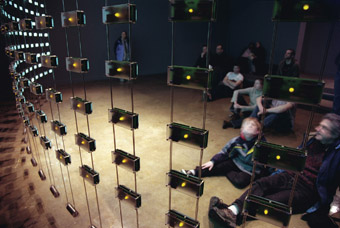
Listening Post (2006), Ben Rubin, Mark Hansen
courtesy the artists
Listening Post (2006), Ben Rubin, Mark Hansen
Yet another work that gives material presence to ‘immaterial’ computer networks—specifically social and communication networks—with humour and ingenuity is Ben Rubin and Mark Hansen’s Listening Post (2002-2006). A collaboration between an artist and a professor of statistics, this large-scale installation comprises several hundred LED panels that transmit in real time choice phrases from internet chat room conversations. As the panels flicker ‘Korea will be delt [stet] with by China and Russia I bet’, or ‘Toothless blonde, whoever you are, you made my day’, and a digitised HAL-like voice reads selections out loud, the viewer is literally immersed in the network, imparted with a physical sense of being inside other people’s intimate thoughts and desire to connect. Whether the exchanges be facile and banal, or poignant and revelatory, the installation presents their variety and density in such a manner as to inspire awe in human communication and imagination, and of course in the capacity of computer networks to facilitate this connectivity: this is truly a wonderful work.
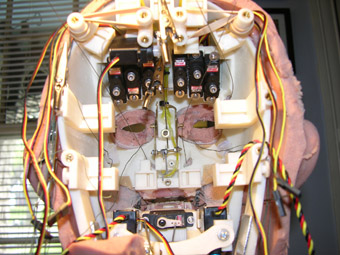
Song for Julio (2008), David Byrne, David Hanson
courtesy the artists
Song for Julio (2008), David Byrne, David Hanson
Philip Fisher’s treatise on wonder centres around the drive to explain that most wonderful of natural phenomena, the rainbow; it is the rainbow’s awe-inspiring beauty that sparks its investigation. This conjunction of scientific inquiry and aesthetics permeates this exhibition. Trained as an artist and a physicist, Paul Friedlander practiced for many years as a lighting designer for major theatrical events before devoting himself to art. His spectacular kinetic light installations (including Abstract Cosmology, 2008), where again a purportedly immaterial medium is rendered concrete, demonstrate the intricate links between these disparate discourses. Theo Jansen’s kinetic sculptures, such as Animaris Modularis (2008), also represent a cross-over between art and science: the artist builds animal-like structures from electrical ducting which are then ‘evolved’ into ‘intelligent’ creatures through a combination of computer programming and field testing (on the windy beaches of Holland). Musician and Renaissance man David Byrne lent his voice to robotics expert David Hanson’s sophisticated specimen to create an eerily ‘alive’ synthetic character, Julio (2008), who ahhs and umms, clears his throat, and looks self-consciously around before breaking into heart-felt song.
Thoughtfully and accessibly installed—the number of works is not overwhelming, there are beanbags to encourage longer contemplation, and the works are well-separated through lighting and screens—Souls & Machines brings together an exceptional selection of works that I would argue go beyond the ‘new media’ categorisation. Rather, the best works here spark wonder, leading the viewer from surprise, through to curiosity and understanding, not only about the impact of digital technologies but more broadly about the current nature of human perception, relationships and our being in the world.
Máquinas & Almas (Souls & Machines), curators Montxo Algora and Jose Luis de Vicente, artists Antoni Abad; David Byrne and David Hanson; Daniel Canogar; Vuk Cosic; Evru; Harun Farocki; Paul Friedlander; Pierre Huyghe; Theo Jansen; Natalie Jerimijenko and Angel Borrego; Sachiko Kodama; Rafael Lozano-Hemmer; John Maeda; Chico MacMurtie/Amorphic Robot Works; Antoni Muntadas; Daniel Rozin; Ben Rubin and Mark Hansen; Museo Nacional Centro de Arte Reina Sofia, Madrid, June-October
RealTime issue #88 Dec-Jan 2008 pg. 24
© Jacqueline Millner; for permission to reproduce apply to realtime@realtimearts.net

Earthstar (2008), David Haines and Joyce Hinterding
courtesy the artists
Earthstar (2008), David Haines and Joyce Hinterding
THERE’S QUITE A BIT OF HYPE COMING OUT OF BRISBANE’S GALLERY OF MODERN ART (GOMA) ABOUT THE PREMIER OF QUEENSLAND’S NATIONAL NEW MEDIA ART AWARD. NINE WORKS, 10 ARTISTS, $75K FOR THE WINNER AND A SWEET $25K TRAVELLING SCHOLARSHIP FOR SOME LUCKY EMERGING WORTHY AS WELL. GOOD MONEY IN THE CONTEXT OF AUSTRALIAN ART FUNDING. (THERE’S A LOT OF THESE PREMIER’S AWARDS FOR SOMETHING OR OTHER IN AUSTRALIA. PEOPLE OFTEN SLAG OFF AT POLITICIANS BUT YOU CAN’T DENY THE GENEROSITY. I THINK ANYBODY WHO FORKS OUT THEIR OWN MONEY LIKE THAT TO SUPPORT THE ARTS OR MEDICAL RESEARCH OR WHATEVER DESERVES THE BADGING RIGHTS. GOOD ON THEM.)
Anyway, into GOMA and up some stairs to the show. The space is smallish and dimly lit. Four of the works are in shared or open space and the five others are in rooms of their own—sort of. Sort of, as during the times I visited there was no sound dampening which meant that all the works shared the same soundtrack—a blend of the three loudest pieces and whatever sound (if any) they had of their own.
On to the show. Being new media there are a few projection/screen based works. The winning piece, Everything (see cover image), by Peter Alwast (it’s an acquisitive award so into the GOMA collection it goes) uses three large projections of what seem to be cut and spliced together clichés of digi-art animation. Shiny pipes, translucent shapes, clouds, mountains, CAD style building frames, lickable butterscotch cars, reflections into shiny domes to show off some projective geometry/linear algebra. Over the top runs a soundtrack that also seems to recycle the standards of collaged and cut-up sound, even down to the slightly manic sounding street preacher. (Subpsychotic street person rant = gritty urban equivalent of salt-of-the-earth charming peasant folk wisdom?) Overall, there’s an aura of slick and meaningless process, an empty consumption of surfaces that gets a bit creepy.
Another projection piece is CuteXDoom II from Anita Fontaine. Fontaine has used the Unreal game engine to build a simple race-against-time game. Basically you get poisoned and have to find a bunch of stuff and escape or die. The effect of the poison—a blurry sort of wooziness to the graphics is a nice touch. Modding Unreal levels is popular amongst gamer types—it’s a whole nerdy sub-culture—and I’m not sure where work like this fits—it doesn’t seem to function as game, as critique, or as resonant play.
Onward to the works with actual monitors. Sam Smith’s Control structure. A giant head—nicely tiled plywood facetted like a crude avatar—spills black plastic gunk onto the floor. From one eye protrudes a camera lens. Out the back of the head—reference occipital lobe for visual system—is more gunk and a flat panel with some animation/footage playing. Bits of static, some views of what looks like a control room, people about, two screens. Image of bloke with long shiny-rubber tubes coming from each eye and joining into a lens. It’s got an 80s Videodrome look about it. Critique-wise, the giant head is alone, the body is gone. Without the body, the brain is in a vat and all the inputs—digital or analog —are equivalent. Hence the head explodes and black gunk oozes out.
Near the entrance is Adam Nash’s Seventeen unsung songs, an installation for the online virtual space, Second Life. Nash has produced a typical 3D landscape to wander about in, and populated it with interactive virtual, and sculptural, sound devices—sound toys. Many of the sound toys can be manipulated real-time by the user. As a single user a virtual space like the slightly clunky Second Life cannot really provide the quality experience for interactive sound that dedicated software can, but it is as a multi-user opportunity that this sort of artwork potentially shines. It is also impossible for a gallery to guarantee a multi-user experience and so in some ways this means that the exhibited work is indicative of the possibilities of the real work rather than the real work itself.
John Tonkin provides an engaging interactive work: time and motion study v2. You enter a room with monitors on all four walls. One has a camera and mouse control. You put yourself in front of the camera and appear on the screen as a sequence of time lapse photos trailing off into the past—sort of 3D Muybridge with a little memory loss. The monitors on the other walls play back the past recordings of others who have used the work. It’s fun to use and, eventually, your time with it will enter into the database of previous visitors to be played for someone else.
Oottherongoo (your country) is a four-panel video by Julie Dowling. You sit on a bench, sounds above, screens in front, and watch what seems to be a home movie/audiovisual display split into four parallel image streams. There’s a journey to the bush, shots of the bitumen, some old family photos, some beautiful shots of a sun-bleached stock holding pen. A dry as a chip dingo strung up from a tree. A woman’s face looks out—a little tentative, later there’s a trace of tears and sadness.
Mari Velonaki’s Circle D: Fragile has two well crafted wooden boxes sitting next to each other on top of another, equally crafted, wooden stand. The boxes have matt screens on four sides where sentences will appear when you rotate or handle the boxes. This is quite a lovely piece although it can be hard to operate and get the full effect—but the nostalgia of the craftsmanship and materials, the apparent human agency in the way the text appears to be handwritten, and the need to hold the objects (to bring them closer as if accepting or caring), is quite poetic.
Next to Peter Alwast’s Everything is Natalie Jeremijenko’s eco installation Green Light, which functions both as an object and as a possible intervention into community energy use. Ferns in glass bowls hang like a nice display at a nursery or in some corporate space. The ferns are of a type that filters the air. Individual lights above each bowl funnel energy down from solar collectors on the roof. There’s a big X on the wall and a small video showing (somewhat obliquely) how the system might be installed in a domestic or small scale environment. Jeremijenko has produced a large body of exceptional work that functions across engineering, art and design. Green Light is more in the engineering design camp—lacking the symbolic moment that her piece Tree Logic has, where oak trees are suspended upside down to grow and bend up to the sunlight in a kind of aspirational tropism.
Finally, what for me was the best work in the show, David Haines and Joyce Hinterding’s Earthstar, which uses the tools of scientific investigation to create a poetic engagement with the Sun. Two tables sit in parallel at the centre of the room. On top lie large antennae—graphite rods bound with copper wire—and a bit of audio mixing gear, picking up and playing real time bursts of radio frequencies from the Sun. On the wall a large video projection of the solar chromosphere—a layer of super heated hydrogen only revealed though radical filtering of the image. Opposite the projection are two enclosed vessels, gorgeous refrigerators carefully holding something precious and fragile—molecular solutions designed as fragrances of the Sun. We can sample the smells using paper sample sticks held up to the nose—another gesture of approach.
The effect of the sound in Earthstar is to encourage close listening and contemplation. The video encourages a kind of awe at the astonishing power and immensity of the Sun. And the fragrances, bushfires and insecticide, ozone and coriander, free molecules brought into contact with the nasal epithelia, evoke the memory of touching a world that can only exist when it is itself in contact with the Sun.
Outside of the sophisticated poetry of the Haines and Hinterding piece the show is steady and a little safe. For me some works fit more into design or video, or lack the generative poetics of deep art. There is nothing that strikes me with the excitement or ambition of a work such as Kurt Hentschlager’s astonishing ZEE (Austria), which uses fog and stroboscopic light to induce overwhelming visual hallucinations, or has the smarts of Ruth Schnell’s Disappearence (Austria), which can only be seen by the peripheral vision, disappearing when looked at directly. Closer to home, how could an artist like Keith Armstrong not be represented—either with work such as Intimate transactions (as part of transmute collective) or Shifting intimacies (with Charlotte Vincent and Guy Webster)? If the award is to live up to the marketing hyperbole (“…some of the most exciting developments in contemporary art today”) a more adventurous and poetic selection is to be hoped for in the future.
Premier of Queensland’s National New Media Art Award, artists Peter Alwast, Julie Dowling, Anita Fontaine, David Haines and Joyce Hinterding, Natalie Jeremijenko, Adam Nash, Sam Smith, John Tonkin, Mari Velonaki, Gallery of Modern Art, Brisbane, Nov 1-Feb 8
RealTime issue #88 Dec-Jan 2008 pg. 27
© Greg Hooper; for permission to reproduce apply to realtime@realtimearts.net
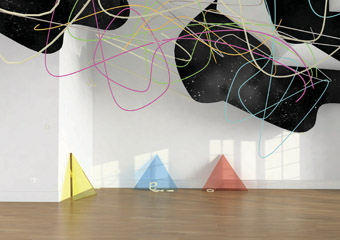
Peter Alwast, Everything, 2008,
courtesy the artist, Gallery Barry Keldoulis, Sydney.
Peter Alwast, Everything, 2008,
In a significant boost for new media arts, the Queensland Government, in partnership with the Gallery of Modern Art (GoMA), has instituted a major national prize of $75,000 for an Australian new media art work from a selected nine judged by Tony Ellwood, Director, Queensland Art Gallery; Melinda Rackham, Executive Director, Australian Network for Art and Technology; and Liz Hughes, Executive Director, Experimenta Media Arts.
The inaugural award was announced on October 31 by Premier Anna Bligh. The judges also highly commended the multi-media installation Earthstar 2008 by David Haines and Joyce Hinterding.
Melinda Rackham in her account of the selected works wrote, “The Premier’s Award recipient Peter Alwast’s 3D-rendered, visually luscious hyper-realistic space, titled Everything, utilises a multi-layered mashup aesthetic, inserting divergent source material seamlessly into a three channel video installation” (“Big Bang for Australian Media Arts”, ANAT Communications, email, Nov 11).
Not since the establishment of the $25,000 acquisitive biennial Ann Landa Award (the first award exhibition in Australia for moving image and new media work, inaugurated in 2005 and administered and shown by the Art Gallery of New South Wales) has there been an award that now ranks in value with prizes in literature and visual arts. It’s a timely ackowledgement for the whole new media arts field given difficulties artists have faced in recent years.
As well as the major prize there’s a $25,000 Premier’s New Media Art Scholarship for an emerging Queensland artist to travel and study. This was awarded to Leah Barclay, a Queensland Conservatorium of Music graduate whose “new media sound compositions draw on environmental and political themes.” Barclay is also co-director with Kayte New of the inaugural Ignition new media and film festival coming up in Noosa, May 2009.
New media arts is enjoying somewhat of a resurgence, if more evidently under the banner “media arts.” This new award for both established and emerging artists will give hope to the many artists who have dedicated themselves to the creative mastering of ever-mutating technologies. It’s good to see the Queensland Government leading the way in publicly acknowledging their skill, commitment and artistry. RT
On February 7, 2009, audiences in parts of regional Queensland can join finalist Adam Nash for a tour of his Seventeen unsung songs 2007 in the online environment of Second Life.
Premier of Queensland’s National New Media Art Award, GoMA, Nov 1-Feb 8
Peter Alwast is exhibiting at GBK gallery in Sydney, opening November 27; www.gbk.com.au.
RealTime issue #88 Dec-Jan 2008 pg. 25
© RealTime ; for permission to reproduce apply to realtime@realtimearts.net
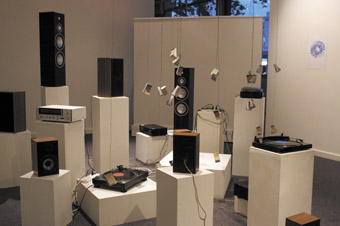
Lock Groove Flip Book Exhibition (Tape Projects)
photo Torunn Higgins
Lock Groove Flip Book Exhibition (Tape Projects)
ONCE, THIS WAS A FESTIVAL WHOSE NAME SUMMARISED IT NEATLY, AT LEAST IN MY RAPIDLY DECAYING MEMORY. ELECTROFRINGE WAS THE CROOK BETWEEN THE BURGEONING BRANCHES OF FRINGE DOOF CULTURE AND THE EMERGING ELECTRONIC ARTS. FLOCKS OF DARKWAVE CYBERPUNK FASHIONISTAS AND SQUAT ACTIVISTS GATHERED THERE. THE COIN IN TRADE WAS ESOTERIC SKILLS LEARNED ON THE KNEE OF EXPENSIVE AND TIME-CONSUMING EXPERIENCE BEYOND THE REACH OF THE OWNER’S MANUAL.
But these days everyone totes subscriptions to MAKE magazine and workshops in the ubiquitous Arduino microcontroller are regular in every major city…Locative art projects are a consumer commodity and major companies compete in elaborate excursions into augmented and virtual realities, and dance music seems to have fallen out of vogue as a vector of revolution since Australian Idol. The idea of turning up in person to learn how to get into the esoteric new media seems about as timely as taking a bachelor degree in alchemical transmutation of elements.
Electrofringe organisers Alex White, Elmar Trefz and Somaya Langley seem ready to ride the zeitgeist. The festival this year is exhaustingly diverse, with a line-up examining hybrid arts and fringe culture from all manner of unexpected angles. Technological art is no longer something held together with string scavenged from the dumpster and Japanese mail order—although Aras Vaichas gave an impressive workshop in building his Wävrüta digital effect unit from little more than that. Rather, the new media skillset is a commercially valuable commodity. Where Electrofringe is still fringey is in the collaborative, defiantly independent atmosphere it fosters.
I’m prepared to bet that by most plausible measures the technical sophistication of technology on display has decreased over time. The exception might be the online works—my favourite example of this is Pip Shea’s amusing interactive Neoconfessional, a hybrid online/video installation piece. Online, a standard social video sharing network collects uploaded footage of TINA’s compulsively boundary-testing punters admitting their trespasses into conservatism; offline, projectors and speakers in the performance venues toilets show those video clips and the stalls echo with a novel variety of public obscenity: “I don’t even like new media art.” In general, though, the shows this year have tended towards the technologically simple, and steered away from competing with the staunchly funded technological extravaganzas of your ISEAs and Biennales. Most of the successful works cluster around the ideas of the collaborative, the interactive, the site specific, and the low-budget.
The Tape Projects show certainly looks to an op-shop kind of electronics for its display, filling a gallery with flip book animations and turntables playing copies of a single locked-groove record through second-hand stereos, speakers arranged at random. The spartan presentation hides some sophisticated production; tracks on the disc include dozens of micro-compositions from as many luminary composers jumbled together with little to identify them to the listener (although the flip books have front-page credits). Punters lower the tonearm at whim and find themselves participants in a centreless, endless performance of phasing sound. I’ll admit I am unnecessarily fond of multi-speaker installations, but this is quite something. The gallery space sports a handful of listeners seated on the floor transfixed—I can’t recall the last time I saw that outside of a performance.
The League of Imaginary Scientists have a handmade aesthetic, but with a chaotic flavour; in labcoats and glasses they distribute parodical school kid activity packs filled with bits of simple cardboard and lenses and invite you to stake out real estate space with the telescope you make from the parts. There’s some dance and a bit of live video too, so that we can call it new media art, but it hinges upon the engaging personalities of the performers more than any technology. Indeed, at their artist talk at DORKBOT/Sydney the preceding week, they left the audience dumbfounded by the absence of technological obscurity behind the presentation. Their subject matter is inversion of space and time: riding a bike back into your childhood, passing objects through a video camera, colonising the stars with cardboard and plastic because the planet is doomed. It’s the most cheerful investigation of our dire planetary circumstances that I can imagine, pulling at least a wry utopianism out of our scientifically projected apocalypse.
At the other end of the technological spectrum, the intricate algorithmic stylings of the Advanced Beauty show were getting a lot of media anticipation. Projected on the wall of the John Paynter Gallery for a two-week season overlapping the festival proper, this is a series of algorithmic single-channel video pieces exploring ideas of synaesthesia, and the algorithmic cogeneration of sound and visuals. But if that experience is to even start to approach the totality that synaesthesia implies, it is worth sticking to the surround-sound cinema screening (which sadly I missed). Otherwise, you may as well watch it at your leisure on the web.
By contrast, across the hallway from the gallery in the old gaol museum, Fiona McGregor stages You Have The Body, a site-specific one-on-one durational performance. It’s a didactic endurance piece, which is to say: precisely what I would avoid seeing if I had read about it. In the flesh it’s totally engrossing. You are led into the venue bound, with a bag over your head, and drawn through a weird transmutation of the gallery-going experience into an Orwellian abduction. McGregor’s attention to detail makes this a formidable piece, a pastiche of totalitarian horror and Australian bureaucratic mundanity. I won’t divulge the whole piece, mind, since that’s half the point of the experience, and performances are ongoing.
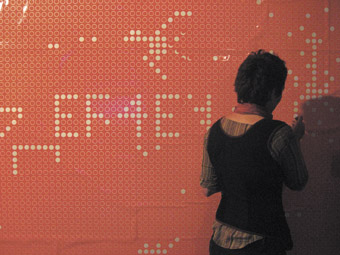
TheGreenEyl, Electrofringe 2008
photo Somaya Langley
TheGreenEyl, Electrofringe 2008
Back in the Paynter Gallery, Sengewald’s interactive video works arrest a few of us—an interactive video projection appends shadow tails to gallery visitors and places them amidst a swarm of rats that flee from their outline. However, the simplest and most interactive of all, by my statistically questionable 10 minute survey of the space is German collective TheGreenEyl who’ve covered a gallery wall with removable orange stickers and invited the public to do what they will with them in a work they call Appeel. The name is a low point, but the work is better—the negative space left by the absent stickers leaves a fascinating trace as much as do the orange dots that soon adorn every sufficiently slow-moving dry surface in the city. The evolving, democratic, negative image in the gallery is satisfying; but so is the sporulation of dots across the city as gallery-goers become willing dispersers to the day-glo seed; and later on new orange sticker walls germinate across the city, until my sleeves come away fluorescent from the table at the festival club.
Between Birchville Cat Motel (NZ), KK NULL (Japan) and Maruosa (Japan) there is a multicoloured bouquet of noise musics, worth hearing indeed but less interesting to write about. (“Loud!”) RAVENATION though, is a performance worth detailing—worth, even getting thrown out of for disorderly behaviour and sneaking back in over the beergarden fence. Curated by Melbourne performance collective Gooey On the Inside, the show assembles a kind of mocking electro cabaret that veers between deft satire and simple mockery but mostly hangs out in the vicinity of general mayhem.
Half a generation since the festival was founded, Electrofringe’s early days are already fodder for (re)appropriation by the young turks as much as the pop culture canon; everything from breakcore to cabaret is compressed in RAVENATION into a parodical three hour hyper-rave with smoke machine, lasers and fake MDMA included, not to mention an animatronic latex penis mask, all broadcast in animated GIF art on Myspace. These folks are not just staking out a claim for their area of practice on the fringes of the mainstream, but wresting it back from the ageing cohort who now run the flagship, and producing an impressively slick show while they’re at it.
Programming touring international artists is fantastic for Electrofringe’s profile; but it’s the ability to invite the cream of troublemakers into the halls of marginally-more-power that keep it alive and relevant. I can’t wait until Gooey on the Inside get their comeuppance in turn in a few years’ time.
Electrofringe, This Is Not Art, 2008, Newcastle, Oct 2-6, www.electrofringe.net
RealTime issue #88 Dec-Jan 2008 pg. 26
© Dan MacKinlay; for permission to reproduce apply to realtime@realtimearts.net
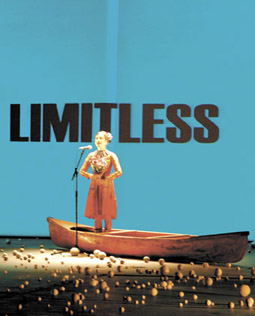
Willoh S Weiland, Yelling at the Stars
photo Tilly Morris
Willoh S Weiland, Yelling at the Stars
AUSTRALIA’S FIRST INTERSTELLAR MESSAGE WAS TRANSMITTED LIVE FROM MELBOURNE’S SIDNEY MYER MUSIC BOWL ON MAY 31 2008, THE CLOSING NIGHT OF THE NEXT WAVE FESTIVAL. THE MESSAGE WAS AUDIO RECORDED AND FILMED, STREAMED ONTO THE WEB AND TRANSMITTED BY DEEP SPACE COMMUNICATIONS NETWORK (FLORIDA) INTO OUTER SPACE UP TO THREE LIGHT YEARS AWAY. THE NATURE AND CONTENT OF THE MESSAGE WERE UNPRECEDENTED IN THE HISTORY OF INTERSTELLAR MESSAGING.
A crowd of 500 gathered under the Autumn night sky to witness the event, which was stylishly introduced by Anton Enus, best-known as a presenter for SBS Television’s World News Australia. The message itself was delivered as a highly subjective letter of approach from Earth; a funny, tender and musical appeal to whatever extra-terrestrial other—or others—might, somehow, be capable of responding. It was created by an artistic team led by writer and performer Willoh S Weiland.
The Music Bowl event was one performative facet of Yelling at Stars, a project of sustained, collaborative enquiry focused on interstellar communication. October 2008 marked a new phase of development for the project: Weiland and researcher Nicky Forster presented Yelling at Stars in Glasgow, at Less Remote (www.lessremote.org), an international forum for cross-disciplinary dialogue about the future of space exploration. Less Remote ran parallel with the 59th International Astronautical Congress (IAC) and, during both events, Yelling at Stars was meanwhile seen in Glasgow as a “performance research installation” at the Centre for Contemporary Art. In anticipation of the UN International Year of Astronomy in 2009, Weiland told me the following about the experience of Yelling at Stars so far, and its evolving scope.
feeling the void
“Speaking for the interstellar transmission was very different from any other performance experience I’ve had. It was like feeling the void a little bit. The sensation was wonderful, but it was a big responsibility to be articulate. I’d been carrying a hope that people would connect with a sense of the impossibility of looking for an answer in the vastness of space. The joyous laughter from the audience was a relief. I was hoping that the large frame of the Music Bowl would hold, would allow the small person to be real, and it worked. I wore a bright orange dress, gumboots and a necklace of pegs. I stood in a simple wooden canoe holding a posy of blue roses, and the canoe was surrounded by a landscape of spheres—our own constellation in close-up. It wasn’t spectacular. It was really, really simple, the simplest thing I’ve ever done, which is hilarious.
“It seems strange calling the message a ‘script’ because I didn’t want to speak on behalf of anyone else in the world. There was nothing in the text of the message that isn’t true, that I haven’t experienced directly, or that one of the members of the Yelling at Stars team hasn’t experienced. In the performance I had to try to say everything as if it was real, not acted, so it felt very vulnerable. ‘I don’t know how long we should keep talking before we let the silence be an answer’—that’s one of the lines that gives a sense of the message. Probably if I were a dancer, I would have danced the transmission, but my background is in poetry, and poetry is integral to my sensibility. The spoken language was always heard in relationship to Pip Norman’s sound design; my voice and his music were structured together, as a conversation, artistically encoded.
“The theories, history and issues surrounding interstellar messaging are immense. From the beginning I wanted to keep informing myself, and wanted the audience for the transmission to be informed. I started collaborating with Nicky Forster, who’s a cultural geographer, trained in looking at the wider human context. She worked on generating the information for phase one of the project, the Yelling at Stars website. We come from different backgrounds, but our similar goal is to maintain the integrity of the science.
“Christopher Fluke, at Swinburne University, was our astronomy consultant for the live transmission. He made us aware that the act of sending a message is highly controversial. He drew our attention to the debate that’s been taking place in the astronomical community about ‘who has the right to speak for Earth?’—and to the SETI Institute’s guidelines on interstellar messaging. Then he helped us crunch all the numbers to work out how the message would be sent; explained the scientific detail. He has a deep belief in the arts, yet the performance was very exciting for him as a scientist, in terms of astronomy outreach: all of a sudden, at a hybrid contemporary arts festival in Melbourne, people were engaging with astronomy because of the show.
“The first motivation for Yelling at Stars came from a kind of disordered fact: reading, via Google, that television transmissions are going into space all the time, and that the American sitcom I Love Lucy was one of the first transmissions sent. My response was, ‘I don’t want to be represented to space as a dumb redhead!’ I studied what I could find of the sent messages: they’re dominated by a white, male, post-Enlightenment, positivist agenda which assumes that the world can be categorised into facts, facts that in turn can be condensed and therefore interpreted in a certain way.
“Whether sent out with the Pioneer spacecraft, or as equations via radio waves, the messages really make no attempt to convey the plurality, chaos and poeticism of existence. And because they’re transformed into code, they’re also dominated by issues of translatability. So they seem to magnify problems of representation that I encounter on this planet all the time. And if the human desire to communicate with outer space is based on an authentic desire to share knowledge, then presenting ourselves as a well-adjusted bunch of geniuses won’t start an honest dialogue.”
being part of the conversation
“From the IAC in Glasgow my impressions are that on the surface, the aesthetic of space industry culture—from NASA down to the satellite manufacturers—is the same as it appears in the footage of the moon landing; still very much like ‘men going forward to plant the flag.’ …[T]he capacity to have a space program is dominated by appearances of military strength, which is the domain of men.
“The IAC was an environment where discussion focused on the possible colonisation of space, the potential to live on other planets, commercial spaceflight and so on. These are missions that are being actively pursued. As an artist and a woman my concern is whether the discussion and the ventures are going to be dominated by the same paradigms that have failed here on Earth. The cultural utilisation of space, and conversation around avoiding the mistakes that we’ve made here on Earth, are particularly areas that the arts and humanities are able to contribute to. This is what Less Remote was about.
“On an artistic level the use of the personal and the poetic in composing the Yelling at Stars transmission was an attempt to give weight to information that has historically been maligned as feminine, and therefore unworthy of dialogue—especially within the scientific community. That’s the interest for me; to try to hold this ‘other’ information, this mode of awareness, and have the scale of importance of different knowledges a little bit readjusted.
“Yelling at Stars is proving the most creatively satisfying project that I’ve undertaken. The outcomes have integrated the research and the artistic elements—made them inseparable. And the ongoing research has been quite a revelation in terms of the way I work. Being ‘part of the conversation’ in Glasgow has brought up half-forgotten ideas about activism and art; about getting involved in the dialogue, not just reflecting.
“In 2009 Nicky Forster and I will take up a three-month Synapse residency at the Swinburne University Centre for Astrophysics. So the project has opened up for me a wider sense of artistic responsibility to start engaging with this kind of institution, to try to find new ways into these places, so we can help translate what they are into the world.”
the drake equation
“Since presenting Yelling at Stars in Glasgow I’ve started to find the question of an ‘ideal listener’ in outer space more and more amusing. I love to imagine that we might burst through some Truman Show-type barrier, and there’s heaven, or that it’s populated by ghosts—which are, of course, very human ideas. I do think that extra-terrestrial life exists, and my thinking’s been buoyed by overhearing an astronomer saying at Less Remote, ‘Oh, life on other planets will be discovered within 50 years.’
“Back in 1960 Dr Frank Drake, one of the pioneers of radio astronomy and a founder of SETI, proposed the following equation: the number of detectable civilisations in space equals the average rate of star formation x the fraction of those stars with planets x the average number of those planets that are habitable x the fraction of those habitable planets where life actually emerges x the fraction of that life that is intelligent x the fraction of that intelligent life that becomes capable of interstellar signalling x the length of time that those signals remain detectible.
…Don’t wait by the phone! But you know, I believe absolutely in the unexpected. JM Coetzee’s Elizabeth Costello [in the novel of the same name] defines herself as ‘a secretary of the invisible.’ Maybe I’ll try for ‘a secretary of the impossible’.”
Yelling at the Stars, project director, writer, performer Willoh S Weiland, research writer, audio documentary Nicky Forster, spoken message introduction Anton Enus, composer, sound designer Pip Norman, video/web Andrew Fraser, Monki Web Design; www.yellingatstars.com; http://www.cca-glasgow.com/; www.seti.org
RealTime issue #88 Dec-Jan 2008 pg. 27
© Cynthia Troup; for permission to reproduce apply to realtime@realtimearts.net

























































































